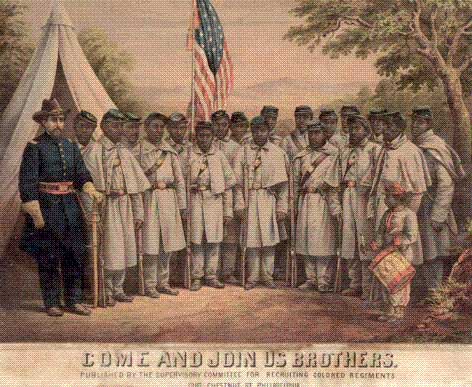WINSLOW, CLEVELAND (1836-1864). Colonel, 5th New York Infantry; 5th New York Veteran Infantry. Born in Medford, Massachusetts, he received a college education, worked as a merchant and served seven years in the 71st New York National Guard. A resident of Middleton, Staten Island, he enlisted in the 5th as one of its original captains. In Virginia, he led Company K at Big Bethel, was in charge at Hanover Courthouse, distinguished himself at Gaines’ Mill, commanded skirmishers at Malvern Hill, and led the 5th at Manassas Plains, where his horse was killed by seven bullets.
Civil War Bio Search
In addition, he was the major in command of the 5th at Antietam, Maryland. Promoted to colonel in 1862, he led the 5th at Groveton (as part of the Battle of Second Bull Run, Virginia). It was there that his regiment, in ten minutes, lost 297 men, including 124 killed, the greatest number of fatalities of any regiment during the Civil War. At times he commanded Sykes’ Division and a brigade. He was known as a flamboyant leader and a stern disciplinarian. On February 1, 1863, he wrote this report that is a history of the regiment:
Sir –
In compliance with circular from General Head Quarters, State of New York, Adjutant Generals Office, December 2nd, 1862 requesting a concise statement of the leading facts in the Military history of this Regiment since its entry into the service. The actions which it has taken part and the names of Officers and Privates who have particularly distinguished themselves, I have the honor to report as follows –
I – the 5th regiment New York State Volunteers was organized in NYC under the auspices of Col. Abram Duryée in April 1861 – was sworn into the State Service and transported to Fort Schuyler, NY on the 23rd of April 1861. Recruiting for the regiment was conducted by Major Davies in NY – and the ranks were rapidly filled. On the 9th of May 1861 the regiment was mustered into the service of the US for two years – by Capt. Seymour U.S. Army.
On the 23rd of May having been recruited to nearly 800 strong, and having had considerable practice in drill under competent officers the regiment left Ft. Schuyler, NY in steamboats and landed at the foot of 14th St. East River marching from thence to the foot of North Moore St. embarking same day on board the Steamship Alabama for Fortress Monroe arriving there the 26th day of May 1861 landed the troops and went into bivouack (sic) on the farm of Col Segar. Established camp next day called Camp Butler and subsequently changed to Camp Hamilton.
II- The regiment was employed making reconnaissances, scouting, etc, until the night of June 9th, 1861 when we marched from Camp at 10 o’clock p.m. on the road to Big Bethel reaching Little Bethel before daybreak driving in the Picket of the enemy and capturing the officer in command of the Rebel Picket Guard. In consequence of heavy firing in the rear marched back five miles __________the cause to be two of our own Regiments 3rd and 7th NY Vols. who were firing into each other by mistake – marched back to Big Bethel and engaged the enemy in front of their works, after being exposed to a hot fire for about two hours with but little opportunity from our position to return it effectively, losing 7 enlisted men killed, 12 wounded and 2 officers wounded, marched back to Camp, arriving there early in the evening of same day, for the ______loss of the first Battle of the War, the names of the officers and privates distinguishing themselves, etc. – I respectfully refer you to the Official report furnished you by Col Duryee when in command (as the report is stored with many other papers of the regiment in Baltimore, I cannot furnish you with a copy) –
III- The regiment remained at Camp Hamilton until July 1861 then embarked from Fortress Monroe on board the steamer Adelaide for Baltimore, arriving there next day, relieving the 18th regiment Penn. Vols. then on duty at Federal Hill.
At that time our position was not considered a sufficiently strong one as the element of Secession was not ___eminent throughout the City of Baltimore it was therefore suggested by Lt. Col. G.K. Warren (also Lt. for Engineers U.S. Army) that our camp should be fortified. The proposition was favorably received the War Dept. and the work was begun under the direction of Col. Warren on the 25th day of August 1861 which resulted in the structure of one of the strongest and handsomest earthworks built during the war. – The work stands upon a mound near the Centre of Baltimore and near the water, 82 feet high from tide water and enclose an area of seven acres, it comprises five Bastion, four elevated and one with subterranean passage with three bomb proof magazines. The parapet are mounted by six 8 inch Columbiads-fifteen 42 pounder smooth bore – twenty 32 pounder smooth bore and five 24 pounder flank howitzers, also two light 6 pound field guns and five 10 inch mortars were mounted within the Bastions. These guns range upon every point on the compass, completely commanding the City. A well was dug within the enclosure supplying good water, sufficient for a garrison of a thousand men. Almost the entire works was performed by the men of this regt. and under charge of the Company Officers, the bastions and curtains enclosing the fort was completed and the interior graded and drained by the 29th day of October-after which the guns and flank howitzers were put in position and the ammunition placed in the magazines.
Col. Abram Duryée was promoted Brig. General of Volunteers Sept 4, 1861 and was succeeded by Lt Col. G.K. Warren to the command of the Regiment. The regiment remained in tents until the 5th day of January at which time the Barracks were completed and the Fort named Fort Federal Hill. On the 12th day of November 1861, six companies, A, B, C, E, F, I, under command of Col. G.K. Warren embarked on the steamboat Pocahontas and landed at Newtown on the eastern shore of Maryland, joined the troops under the command of General Lockwood, marched from Newtown to Oak Hall 16 miles. Encamped until the 20th at Mappsville 8 miles and next day marched to near Drummondstown 24 miles. Nov 22nd marched 16 miles and encamped hear Hadlocktown. Nov 24th marched to near Eastville 12 miles and encamped until December 3rd, marched to Pongateague 30 miles. Embarked next day on steamer Starr and arrived at Fort Federal Hill December 5th. During this campaign the enemy numbering about 6 or 7,000 evacuated their bastions as our troops advanced – General ______ and a quantity of large guns and small arms were captured by the 5th regiment. No attempt was made to arrest the progress of our march with the exception of placing obstructions in the roads &c.
The four companies remaining at the Fort under command of Major Hull began the carpenter work on the Officer’s quarters and men’s barracks which consisted of three buildings, one 195 Ft long 24 feet wide with Piazza 3 ft wide along the front, two stories high divided into 3 rooms, one on each floor, each 65ft long, the Building accommodating 600 men – One 181 ft long 24 ft wide two stories high, piazza along the front divided into eight rooms – two on each floor 65 feet long and two rooms on each end -25 ft long for kitchens and Band, the building accommodating 400 men. One building 195 ft long 20 ft wide and two stories high divided into 10 rooms on each floor. Each 16 x 20 ft long for officers’ quarters. These buildings were of the most substantial kind being of wood filled in with brick. Stables, QM store house, guard house, Tool House and ordinance Building were also built. Their work was done entirely by the men of the Regiment and completed in the early part of February. The regiment was made perfectly conversant with the light and heavy artillery drill, the manufacture of fixed ammunition, the care of siege and field guns, Light Infantry Rifle drill and the perfect use of Bayonet. A school was established for the instruction of Officers and non-commissioned officers and recitations were had daily in Infantry, Heavy and Light Artillery tactics, Bayonet exercise, discipline of troops, duty in garrison and revised army regulations. Company & battalion drills were had daily and at the time of the departure of the regiment for the Peninsula no troops could be better disciplined or more fully prepared for an active campaign. On the 19th of February 1862 four companies B, C, G & H were stationed at Fort Marshall, opposite Fort McHenry where they remained until the 26th day of March – then returning to Federal Hill.
On the 30th of March 1862, the regiment embarked on board the steamship “S.R. Spaulding” for the Peninsula, Va. arrived at Fortress Monroe on the morning of the 31st, disembarked and joined the Brigade of Regular Infantry under the command of General Sykes – Marched up the Peninsula and went into camp near Yorktown, Va. the 11th April 1862, a distance of 31 miles. The regiment was prominently engaged at the Siege of Yorktown and was assigned duty as siege artillerists erecting batteries, unloading transports and transporting and mounting the siege guns and mortars, manning and working the batteries for which service and coolness under heavy fire of the rebel guns, the regiment was complimented in orders by General Barry, Chief of artillery.
After the evacuation of Yorktown, marched on May 9th, 1862 with the army towards Richmond and on 24th May 1862 encamped at old Church, Va. a distance 82 miles. May 26th Companies A, H G & I left camp and marched 8 miles to the Pamunkey River, destroyed the bridge over the river and thus cutting the communication of the enemy.
May 27th the regiment marched at 6 a.m. 12 miles to Hanover Court House, Va. Participating in that engagement, occupied the next day following the enemy and capturing a number of prisoners, arms, & c. May 29th made a reconnaissance under Colonel Warren to Ashland capturing a number of prisoners and returned to camp at Old Church same night. May 31st marched to camp near New Bridge, Va.
Left camp on the 13th June in pursuit of the rebel General Stewart who was reported as making a raid in our rear, marching to near Old Church bivouacked until 4th o’clock a.m. continued the march Tunstall Station arriving there a few hours after the enemy but too late to capture or prevent the burning and destroying of the road and buildings. The weather was exceedingly hot, the thermometer standing at 108 degrees and as it is impossible for Infantry to overtake Cavalry by following after them and on the same road, the men became completely exhausted as the march of 41 miles had been a forced one and very little water could be found, consequently the suffering was very severe.
Returning to camp at New bridge the regiment was occupied in picket duty on the Chickahominey and working on the different bridges and batteries, until the 26th June when we marched towards Mechanicsville and remained in line of battle all night. June 27th fell back to Gaines Mills, Va. and remained in position until attacked by the enemy at noon. The Regiment was on the field and engaged with enemy until 8 o’clock p.m. who were successfully repulsed and driven from the field three different times at the point of the bayonet which honor I am sorry to see by the papers has been claimed by troops who were not within sight of battle. Our loss in killed was one officer and 37 enlisted men. – Wounded, 4 officers and 106 enlisted men. 14 missing nearly all of whom were supposed to be wounded and taken prisoner. The officers and men all behaved with coolness and bravery – I will not incorporate in this a repetition of Lt. Col. Duryea’s official report (see report attached). Crossed the Chickahominey same night and remained on guard at the river until 6 p.m. the following day, the marching all night passing through White Oak Swamp and at daylight reaching Charles City Cross Roads, taking up position in line of battle holding possession of the road to enable our army to complete the crossing of the swamp. When relieved by General Kearney’s Division next morning marched to Malvern Hill and posted the regiment on picket on the river road guarding the approach from Richmond. – Next day July 1st, 1862 the regt. was engaged in the battle of Malvern Hill, maintaining our picket at night. July 2nd withdrew from picket and covered the rear of the army. – On the march to Harrison’s Landing which place we reached in the afternoon same day. The Officers and men behaved with wonderful presence of mind under the heavy fire to which they had been exposed for so many days and considering the excitement, want of rest and food, of which they had been deprived for five days and nights, making long and forced marches of 30 miles through heavy and crowded roads and in a heavy rain storm, still a spirit of cheerfulness and perfect confidence was felt by all and to this I attribute the comparatively few cases of sickness after reaching our camp at Harrison’s Landing.
While encamped at Harrison’s Landing continued to drill the Battalion and instruct those officers promoted from the ranks in place of those killed and resigned. Lt. Col. Duryea having returned North on sick leave and Major Hull having been ordered on recruiting service the command of the regt. was left to Captain Winslow. August 14th moved our position to Harrison’s Landing and marched to Newport News, Va., a distance of 64 miles.
August 20th embarked on Steamship “Cahawba” for Aquia Creek, arriving there proceeded by railroad to Falmouth Station and bivouacked. August 23rd commenced the march towards Manassas proceeding along the Rappahannock, reached Warrenton junction on the 24th of August 1862 thence to Manassas Junction. The regiment numbered at this time 490 effective men. August 30th at daylight marched to Bull Run and participated in the engagement at one p.m. losing officers killed 3, wounded 7, enlisted men killed 75, wounded 152, and missing 63, nearly all of whom were supposed to be wounded and taken prisoner as we wee obliged to abandon the field.
At this battle the regiment was supporting three field batteries all of which were safely taken off the field before the regt. retired. Both Color Sergeant and the entire guard were killed in protecting the Color which were safely brought off (attached see Captain Winslow’s Official report) at dark marched to Centreville and bivouacked, remained at Centreville till 12 p.m. Sept. 1st leaving with the rear guard. – Sept. 2nd marched all day until 11 p.m. encamped at Halls hill in front of Washington – Sept.6th marched at 9 o’clock p.m. Tenallytown, Md. And proceeded with the army of the Potomac pursuing the enemy to Antietam Creek reaching that place in the evening of Sept. 15th – Sept.17th, at the battle of Antietam the regiment was engaged in supporting different batteries in the action. Sept. 19th followed the retreating rebel army to the Potomac when we remained on picket all night guarding Blackford’s Ford. Sept. 20th crossed the Potomac in line of battle as the enemy were in large force, recrossed immediately losing one sergeant wounded. Remained on picket on the North bank of the river until the morning of Sept.22 when I moved the regt. back half a mile and encamped near Sharpsburg, Md.- at this camp the recruits enlisted to take the places of those lost in battle and died of disease, were subjected to a thorough course of drill, the new men were of a superior class to those generally enlisting in the army. Sept. 30th, 1862 Colonel Warren was promoted to Brigadier General of Vols. and Lt. Col. Duryea promoted Colonel vice Warren.
On the 30th Oct. 1862, the regiment marched with the division to Harper’s Ferry, crossing into Loundon Valley and reaching Snicker’s Gap on Nov. 2, 1862. remained there on picket until the morning of Nov. 6th when we marched to Warrenton, encamped there 7 days and continued the march to near Falmouth, Va. encamped there Dec.11th.
On the 13th Dec. moved out of Camp going into position opposite Fredericksburg, remained in line of battle until the next day, then crossed the river passing through the city, formed in line of battle on the outskirts in front of the enemy’s works, remained in line of battle all night, most of the time under the fire of artillery and sharpshooters, losing two men wounded, at daylight moved into the city and placed the men under cover, remained under arms all day. That night and the next day going at night to the front on picket guard, posting two companies within 50 feet of the enemy’s works, the balance of the regt. worked all night building rifle pits to protect themselves from the shell of the enemy. Remained in there pits until 8 a.m. being among the last troops left on that side of the river, the balance of the army having crossed during the night. The entire regt. crossed without loss of a man and without the knowledge of the enemy, who continued fire at the objects we have placed in the rifle pits, until after the regt. had recrossed and the bridges removed, the 17th returned near Falmouth at which place the regt. was encamped. On Dec 4th, 1862, Col. Abram Duryée resigned by reason of sickness and Major Winslow promoted to fill the vacancy. The efficiency and discipline of both officers and men of this regt. is due to the untiring efforts and constant attention of Col. G.K. Warren.
Throughout the entire campaign of the Peninsula and in Maryland he has proved himself to be an officer of superior military talent, his coolness and bravery on the different battle fields has won for him perfect confidence of his officers and men. All promotions have been made for gallant conduct under fire, therefore prefer not particularly mentioning the names of officers or soldiers who may have distinguished themselves, as with few exceptions all have acted in the parts assigned them with honor to themselves and credit to their Regt.
General George Sykes said of the 5th New York, also known as Duryée’s Zouaves (for the famed French legion), “I doubt whether it had an equal, and certainly no superior among all the regiments of the Army of the Potomac.”
Winslow was appointed colonel of the 5th Veterans on May 25, 1863, and worked tirelessly to raise the Veterans regiment. While he was recruiting in New York City, the Draft Riots broke out. Winslow issued a call in newspapers for his veterans and citizen volunteers, organized them the next morning with some soldiers and took on the mob with howitzers and artillery firing canister. One veteran, a member of the mob wearing a 5th fez and carrying a Sharps rifle, tried to shoot Winslow off of his horse; he missed and hit Winslow’s horse, and was then shot down by a sergeant. Winslow repeatedly ordered canister and rifle volleys after his men were surrounded by the mob. Upon organizing the 5th Veterans, he enrolled himself on October 25 and mustered in as lieutenant colonel that date. Severely wounded in the left shoulder on June 2, 1864, at Bethesda Church, Virginia, Winslow had surgeons clean his wound and place his arm in a sling, then returned to the battle. As he grew weaker from loss of blood, he was ordered to the rear. His father, Gordon Winslow Sr. (see), who served as a chaplain with the 5th and 5th New York Veterans, found his son in the cellar of a house that was being shelled and accompanied him until they found a hospital, eventually staying overnight at the 6th Corps Hospital.
Gordon Winslow wrote, “…the wound was much inflamed by his return to the field. He passed the night comfortably; I slept on the floor under the same fly.” Traveling together on the transport ship Mary Ripley, Gordon Winslow threw a bucket overboard to get water for his horse. He apparently was pulled into the Potomac River, never to be seen again. Cleveland Winslow died of his wound on July 7, 1864, at Mansion House Hospital, Alexandria, Virginia, and was interred in Green-Wood on July 10. His brother, Gordon Jr. (see), also served in the 5th New York Veterans. Cleveland Winslow last resided in Staten Island. Section 11, lot 3909.
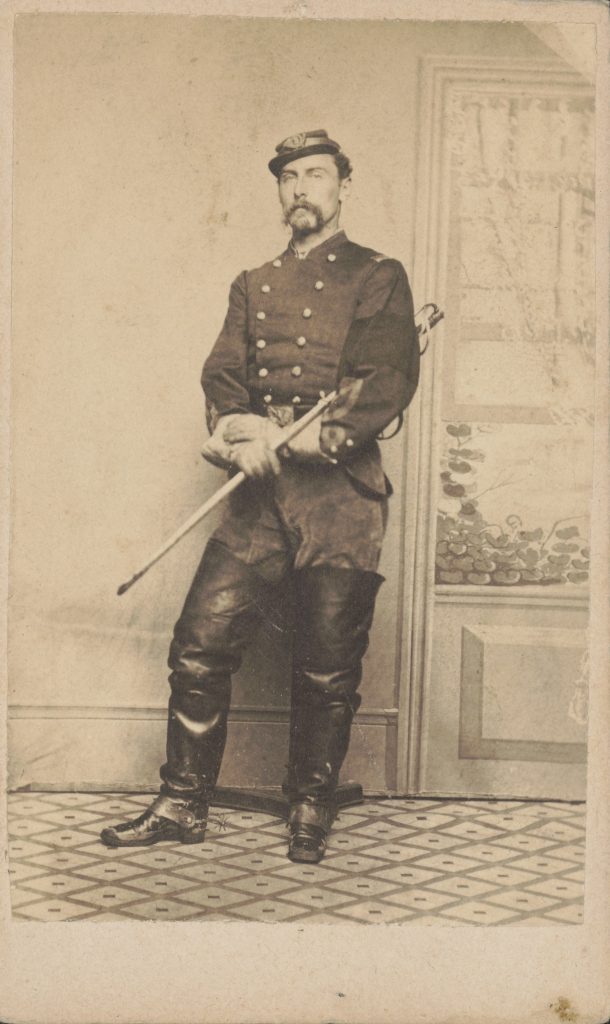
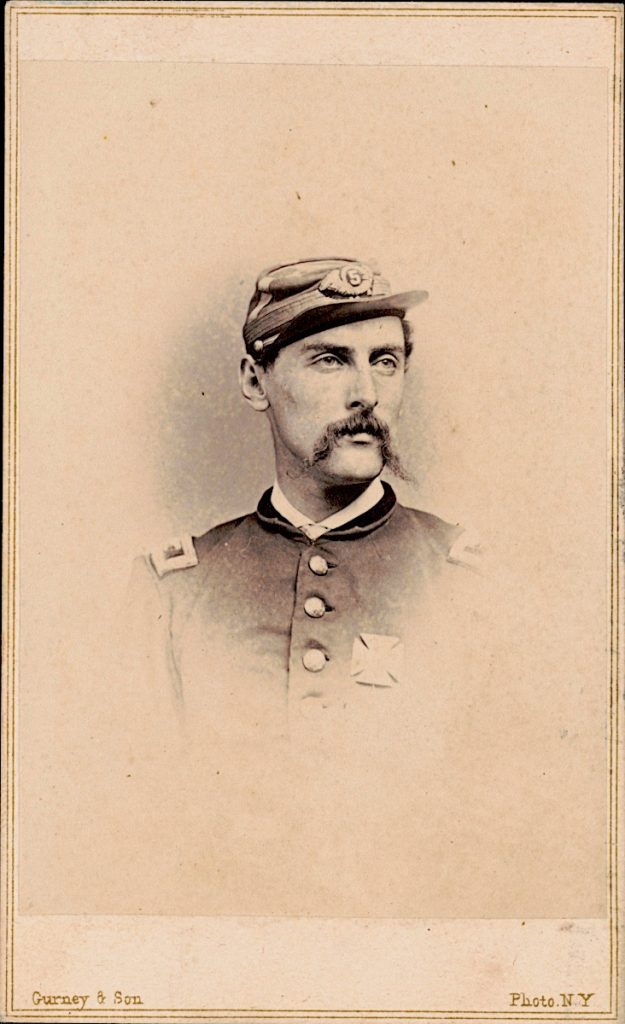
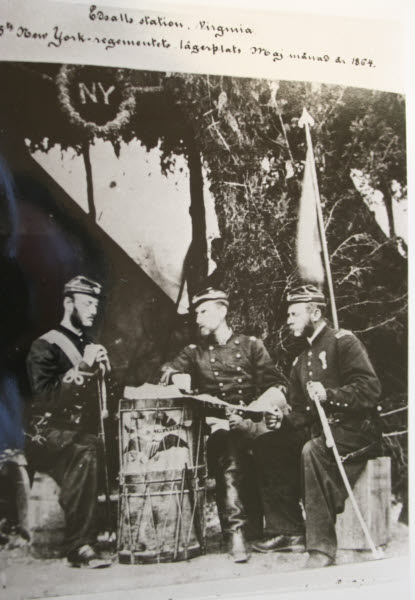
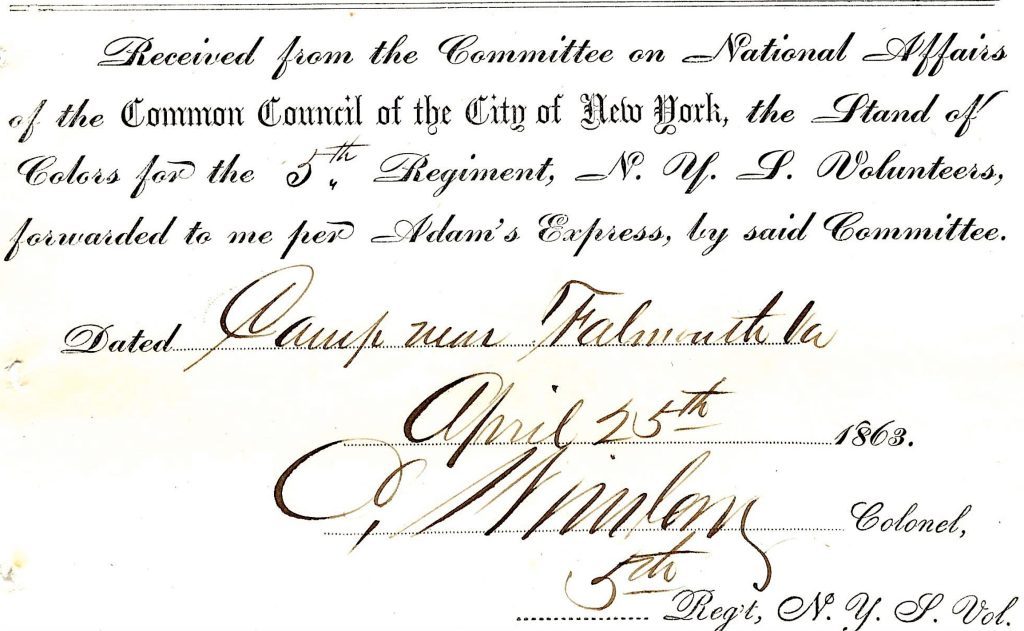
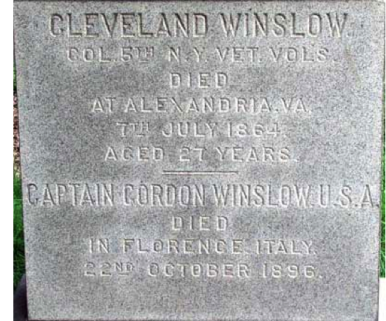
WINSLOW, GEORGE C. (1844-1864). Sergeant, 139th New York Infantry, Company C. A New York City resident, he enlisted as a sergeant on August 21, 1862, at Brooklyn, mustered in the next day, was promoted to first sergeant at some point, and was killed in battle at Petersburg, Virginia, on June 25, 1864. Interment at Green-Wood took place on December 25, 1864. Section 115, lot 13536 (Soldiers’ Lot), grave 96.
WINSLOW, GORDON (1804-1864). Chaplain, 5th New York Infantry; 5th New York Veterans. Born in Williston, Vermont, he was the father of Cleveland (see) and Gordon Jr. (see). He was a student at Phillips Academy from 1823 to 1826, graduated from Yale in 1830 and received a master’s degree from Yale in 1833. A student of theology, he was licensed to preach in 1833 and turned to the Episcopal ministry. He was rector of a church in Troy, New York, and Annapolis, Maryland, where he formed many friendships at the Naval Academy there. During those ministries, he developed an interest in minerals and soon amassed a fine collection for display. Bronchial troubles led to a need for a change of lifestyle and he purchased land and built a cottage when he became the rector of St. Paul’s Church in Staten Island. Prior to the Civil War, he received a doctorate of medicine from New York University.
At age 58, Winslow was an Episcopal minister and resident of Staten Island when he enlisted as a chaplain at Falmouth, Virginia, on May 9, 1861, and immediately mustered into the Field and Staff of the 5th New York. According to Alfred Davenport in “Camp and Field Life of the Fifth New York Volunteer Infantry (1879),” Winslow had an iron constitution, was energetic, able to endure any hardship, and had a strong love of his country. After the Battle of Big Bethel, Virginia, in June 1861, he remained behind to tend the wounded. He was praised by the officer in command, “The noble conduct of Chaplain Winslow and the generous-hearted men who remained to help the wounded, deserves the highest praise; and the toilsome task which they accomplished, of dragging the crude vehicles filled with their helpless comrades, over a weary road of nine miles in their exhausted condition, with the prospect of an attack every minute, bespeaks a goodness of heart and a bravery never excelled.”
Winslow was at the Battle of First Bull Run, Virginia, on July 21, 1861, when he narrowly escaped injury when balls passed through his hair and beard and his horse was wounded under him. He was appointed sanitary inspector on August 14, 1861. When he mistakenly found himself among Confederates after the Battle of Antietam, Maryland, on September 17, 1862, he pretended to be one of their officers tending the wounded and escaped under the cover of darkness. He wrote to his brother after the Battle of Fredericksburg, Virginia, in December 1862:
As for myself, I am ready for anything that turns up in the way of helping on the cause for which we are in the field. I am chaplain of the Fifth, but act more or less for the whole division. Then, as volunteer aid to General Warren, I am under orders, and attend with him in the surveys and mapping of the country, establishing lines of pickets, locating hospitals, and looking after the sick and wounded in the Division, Brigades, and Regiments. After the battle I selected the site for the general hospital at Fredericksburg, and saw the wounded transported across the river and properly provided for.
He mustered out on May 14, 1863, at New York City, and then served with the Sanitary Commission at Gettysburg, Pennsylvania, after that battle. Subsequently, Winslow became an inspector for the Army of the Potomac. He was praised for taking “the best measures of improving hospitals for the wounded, or means of comfort and solace, which at such times of trial cannot be too highly valued.” Winslow later joined his son Cleveland in the field with the 5th Veterans. On June 2, 1864, he found his wounded son, whose arm was in a sling, at the rear of the battlefield at Bethesda Church, Virginia, and wrote in his diary, “Cleve was wounded.” The next day, he wrote, “Went over to find Cleve; found him in a cellar of a house, which was being shelled, on our right….Rode all day to the several hospitals…brought Cleve to the 6th corps hospital and stayed with him overnight.” He wrote about his son’s injury as a “wound in the left shoulder, minie ball, making exit from the back….The wound was much inflamed by his return to the field, after being dressed. He passed the night comfortably….I slept on the ground under the same fly.” Dr. Winslow brought his son to a hospital boat and “his tenderness for his child equaled that of a mother.” Gordon Winslow died on June 7, 1864, when he drowned in the Potomac River while escorting his wounded son on the hospital transport boat, Mary Ripley after throwing a bucket overboard to get water for his horse; the drag from the bucket in the water apparently pulled him overboard. His body was never found. Cleveland died on June 7, 1864, at the Mansion House Hospital in Alexandria, Virginia.
A. Hendricks of the New York Herald said of Gordon Winslow, “A more popular and useful chaplain has not been in the service…A mind finely cultivated, manners dignified and refined, a rare fund of anecdote at command, and an underlying vein of delicate richness, served to make him a most genial as well as an agreeable and instructive companion….No cast of an ancient Grecian or Roman hero presented a more finely molded head than that of Dr. Winslow, and his long flowing gray beard, dark gray eyes of tender but penetrative expression, and straight and well-built frame, although sixty years of age, suggested him as a type, in these days of effeminate degeneracy rarely seen, of those great old philosophers who once walked the streets of Carthage and Rome.”
An obituary in the Christian Times said of Winslow, “His intellectual nature was characterized by life, earnestness, comprehensiveness, liberality of views, a special love for certain pursuits, and considerable genius. He was unambitious and made no display of his abilities. He often declined honors tended him…His business talent and executive abilities were remarkable. These gave him prominence and influence in every undertaking and employment. His accomplishments were of high order….” That obituary notes that he was a member of the Smithsonian Institute and contributed frequently to periodicals and encyclopedias. A craftsman, he had a patent related to the construction of locomotive wheels. That obituary concluded, “His memory we will keep with us, and his influence will live after him like the influence of the good, a source of blessing to many generations.” His wife and sons are buried at Green-Wood and he would have been interred there had his body been recovered. As a part of Green-Wood’s Civil War Project, a cenotaph was applied for at the Department of Veterans Affairs, was received, and was installed by Green-Wood staff in his family’s lot. Section 11, lot 3909.

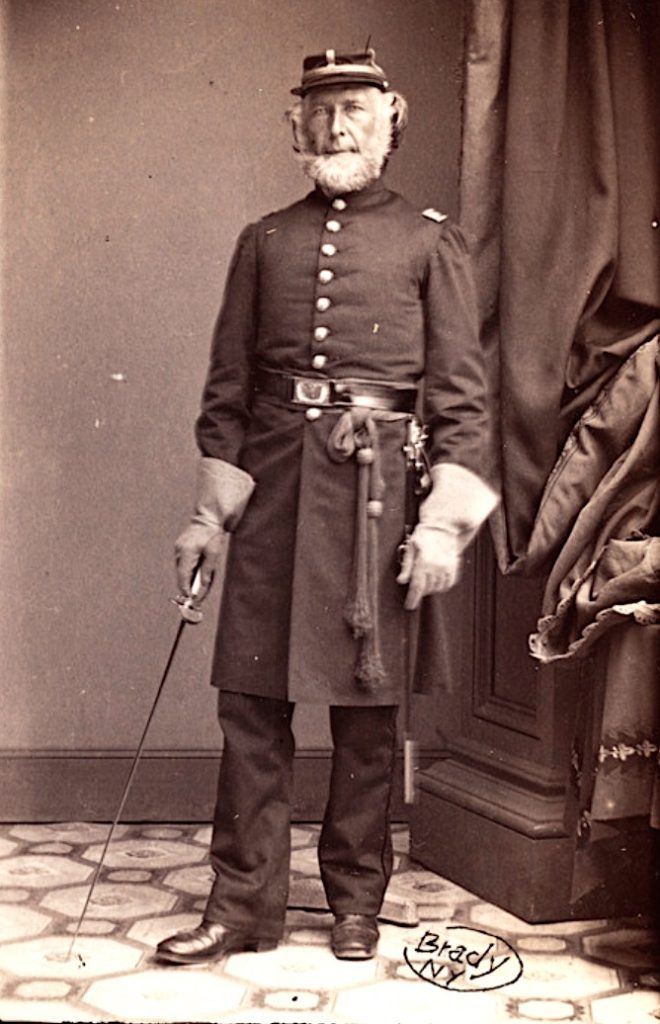
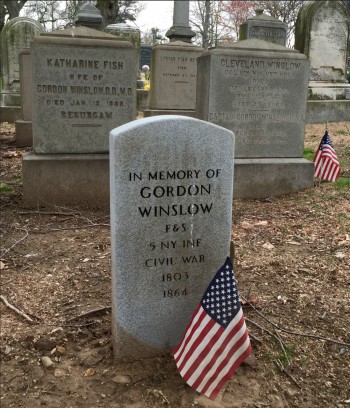
WINSLOW, JR., GORDON (1838-1896). Major by brevet; captain, 5th New York Veterans, Company A. Born in Elmira, New York, he was the son of Rev. Gordon Winslow, the regimental chaplain (see), and brother of Colonel Cleveland Winslow (see). A clerk, Winslow served as a first lieutenant in the 5th New York from August 30, 1862-May 14, 1863. He also served in the 15th, 33rd, and 8th United States Infantries. He enrolled at Albany, New York, on October 19, 1863, and mustered into the 5th New York Veterans as a first lieutenant on that date. On February 8, 1864, Winslow was dismissed for overstaying his furlough, but he re-enlisted and mustered in as a private on March 24, 1864. On May 24, 1864, his order of dismissal was revoked and he was restored to his prior rank. He mustered in as a captain of Company A on July 25, 1864, and was wounded at Weldon Railroad, Virginia, on August 25.
Appointed aide-de-camp on the staff of General Gouverneur K. Warren on November 5, 1864, Winslow returned to the 5th New York Veterans on April 4, 1865, after Warren was relieved of command. He mustered out at Hart’s Island, New York Harbor, on August 21, 1865. He was brevetted major for gallant and meritorious service during the War. He later was commissioned in the regular army, but alcoholism and sickness limited his military career. As per his obituary in the New York Herald, he was a member of the Loyal Legion, a patriotic organization composed of Union officers who served in the Civil War. He died from consumption in Florence, Italy. Section 11, lot 3909.

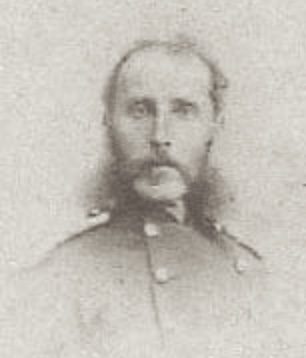
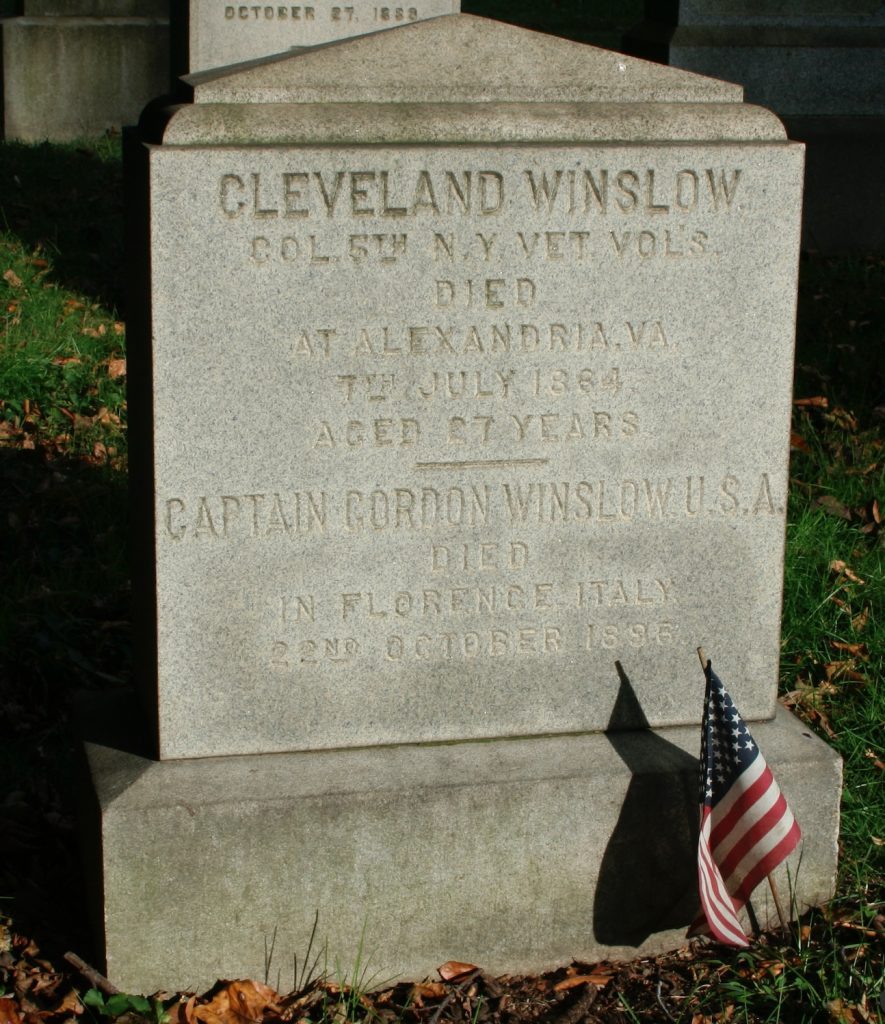
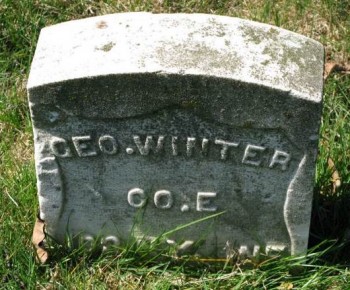
WINTER, GEORGE (1841-1926). Private, 102nd New York Infantry, Company E. Born in Germany, Winter enlisted at New York City as a private on February 28, 1864, and mustered into the 102nd New York the same day. He served the remainder of the War, and mustered out at Alexandria, Virginia, on July 21, 1865. In 1891, he applied for and received a pension, certificate 797,543. He last lived at 2388 Ocean Avenue, Brooklyn. In 1926, his wife applied for and received a widow’s pension, certificate a-3-14-27. Section 205, lot 34564.
WINTER (or WINDER), FERDINAND (1840-1875). Private, 9th New York Infantry, Company E. Born in Germany, he enlisted at New York City on April 23, 1861, and mustered into Company E of the 9th New York on May 4. A month later, he deserted on June 4 at New York City. He last lived on Washington Street in Manhattan. Winter died of phthisis, (tuberculosis.) Section 66, lot 2109.
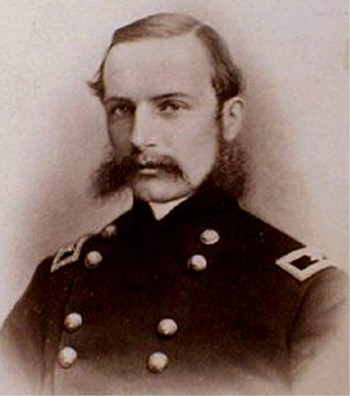
WINTHROP, FREDERICK (1839-1865). Major general and brigadier general by brevet; colonel, 5th New York Veteran Infantry; captain, 12th United States Infantry; 71st Regiment, New York State Militia, Company F. A native New Yorker, he enlisted there as a captain on April 20, 1861, mustered into the 71st New York State Militia that day, and mustered out with his company on July 30 of that year at New York City. Winthrop was commissioned as a captain on October 26, 1861, served in the 12th United States Army Infantry and was brevetted to brigadier general on August 1, 1864, “for brave, constant, and efficient services in the battles and marches of the campaign.”
Promoted to colonel of the 5th New York Veterans on August 6, 1864, Winthrop was wounded at Weldon Railroad, Virginia, on August 18, 1864. He commanded the First Brigade of the Second Division of the Fifth Corps of the Army of the Potomac, periodically, from August 19, 1864, until April 1, 1865, when he was killed in action at Five Forks, Virginia. Brevetted major general, effective as of that day, Winthrop was recognized for his gallant conduct at Five Forks. He initially was interred in Trinity Churchyard in Manhattan; interment at Green-Wood took place on May 7, 1866. Section 169, lot 15764.
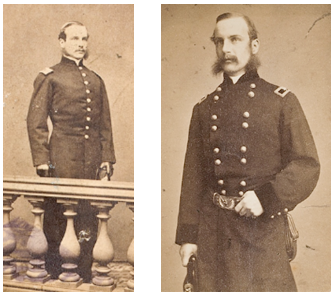
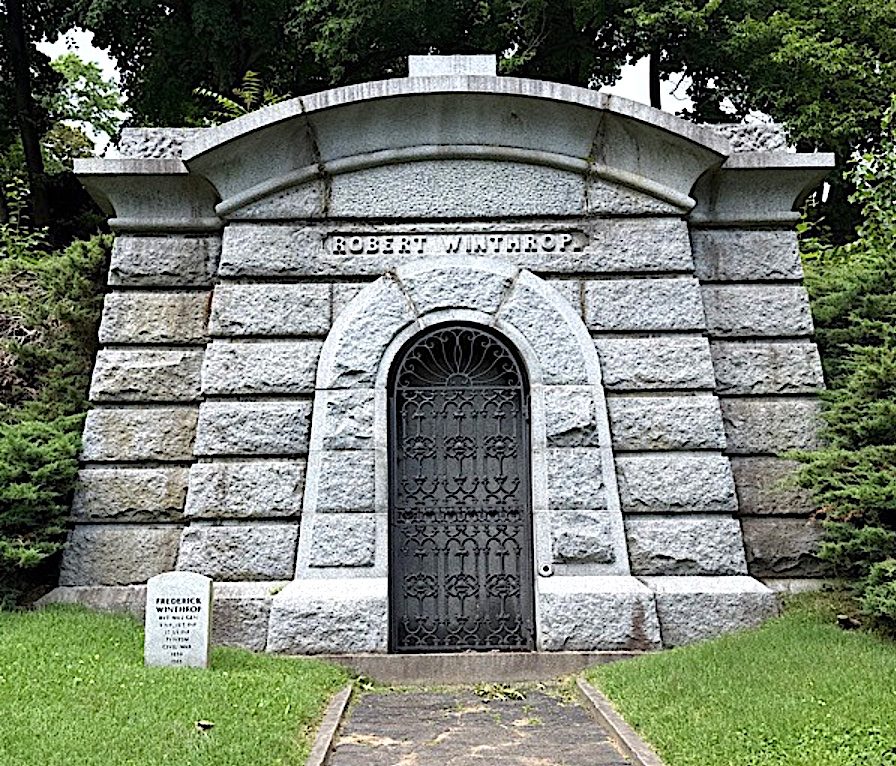
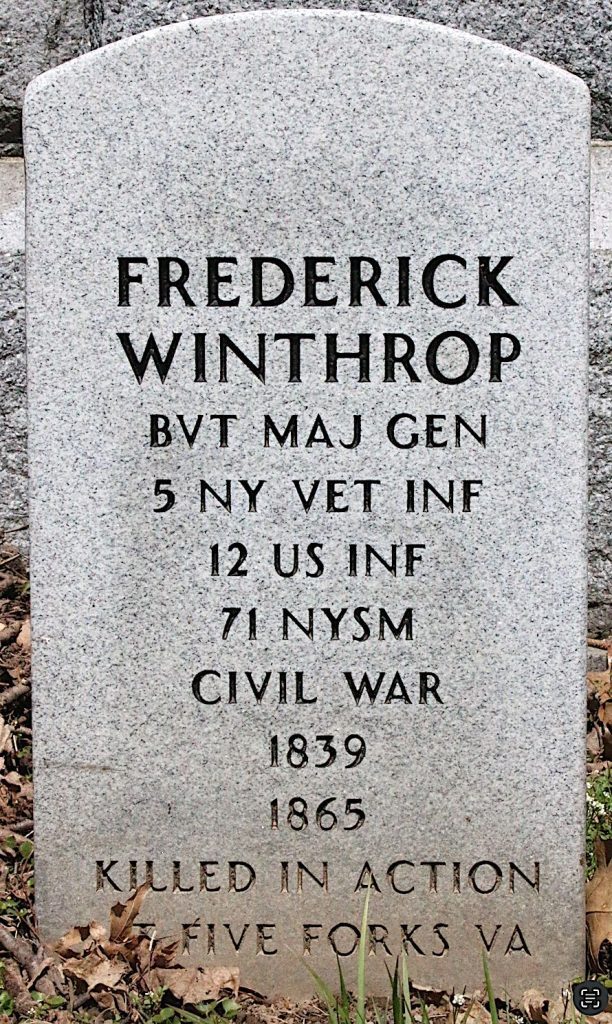
WINTHROP, RICHARD (1840-1870). Unknown soldier history. A native of England, Winthrop was a Civil War veteran. He may have served in the 42nd New York Infantry. If he did, he was transferred from Company B to Company G on June 23, 1861, and was discharged for disability on December 1, 1861. Or he may be the Richard Winthrop who enlisted at New York City as a private on April 25, 1861, mustered into Company G of the 6th New York on May 25, and deserted on June 13. He last lived at 548 West 44th Street in Manhattan; he died of phthisis. Section 127, lot 17931, grave 447.
WINZER, REINHOLD (1837-1863). Second lieutenant, 41st New York Infantry, Company A. Born in Germany, Winzer enlisted as a private at New York City on June 6, 1861, and mustered into the 41st New York that day. He was promoted to first sergeant on September 19, 1862, and to second lieutenant on March 10, 1863. He was killed in battle at Gettysburg, Pennsylvania, on July 2, 1863. Section 172, lot 14192.

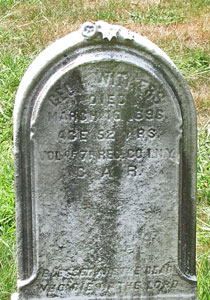
WITHERS, GEORGE H. (1844-1896). Corporal, 71st New York Infantry, Company I. Withers enlisted as a private at Colchester, New York, on May 2, 1861, and mustered into the 71st New York on June 27. During his service, he was promoted to corporal. After he was taken as a prisoner of war on August 29, 1862, at the Battle of Second Bull Run, Virginia, he was paroled five days later on September 3 at Centreville, Virginia. He mustered out at New York City on July 30, 1864. He last lived at 1913 Prospect Avenue in Brooklyn. Section 121, lot 22334.
WITPEN (or WITPIN), CHARLES (1843-1895). Private, 71st Regiment, New York State Militia, Company A. After Witpen enlisted in 1861 at New York City as a private, he mustered into the 71st Regiment for its three month activation, mustering out at the expiration of his enlistment. In 1895, he applied for an invalid pension, application 1,170,858, but he died before it was certified. His last address was 327 Hancock Street in Brooklyn. Martha Witpen, who is interred with him, applied for and received a widow’s pension in 1896, certificate 428,812. Section 45, lot 5862.
WITT, HENRY CLINTON (1836-1873). Private, 23rd New York Infantry, Company D; 107th New York Infantry, Company I; 60th New York Infantry, Company B. Witt first served in the 23rd New York but there are no details about that service. On February 24, 1864, he enlisted as a private at Corning, New York, and immediately mustered into the 107th New York. He transferred into the 60th New York on June 5, 1865, from which he was discharged. His last residence was 179 South 4th Street in Brooklyn. Section 207, lot 21402.
WITTLINGER, JOHN (1838-1866). Private, 55th New York Infantry, Company F. Originally from Germany, Wittlinger served with the 55th New York. Further details are not known. His last address was 76 Essex Street in Manhattan where he died from consumption. Section B, lot 9895, grave 402.
WITTY (or WHITY), WILLIAM (1842-1890). Private, 37th Regiment, New York State National Guard, Company H. He enlisted at New York City as a private on May 29, 1862, mustered into the 37th Regiment that day, and mustered out after three months on September 2 at New York City. Section 203, lot 26918.
WITTMEYER, ALFRED VICTOR (1847-1926). Private, 27th Regiment, Pennsylvania Militia Infantry (Emergency), Company H. Born in Saar-Union in Alsace, France, Wittmeyer came to the United States as a child. His father had been banished by Napoleon III for excessive republicanism. During the Civil War, he served in the 27th Regiment of the Pennsylvania Militia, an emergency unit that was called up for 30 days from June 19 through August 1 in 1863, to meet the Confederate invasion.
After the War, Wittmeyer returned to France to study for the ministry, got caught up in the Franco-Prussian War, and fought in that conflict. Subsequently, he studied at the University of Strasbourg, then finished his preparation at the Union Theological Seminary. He was ordained a deacon in 1879 and advanced to the priesthood of the Protestant Episcopal Church in 1880. Wittmeyer became rector of the French Church du St. Esprit on 27th Street in Manhattan in 1879 and held that position for all forty-five years of his active ministry. His New York City church dates to 1628 and was a rallying place for Huguenots (French Protestants). As per his obituary, he was a founder of the Huguenot Society in America, wrote several books on French Protestantism in the United States, and wrote a prayer book for his church. The obituary adds that 60 men and ten women from his congregation went overseas to fight for the Allies in World War I. Wittmeyer last lived at 606 West 137th Street in Manhattan. Section 77, lot 8207.
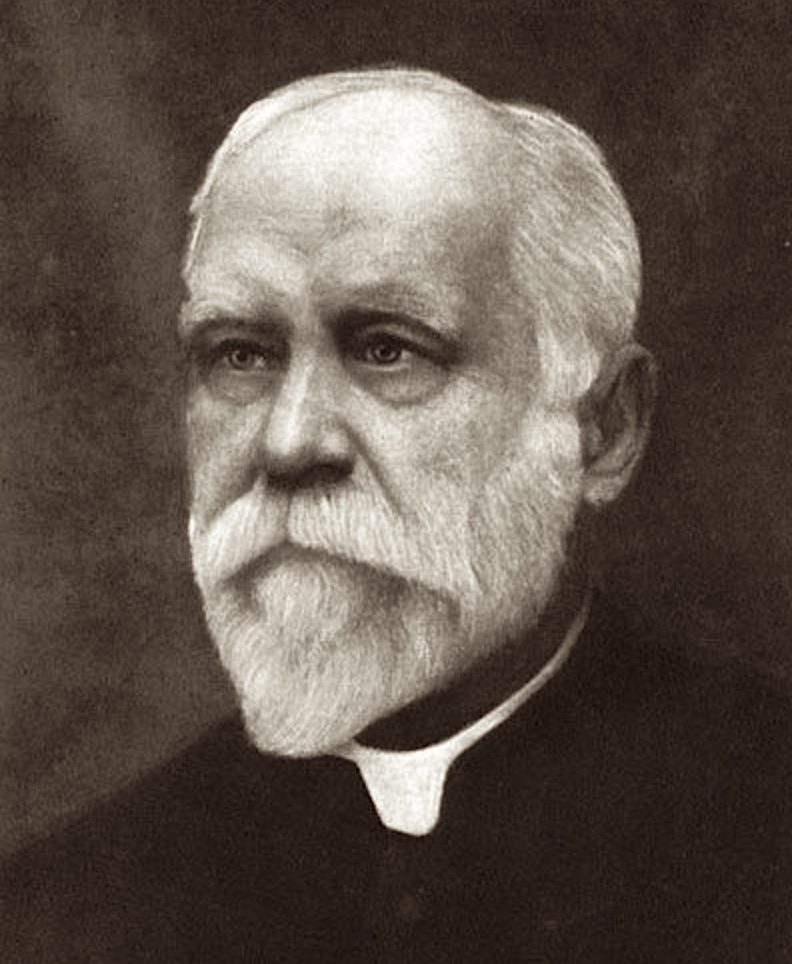
WOHLKER, ANDREAS (or ANDREW) (1843-1871). Private, United States Army 3rd Light Artillery, Battery I. A native of Germany, Wohler enlisted as a private and served in Battery I of the United States Army’s 3rd Light Artillery. Further details of his service are unknown. His last residence was 101 Elizabeth Street in Manhattan. Section 127, lot 17806, grave 394.
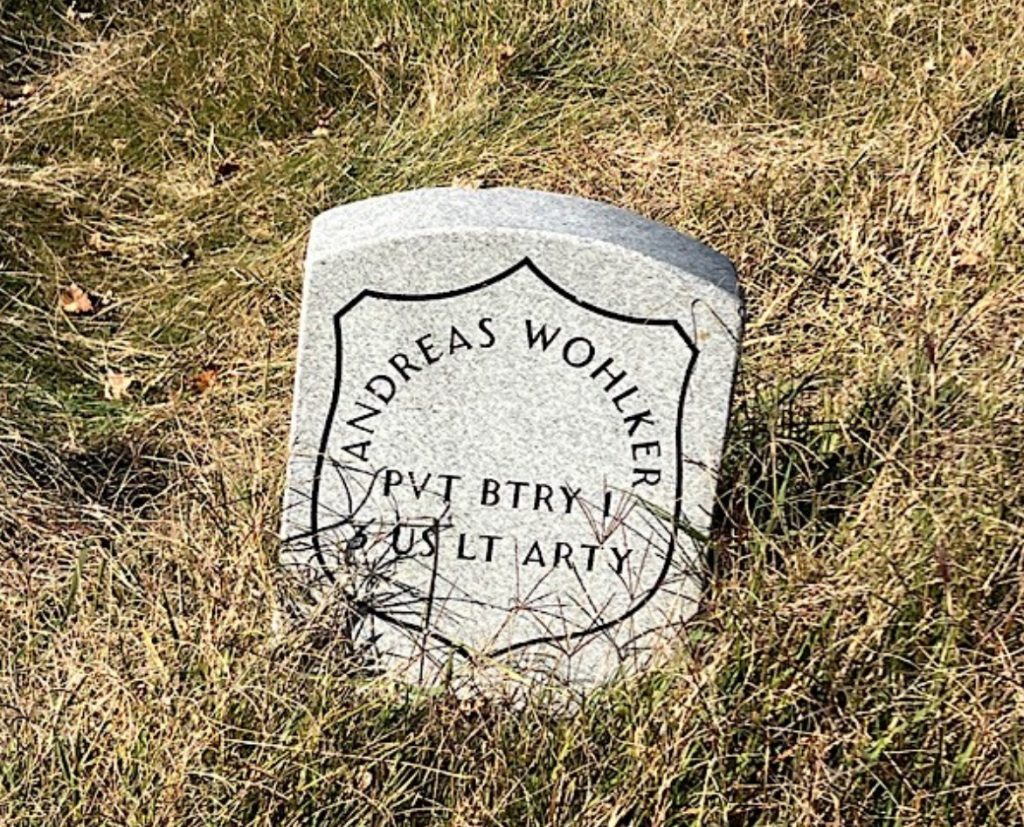
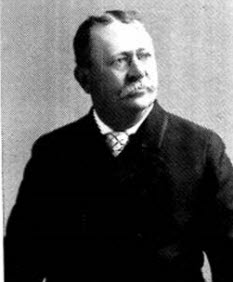
WOLCOTT (or WALCOTT), GEORGE D. (1838-1900). Sergeant, 71st Regiment, New York State National Guard, Companies E and D. Born in New York City, he spent time at sea where he learned navigation before entering business. He joined the 71st Regiment on June 6, 1859. When he was with the 71st in 1861 during its three month activation, he was assigned to the Washington Navy Yard, and subsequently detailed to the USS Philadelphia and Baltimore where he rooted out rebel batteries on the Potomac and brought Colonel Elmer Ellsworth and the Zouave Regiment (5th New York) to Alexandria, Virginia. He later brought back Ellsworth’s body after he was shot.
During the 1861 activation, Wolcott was at the Battle of Bull Run, Virginia. He re-enlisted at New York City as a sergeant on June 28, 1862, mustered immediately into the 71st New York State National Guard’s Company E, and mustered out on September 2, 1862. He also served in the same regiment’s Company D for 30 days in 1863 at which time his company fought in the Pennsylvania campaign and was engaged in quelling the New York City Draft Riots. He became a first lieutenant on November 12, 1863, and then was promoted to captain of Company D on December 31, 1864.
Remaining with the 71st after the Civil War, Wolcott was commissioned major on April 7, 1868, and lieutenant colonel on November 15, 1869. He participated with the 71st when it was called during the Orange Riot of 1871, after a New York City parade fueled tensions between Irish Protestants and Catholics. In 1872, he began working for the Citizens’ Steamboat Company and commanded the ill-fated Sunnyside when it sunk in the ice in 1875 outside Hyde Park, New York. He was praised for his skill in that accident at which time fourteen passengers drowned. He last resided at 22 7th Avenue in New York City. His death was caused by heart disease. Lizzie Wolcott applied for and received a widow’s pension, certificate 548,147. Section 36, lot 13394, grave 5.
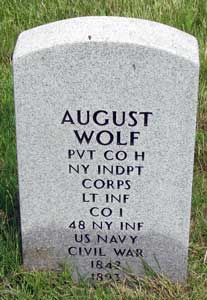
WOLF, AUGUST (1842-1893). Private, New York Independent Corps, Light Infantry, Company H; 48th New York Infantry, Company I; rank unknown, United States Navy. Wolf enlisted on January 30, 1864, and mustered initially into Company H of the New York Independent Corps, Light Infantry. He transferred out the same day into Company I of the 48th New York. Some time later (no date given), he transferred out of the 48th and into the Navy. He was living in New York at the time of his death from a pistol shot. Section A, lot 8998, grave 559.
WOLF, JOSEPH (1842-1900). Private, 7th New York Infantry, Company F. Originally from Germany, he enlisted as a private at Brooklyn on August 11, 1864, and mustered into the 7th New York on the same date. He was wounded in the head during battle at Hatcher’s Run, Virginia, on March 31, 1865. Two weeks later, he was hospitalized at Armory Square Hospital in Washington, D.C., then transferred to Whitehall Hospital in Bristol, Pennsylvania, on May 26, 1865, from which he was discharged for wounds on June 20, 1865. His last residence was on Atlantic Avenue in Brooklyn. Wolf died of phthisis. Section 166, lot 29835.
WOLFE, HUDSON G. (1833-1902). Private, 7th Regiment, New York State Militia, Company C. A native of New York City, Wolfe served as a private with the 7th Regiment, New York State Militia. He mustered out with the 7th at New York City on June 3, 1861. Wolfe was a member of the G.A.R., Lafayette Post #140. His obituary in the New York Herald indicates that he was a member of the 7th Regiment Veteran Associations; comrades from the 7th Regiment and the Lafayette Post were invited to attend his funeral. He last lived at 710 Eighth Avenue in Manhattan. Section 142, lot 23024.

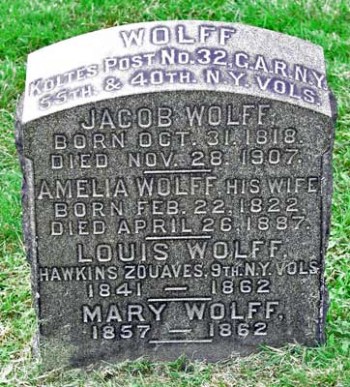
WOLFF (or WOLF), JACOB (1818-1907). Corporal, 55th New York Infantry, Company F; 38th New York Infantry, Company G; 40th New York Infantry, Companies E and B. After he enlisted on August 17, 1861, as a private, at Staten Island, he mustered into Company F of the 55th New York on August 28. Wolff was promoted to corporal on December 15, 1861. On December 21, 1862, Wolff transferred into Company G of the 38th New York, and was reduced in rank to private on January 30, 1862. He re-enlisted as a private on June 3, 1863, and mustered into Company E of the 40th New York. At some point, he was promoted to corporal, but later reduced in rank to private. After being taken as a prisoner of war on May 6, 1864, at the Wilderness, Virginia, he was paroled and returned on April 29, 1865. During that period, on July 7, 1864, he was transferred to Company B. His son, Louis (see), served with the 9th New York. He last resided at 43 Grand Avenue in Richmond Hill, Queens.
His gravestone confirms his service in the 55th and 40th Infantries and membership in the Koltes Post #32 of the G.A.R. Section B, lot 9895, grave 770.
WOLFF, LOUIS (1841-1862). Private, 9th New York Infantry, Company F. Wolff, whose father Jacob (see) was also a veteran of the Civil War, enlisted at his birthplace, New York City, on August 1, 1861, and mustered into the 9th New York, also called the Hawkin’s Zouaves, the same day. He was discharged for disability on November 18, 1861, at Fort Hatteras, North Carolina. He last resided on Essex Street in Manhattan where he died from consumption. Section B, lot 9895, grave 770.
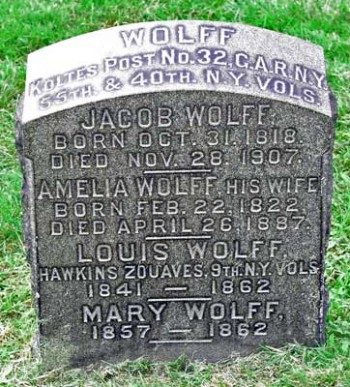
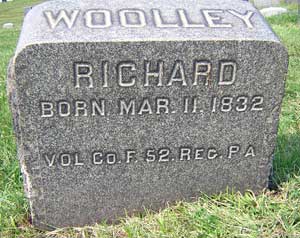
WOLLEY (or WOOLEY), RICHARD (1832-1917). Private, 52nd Pennsylvania Infantry, Company F. He enlisted and mustered into the 52nd Pennsylvania on October 24, 1861, and mustered out on November 5, 1864. Section 133, lot 16874, grave 64.
WOOD, ANDREW JACKSON (1818-1882). Private, 137th Indiana Infantry, Companies B and I. Wood was born in Greenfield (Saratoga County), New York. On December 8, 1847, he married Julia Adelaide Henry in Cook County, Illinois. At the time of the 1855 New York State census, he lived in New York City with his wife and three children. The 1860 census reports that he lived in Brooklyn with his wife and six children and worked as a merchant.
During the Civil War, Wood enlisted as a private at Jefferson County, Indiana, on May 26, 1864, and immediately mustered into Company B of the 137th Indiana Infantry. His pension index card notes that he also served in Company I of that regiment. He mustered out on September 21, 1864, at Indianapolis, Indiana. As per the 1865 New York State census, he lived in Brooklyn with his wife and children. He died in Orange, New Jersey. In 1885, Julia Wood, who is interred with him, applied for and received a widow’s pension from Indiana, certificate 246,173. Section 157, lot 15953.
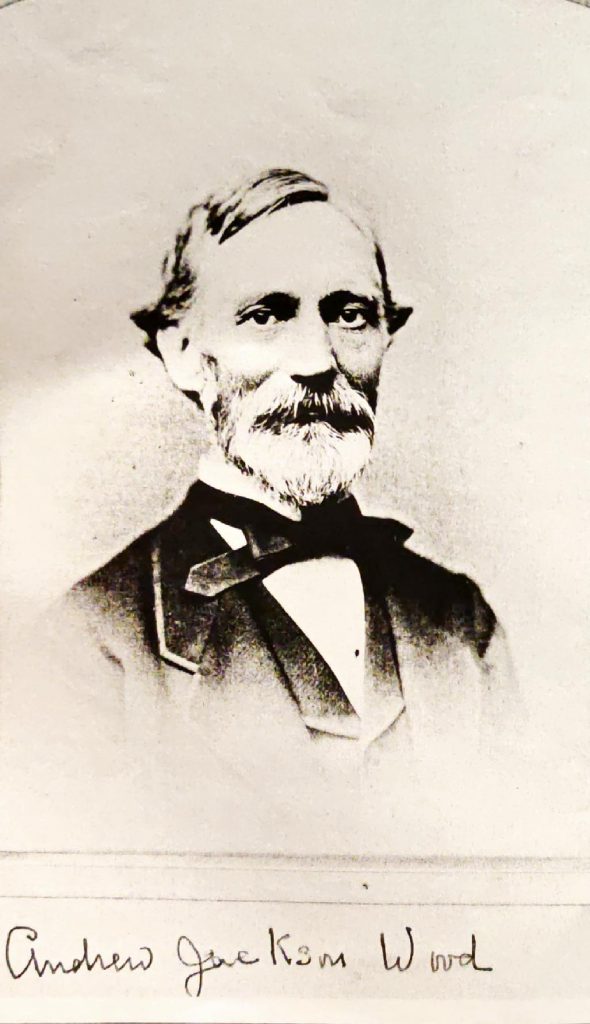
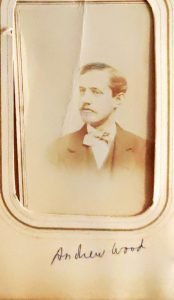

WOOD, EBENEZER B. (1843-1898). Private, 23rd Regiment, New York State National Guard, Company D. A native of New York City, Wood enlisted in 1863 when the 23rd Regiment was activated for 30 days. His last residence was at 598 Macon Street in Brooklyn. Section 55, lot 16916, grave 10.
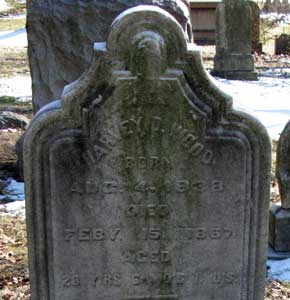
WOOD, HARVEY D. (1838-1867). Private, 2nd New York Heavy Artillery, Company F. Originally from Massachusetts, Wood enlisted at New York City on August 14, 1862, as a private. He mustered into Company F of the 2nd New York Heavy Artillery that same day. On June 12, 1864, he was wounded in the spine at the Battle of Petersburg, Virginia. After a hospital stay at Lincoln Hospital in Washington, D.C, beginning on or about June 20, 1864, he deserted there on July 7, 1864. His last address was 254 West 46th Street in Manhattan. Section 113, lot 17898.
WOOD, MILES (or MYLES) (1814-1871). Private, 71st New York Infantry, Company E. Wood was born on Long Island. As per an article in The New York Times of August 30, 1852, Miles Wood, an innkeeper, was the plaintiff in a case against the Brooklyn Liquor Law and Sunday Ordinance stating that it prevented him from performing his business. Wood, the father of Samuel Miles Wood (see), served in the Civil War. His certificate of Discharge for Disability notes that enlisted at age 47 on May 13, 1861, at Camp Scott, Staten Island, to serve three years. At that time, he was a public housekeeper who was 5′ 7″ tall with blue eyes, light brown hair and a light complexion. His descendant has letters that he wrote his daughter from camp. The first is from a camp in Prince Charles County, Maryland, on November 17, 1861. Excerpts from the letter follow with the original spelling; punctuation was added to make it clear to the reader. In the first excerpt, he describes his guard duty:
…We were there nine days before we got to this camp and I was somewhat scared as there were some balls fired at us from across the river but they were fired over us so of course there was no damage done to us and while we was there the captain out of fun told the men that I was taken by the rebels and murdered so that when I got to the new camp they were quarraling (sic) who should have my boots and clothes to the laughable fun of the Captain….
The nearer we approach our enemy the more duty we have to perform. We have to be on guard night and day to keep them from crossing the river. We can see there picket and they can see ours. The river is about as wide as it is from Fulton Ferry to New York. We can hear holler and calling us a pack of cowardly sons of bitches and of course they get the same for an answer.
We have got five men of war lying there off there and they blockade there vessels from going up the river. They have got a battery above us on the opposite of the river and they fire at our vessels. This is an everyday occurrence but so far they have not hit one of our vessels. Now this Sunday while I am writing there is no less than six of our vessels passed them without being hit with there balls which they commence firing as soon as there is a vessel in sight….
Nothing more to say about the war at present only we do not know how soon they may attack us but I think they will have a hot time of it as there is no less than ten regiments of us, ours and General—are combined together in a division.
Now I want and your mother to send me my New Years and I will tell you what I want. I want you to make me some nice crullers and some cake and likewise half gallon of Old Jamaica run. You must put them in a candle box and direct it to Captain Murphey on the outside of the box and not to me. On the inside put it who it is for and let Sam carry it to Adams Express office and it will come safe…
Nothing more at present
This from your father
Miles Wood
Below is a letter from a camp near Liverpool Point. Paragraphs and some punctuation have been added to make the letter’s contents clearer to the reader. It was written on January 13, 1862.
Dear Maggie,
I am enjoying myself these few idol (sic) moments in writing to you informing you that I am well. At present hoping these few lines may find you all the same. I received your welcome letter and likewise that long coming box at the same time that was on the 9th January. It was too late for New Year’s Day but it answered the same purpose. Both me and my tent mates had a jolly spree over the cake and the likewise had some whiskey to wrench it down with. We had to pay 12 shillings for one quart of rye whiskey and one did not have the desired effect so we went for the second. Likewise the third. So you can easy judge the condition of myself and my five mates.
In your letter you speak of your New Year sports. It is not to be compared with ours on New Year’s Day. We commenced with a greased pig to catch by the tail while running and likewise climbing a greased pole. In the afternoon a great ball match that ended the day’s sport. Evening a brake down dance by the Negro slaves here that we have taken while marching. There was a great many boxes sent here on New Year’s for the soldiers with liquor and the Colonel ordered the boxes to be broken open and the liquor spilt in the presence of the owners which you may judge caused some swearing. So in the course of four days we raised a large poll (sic) and on it hoisted the stars and stripes and for the occasion the Colonel ordered a barrel of whiskey to be opened for the soldiers to drink but to his utter astonishment few of them drank any saying they had spilt theirs and they might do the same with that….
…I received a letter from home on Christmas Eve wrote by Sammy and he does not write as good as he did when I left home. I am afraid he does not attend to his school regular. I reckon he has to (sic) many Holidays. When I write home again I am going to scold your Mother about it. I got Sam and Cassy’s likeness in the box and I think that Cassy was rather out of humor when taken but you must not tell her that. If you do then I will get it.
The Assistant Adjutant General has got himself in a big scrape. He has turned traitor. He has been guilty of sending dispatches to the Secession Armies by his daughter of all our army proceedings. She was caught with the letters in her hair. But her and her father is locked up in Fort Warren Prison.
I think you would laugh to have a bird’s eye view of our tents. When we are all in and see our fancy fireplaces made of clay. We last summer was the color of copper with the heat. Now we are a very dark drab with the smoke. I will conclude my letter by wishing your (sic) all a Happy New Year. This from your sincere and affectionate Father,
Miles Wood
Paper is plenty here
As per his soldier records, he was captured at Fair Oaks, Virginia, on July 1, 1862; a notation on his record indicates that he was wounded at that time. He was then held as a prisoner of war at Richmond, Virginia, as of July 2. He was admitted to the hospital at Savage Station, Virginia, on an unknown date and exchanged at City Point on July 27, 1862. Wood’s muster roll indicates that he was absent from the regimental muster rolls after the evacuation of Fair Oaks or missing since July 1862; he was listed on the U.S. General Hospital muster roll for Chester, Pennsylvania, for August and September 1862. He was discharged from the U.S. General Hospital, in Chester, Pennsylvania, having been declared unfit for duty for more than 60 days, on September 15, 1862. His document of discharge, dated September 19, 1862, records his ailment as hemiplegia (paralysis on one side of the body) and the degree of disability as ½ for pension purposes. Section 164, lot 16094.
WOOD, SAMUEL MILES (1847-1922). Private, 23rd Regiment, New York State National Guard, Companies A and K. Wood was born in Chatham, New York, and moved to Brooklyn at a young age with his parents, his father being an innkeeper who ran a public house and hotel. His father, Miles Wood (see), was an ardent foe of Brooklyn’s Liquor Law and Sunday Ordinance, which he repeatedly attacked in the courts.
Samuel Wood mustered in as a drummer boy with Company A of the 23rd National Guard on June 16, 1863, leaving the state for Harrisburg, Pennsylvania, two days later in support of the Gettysburg campaign during the invasion of Pennsylvania by Robert E. Lee’s army. The regiment was attached to the 3rd Brigade of the 1st Division in the Army of the Department of the Susquehanna. The 23rd was present at Oyster Point Station on June 28, where it performed picket duty, and in the vicinity of Carlisle on July 1, blocking Lee’s forces. The regiment mustered out on July 22 of that year. After his active service in Pennsylvania, he re-enlisted with the regiment on August 22, 1864, as a private in Company K.
After the Civil War, Wood remained in Brooklyn and entered the wholesale paint and art supply business, in which he worked for most of his adult life. He continued to be devoted to the 23rd Regiment. In 1872, he was appointed sergeant and left general guide. The following year he returned to Company K. In 1879, he resigned his warrant and was transferred to Company H as a private. In 1890, Wood was awarded the diamond “Iron Cross” for his 25 years of continuous service in the regiment at a major gathering at the 23rd Regiment Armory in Brooklyn that was attended by more than 750 officers and members who had served in the organization. Later that year, he was promoted to sergeant. He again returned to the ranks in 1892. On November 2, 1896, Wood was made quartermaster sergeant of Company H, a position held until he received a brevet commission as a second lieutenant, effective February 13, 1906, upon his retirement from the 23rd after 40 years. Wood never missed the annual inspection of his regiment although during his last inspection in January 1906, he took ill and had to be taken to the armory in a carriage. Because of his long and faithful service in the regiment, he was known as “the Old Campaigner,” a motto which his company also adopted.
In 1908, Wood moved to Cranford, New Jersey, from Greene Avenue (near Nostrand Avenue) in Brooklyn, and, as per the 1910 census, lived there on Orchard Street. That census also reports that he been married for fifteen years, worked as a salesman in the wholesale paint industry, and could read and write. The 1915 New Jersey State census and the 1920 census note that he still lived on Orchard Street, was married and worked as a paint salesman. As per his obituary in the Brooklyn Daily Eagle, which confirms his Civil War service as a charter member of Company H of the 23rd Regiment, he was a “clever” marksman and was held in high esteem by his comrades in the Veterans’ Association of his regiment. At the time of his death, he was a widower with one surviving son. He last lived at 401 Orchard Street in Cranford, New Jersey. Section 164, lot, 16094.
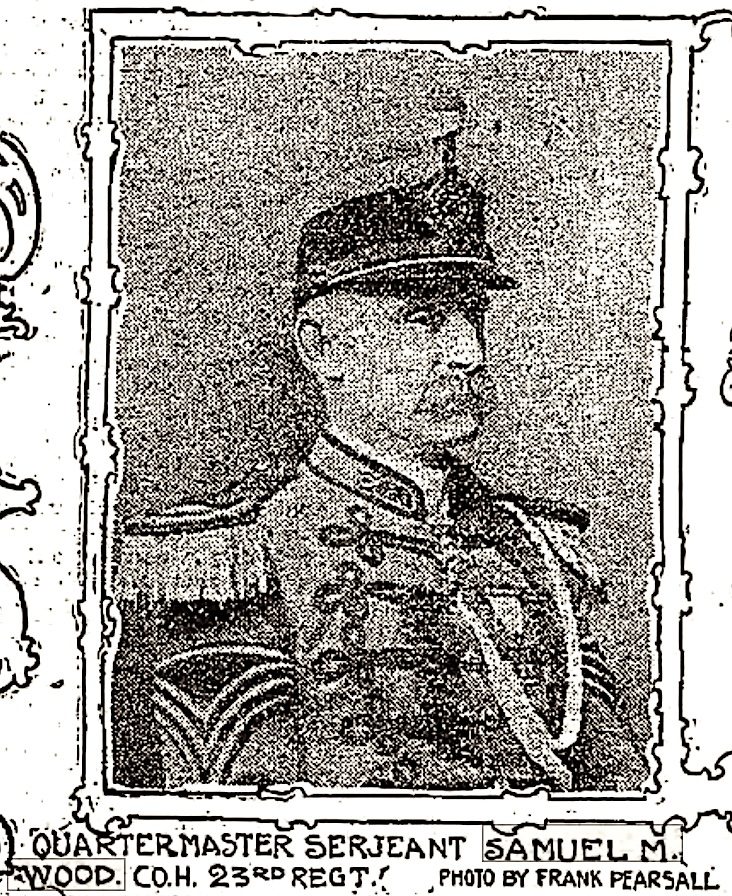
WOOD, VAN RENSSELAER (1832-1871). First lieutenant, 15th New York Engineers, Companies G, D, H, and M. Born in Ireland, Wood enlisted at New York City on May 9, 1861, as a private. He mustered into the 15th New York Engineers, Company G, on June 17, 1861, was promoted to sergeant on September 1 of that year, and mustered out on June 25, 1863. On January 4, 1864, he mustered into Company D after rejoining the unit, was demoted to corporal on February 1, and was restored to sergeant one month later on March 1. He was transferred to Company H on January 26, 1865, as a second lieutenant, and again to Company M on May 31, 1865, as a first lieutenant. Wood mustered out on June 13, 1865, at Fort Barry, Virginia. He last resided in Clinton, New Jersey. Section 86, lot 1899, grave 79.
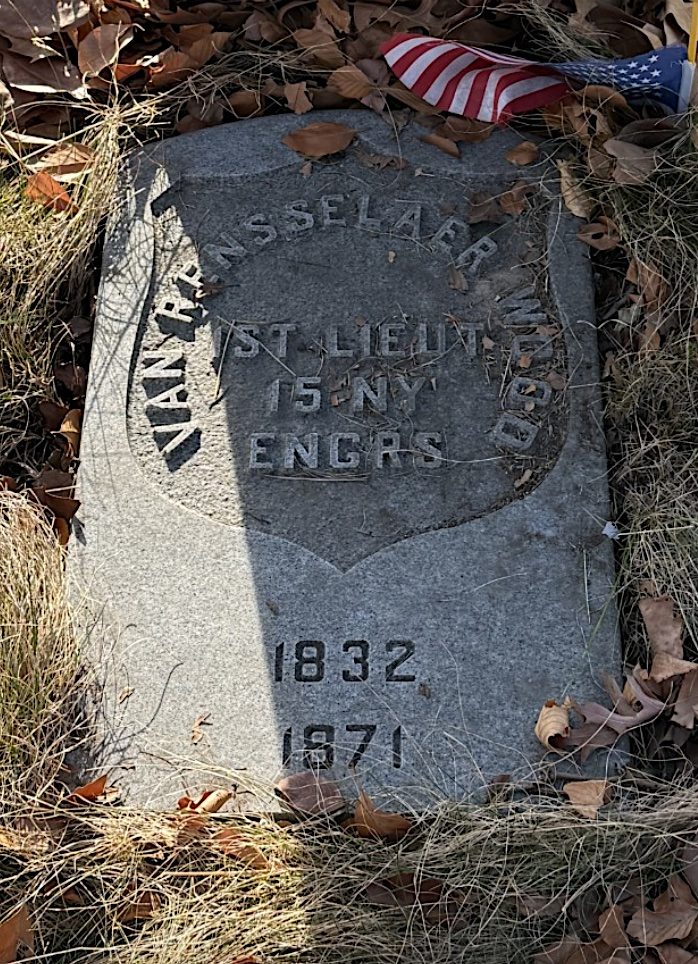
WOOD, WILLIAM A. (1820-1881). Second lieutenant, 55th New York Infantry, Companies I and D. A New Yorker by birth, he enlisted at Staten Island on August 28, 1861, and was commissioned that day into Company I of the 55th New York. Four days later, he was transferred into Company D, and was discharged for disability a year later on September 24. A resident of Brooklyn, he died in Cincinnati, Ohio. Section 184, lot 24836.
WOODCOCK, THOMAS S. (1845-1923). Private, 13th Regiment, New York State National Guard, Company I. He enlisted at Brooklyn on May 28, 1862, and mustered immediately into the 13th Regiment. On September 12, 1862, he mustered out at Brooklyn after serving for three months. He also served with the same company for 30 days when the regiment was activated in 1863.
After the War, Woodcock was a member of the 13th Regimental Veterans Association and was active in the McPherson-Doane Post #499 of the G.A.R. His status is confirmed by the Veterans Census of 1890. On November 18, 1923, at the age of 78, Thomas Woodcock and his wife Elizabeth, age 73, were struck by the 7th Avenue trolley car at Flatbush Avenue and State Street. He died that day; his wife, the next day. He last resided at 526 State Street in Brooklyn. Section 93, lot 1189.

WOODHEAD, JAMES (1840-1919). Private, 84th New York (14th Brooklyn) Infantry, Company C. Born in Fetherstone in Yorkshire, England, he enlisted at Brooklyn as a private on August 29, 1862, and mustered into the 14th Brooklyn the next day. Wounded in action at Gettysburg, Pennsylvania, on July 1, 1863, he lost part of his right foot and leg there. He was later discharged for disability on February 26, 1864.
When he returned to civilian life, Woodhead was a marble-cutter by trade. His obituary in The New York Times notes that he was a gauger for the United States Internal Revenue Department for forty-eight years and active in Republican Party politics. A charter member of the Thatford Post #3 of the G.A.R., he was its commander for eleven years and took pride in honoring the War dead at Green-Wood by planting flags on Decoration Day each year beginning in 1869. In an 1890 article in the Brooklyn Daily Eagle, it was noted that there were over 1,000 graves to be decorated. He last lived at 480 East 23rd Street in Brooklyn. Section 43, lot 21685.
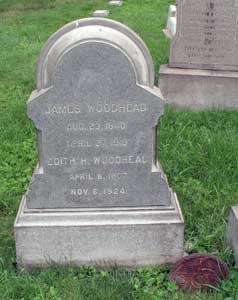
WOODHULL, GEORGE SPOFFORD (1829-1912). Chaplain, 4th West Virginia Infantry. A graduate of New York University and Princeton Theological Seminary, Woodhull, who was born in New York City, was licensed to preach by the Presbytery of New York. He was commissioned an officer in the 4th West Virginia in 1861, serving in the Field and Staff, and mustered out on October 3, 1864.
For many years, Woodhull served as pastor of the Presbyterian Church at Point Pleasant in Mason County, Virginia. He later served as pastor at churches in Wisconsin and Michigan. The honorary degree of Doctor of Divinity was conferred upon Woodhull by New York University. He applied for an invalid pension in 1893 which was granted, certificate 877,899. Joliet, Illinois, was his last residence. Section 23, lot 1823.
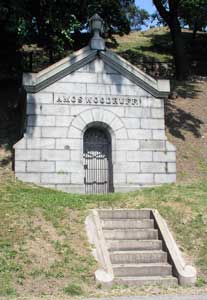
WOODRUFF, AMOS (1842-1902). Private, 71st Regiment, New York State Militia, Company A. According to the 1900 census, he was born in New Jersey (although another record lists his birthplace as Poughkeepsie, New York). Woodruff served in the 71st Regiment in 1861 when it was activated for three months.
Woodruff was a member of the Lafayette Post #140 of the G.A.R. As per the census of 1900, he was living in the Bronx and was employed in real estate. His last residence was on Kirkside Avenue near Kingsbridge Road in the Bronx. Members of his G.A.R. Post were invited to attend his funeral as posted in his obituary in the New York Herald. In 1909, Minnie Woodruff applied for and received a widow’s pension, certificate 779,517. Section 42, lot 10977.
WOODRUFF, EDWIN F. (1840-1882). First sergeant, 139th New York Infantry, Company K. A native of New York City, he enlisted as a private at Brooklyn on August 29, 1862, and mustered into the 139th on September 9. He was promoted to first sergeant on December 20 and mustered out on June 19, 1865, at Richmond, Virginia. In 1879, his application for an invalid pension was granted, certificate 223,713. His last residence was 100 Fulton Street in Brooklyn. A minor child was granted a pension after his death, certificate 203,134. Section 2, lot 5499, grave 1665.
WOODRUFF, HENRY CLAY (1844-1914). Private, 83rd New York Infantry, Company C. Born in Belleville, New Jersey, Woodruff enlisted on May 27, 1861, at New York City, and immediately mustered into the 83rd New York. On August 17 of that year, he was discharged for disability at Buckeystown, Maryland. His last residence was in Philadelphia, Pennsylvania. Section 25, lot 7145.
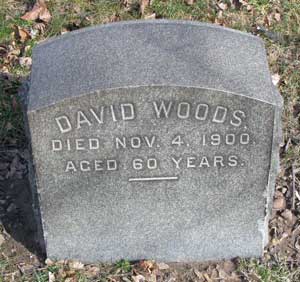
WOODS, DAVID (1840-1900). Sergeant, 79th New York Infantry, Companies B, F, and A. After enlisting as a private at New York City on February 2, 1862, Woods mustered into Company B of the 79th New York. He was promoted to corporal and transferred to Company F on unknown dates. He transferred to Company A on May 31, 1864, was promoted to full sergeant on August 1, 1864, and mustered out on February 11, 1865. In 1879, his application for an invalid pension was approved under certificate 936,026. Section 136, lot 283o7.
WOODS, FRANCIS (or FRANK) H. (1837-1899). Private, 139th New York Infantry, Company C. Woods was born in Massachusetts; his grandfather was a manufacturer of woolens in Leicester, Massachusetts. During the Civil War, he enlisted at Brooklyn as a private on September 3, 1862, and mustered into the 139th New York six days later. Thirteen months after his enlistment, he wrote this letter to his younger sister, Caroline, who was visiting her grandfather. At the time he wrote the letter, he was convalescing at Williamsburg, Virginia, and expected to be transferred to the Invalid Corps.
Camp near Williamsburg, [Va.] October 15, 1863
My Dear Sister,
Yours of the 10th was received last night and I hasten to answer it that you may receive it before you leave Northampton. Mother’s letter has been read and answered. I did send some money but I suppose it did not reach Worcester before you left as I did not send until the 27th and think it may be in Worcester if Mother has not already got it. Did Minerva say anything about writing to me? Have not received a letter from Cornelia yet but received one from Lois which I intend to answer today if possible. Did Fannie go to Northampton with you? I think you will have a nice time and hope you will stay away from home long enough to get rested as there is no necessity for being in haste to get home. I am glad you like Emma so well and trust Ed has got a good wife.
The regiment has been building winter quarters but I have not done anything yet as I still expect to go away to the Invalid Corps. The Surgeon has returned and I suppose we shall know e’re long when we shall go if we go at all. It has been so long since I was examined that it seems as though I might not go but I would like to know one way or the other soon.
I hope Mother will not be attending company all the time she is away but get a chance to rest as she must need it. Mrs. Wallace seems to be sorely afflicted and I am sorry that L. is so sick.
We do not have services in camp now as we have no place where we can hold services but we have a log chapel in process of construction and suppose those that are here this winter will have good sermons & enjoy many a winter evening in the rude structure. The chaplain has been home on a sick furlough and is now much improved in health and hope he will be able to do a great deal of good.
Our Provost Marshal [Lt. William Wilkins Disosway] was shot yesterday by one of the guard [Pvt. William Boyle]. It seems the guard had been arrested and imprisoned for some offense and upon being released he went to his camp and got some liquor and then up to the town to the Provo’s Office and told him that he had been imprisoned and that he had something to do about it and at the same time presented a pistol. When the Marshal said, “are you aware that pistol is cocked?” he answered that he was. When the Marshal jumped to take the pistol away from him, the guard fired—the ball entering the mouth and passed out the back of his head, killing him almost instantly. The Provost Marshal was a captain in the 1st New York Mounted Rifles and about 20 years of age—much beloved by all his men and had been promoted from the ranks. He had just resumed his duties after being home on a furlough. The Provost Guard was sent to the fort followed by two men with pistols cocked and with orders to fire if he attempted to escape.
I hope I shall have a cleaner sheet next time when I write and be able to write better. I received a letter from Aunt Harriet yesterday and a picture of Henry which was taken from an Ambrotype [photograph on glass]. Tell Fannie I shall not long be a stranger to her after the war closes as I intend to make a visit all around after I have got through this fighting business and shall see her then but should like to hear from her but she must not wait for me to write first. Perhaps I will send her a Waberly.
Give my regards to all where you go. Aunts, Uncles & Cousins. Write again soon to your affectionate brother, — Frank
As per Manufacturers’ and Farmers’ Journal of March 7, 1864, the above incident had an ironic ending. Private Boyle, who was convicted of murder and sentenced to be shot, had his sentence commuted by President Abraham Lincoln and sentenced to life imprisonment at hard labor. However, Private Thomas L. Abraham of Company G of the 139th New York, allowed Boyle to escape to the enemy, where allegedly he betrayed the movements of General Benjamin Butler to release the captives at Libby and Belle Isle Prisons in Richmond, thwarting that plan. For his treasonous action, Abraham was tried and sentenced to be shot at Yorktown on March 7, 1864, a measure approved by President Lincoln.
The transfer that Woods expected never happened. As per his muster roll, he was wounded in action on October 27, 1864, at Fair Oaks, Virginia, and was discharged for disability from Dale Hospital in Worchester, Massachusetts, on May 24, 1865. On June 12, 1865, he applied for and received an invalid pension, certificate 45,772.
Woods married Caroline Evarts in Brooklyn in 1866. The 1870 census reports that he lived in Brooklyn with his wife and two children and was employed as a life insurance agent. The 1875 New York State census notes that he lived in Brooklyn with his wife and children at 102 Hamilton Street, a brick house valued at $6,000, and was a house painter. The 1880 census shows that the family lived at 82 Waverley Avenue in Brooklyn; Woods was still employed as a painter. The 1890 Veterans Census confirms Woods’s service in the Civil War. His last address was 82 Waverley Avenue in Brooklyn. Caroline Woods, who is interred with him, applied for and received a widow’s pension, certificate 657,956. As per papers filed with his will by his widow, his personal estate did not exceed $3,200 in value. Section 80, lot 4246.
WOODS, ROBERT (1840-1872). Corporal, 48th New York Infantry, Company B. Woods, who was born in Canada, enlisted as a private at Jamaica, New York, on February 20, 1865, and immediately mustered into the 48th New York. He was promoted to corporal at some point before he deserted on June 28, 1865, at Raleigh, North Carolina. His last residence was 107 Eldridge Street in Manhattan. Section 115, lot 11193, grave 73.

WOODS, WILLIAM S. (or C.) (1842-1864). Captain, 5th New York Veterans Infantry, Company K; second lieutenant, 12th New York Infantry, Companies D and E. Born in Ireland, he enlisted on November 19, 1861, and mustered into Company D of the 12th New York that day. He was promoted to second lieutenant on June 27, 1862, and was placed in command of Company E on November 21, 1862. On February 16, 1864, he transferred back to Company D. He transferred into the 5th Veterans on June 2, 1864, was commissioned captain on July 12, and mustered into Company K on July 25, 1864.
Woods was killed in action at Weldon Railroad, Virginia, on August 18, 1864, and his body was left on the field, along with eight other dead Zouaves, as the 5th retreated. It was recovered soon thereafter. General Frederic Winthrop wrote to his brother five days later, “But I cannot but linger for one moment over the name of Capt. W. S. Woods, who was killed in the action of the 18th, while nobly & bravely fighting the Company. A soldier of some promise—young-dashing—brilliant and manly.” He was also borne on the rolls as William C. Woods. Section 176, lot 21852.
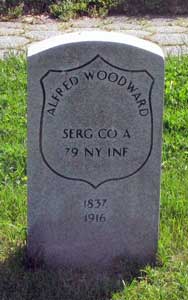
WOODWARD, ALFRED (1837-1916). Sergeant, 79th New York Infantry, Company A. Born in Birmingham, England, he enlisted as a corporal on September 1, 1861, and mustered immediately into the 79th New York, also known as the Highlanders. During his service, he was promoted to sergeant, and mustered out on September 1, 1864.
In civilian life, Woodward was a manufacturer of silverware. In 1890, his application for an invalid pension was granted, certificate 685,628. His last address was 1227 Sterling Place in Brooklyn. Rosina Woodward applied for and received a widow’s pension in 1916, certificate 811,109. Section 11, lot 5663.
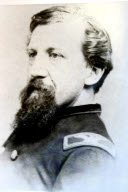
WOODWARD, JOHN BLACKBURNE (1836-1896). Colonel, 13th Regiment, New York State Militia, Company G. A Brooklyn native and brother of Robert (see), he started out in the leather business and had a long career in trade with South America, specializing in wool and hides. As per his obituary in The New York Times, he became a member of the Brooklyn City Guard in 1854, then a company of the 13th Regiment. He was also a member of the Brooklyn Excelsiors baseball team. According to Henry Chadwick, the “Father of Baseball,” the Excelsiors sent close to 90 men to fight in the Civil War. Woodward became second lieutenant of Company G of the 13th New York State Militia at the onset of the War, enlisting at Brooklyn on April 23, 1861, and commissioning in on May 14.
On May 11, he wrote to his father about the changes in men’s lives as they accommodated to the conditions at camp in Annapolis, Maryland. An excerpt follows:
…Then for our meals-Those who have been accustomed to life at hotels, or the best boarding homes, where the dropping of a spoon on the clean carpet, or the presence of a speck on plate or glass, would consign them to be washed before fit to be placed before them for use, are now to be seen with tin plate, spoon & cup, in one hand a half rusty knife and food in the other, marching up in a single file to a place at a table where a man is stationed at a tin pail from which he ladles to each in his turn a portion of soup or rice, or slice of beef or what our commissary may provide for us as they may choose. They having received their share, they retire to such a point, as they may choose, and sitting down a la Turk (for our room is destitute of chairs) eat with as much relish as if they were at Delmonico’s or Welling’s [New York’s top restaurants]….As our friends home keep sending us luxuries which will shortly arrive we hope we long to be supplied with many good things. Last evening I received a can of Fresh Peaches which were eaten with much gusto, by we officers for supper – though they hardly harmonized with the balance of our bill of fare-…
On June 19, he wrote to his father from Camp Brooklyn near Baltimore about that city:
…There is no doubt that two-thirds of the inhabitants are Secessionists and make no bones of saying so. The police are disloyal to a man. It is therefore impossible to get a decent reply from them. I asked one yesterday where Baltimore Street was, knowing at the time it was only a block off. His answer was “Just fifty-nine blocks up street.”…A great number of troops passed through here yesterday and to-day. Some big movement is on foot. Don’t know whether we are to be counted in or sent home.
He mustered out on August 6 of that year at Brooklyn. On May 28, 1862, he was commissioned as lieutenant colonel in the 13th Regiment, now part of the New York State National Guard, and mustered out on September 12, 1862, at Brooklyn. On June 20, 1863, he was commissioned as colonel of the 13th, mustering out on July 21, 1863. During that 30-day period, he wrote from camp in Caveton on July 12 of the hardships faced by his men:
…We have all sorts of rumors in camp about the place where Lee and the rebs are located. I know that they cannot be far away, for they have just left everywhere we have marched in. All the Brooklyn regiments except the Forty-seventh are here, and we are all growling about our treatment, but I suppose the “darned militia” are not worth anything anyhow. However, it does seem hard to make as many sacrifices as we have and then, when here, to be snubbed and maltreated. The three-years’ troops who are here have everything they need. We have not a single wagon. Our men are obliged to carry along, between them, their cooking utensils, mess-pans, etc. I pack my horse’s back full in order to transport what is necessary for myself, yet I have not a single change of clothes. All this I could stand if we had rations for the men. I can’t and won’t give them a single particle of extra work. In consequence we have no camp guard, and the men come and go as suits their own pleasure, but they behave well and I have no complaints to make about them. We have here a certain General Knipe, who was formerly a clerk at Harrisburg, a very gross sort of fellow, who appears to have a grudge against us Yorkers. He threatened in Harrisburg to give us —. We think he has succeeded. He says he will put us in a fight to see whether we have any pluck. Perhaps he will succeed in that. He struck one of our darkies yesterday with his riding-whip for being a little slow in entering the ford…
Woodward remained a colonel of the 13th Regiment until 1868 when he became a major general of Brooklyn’s Second Division of the New York National Guard. In 1879, Woodward was appointed state adjutant general, and retired from the National Guard the following year. In civilian life, he was president of the Third National Bank, and director of several insurance companies. He was appointed state inspector general by Governor Samuel Tilden in 1875 and in the same year was president of the Board of City Works. He ran for mayor of Brooklyn as an Independent in 1885, but lost to Daniel Whitney. A member of the Board of Park Commissioners and president of that body when it was legislated out of office in 1888, he was appointed Park Commissioner later that year. He was president of the Brooklyn City Guard Veterans’ Association and of the Art Association of the Brooklyn Institute (now the Brooklyn Museum of Art). In addition, he belonged to the Hamilton and Brooklyn Clubs and the Brooklyn Riding and Driving Club. He last lived at 259 Henry Street in Brooklyn. Section 72, lot 10915.
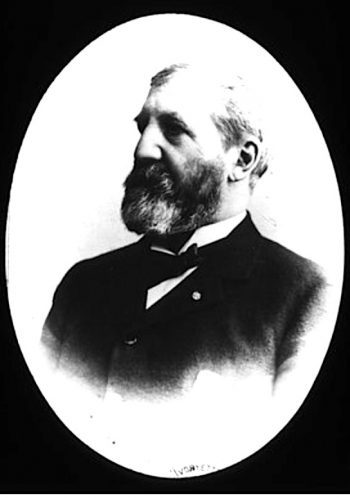
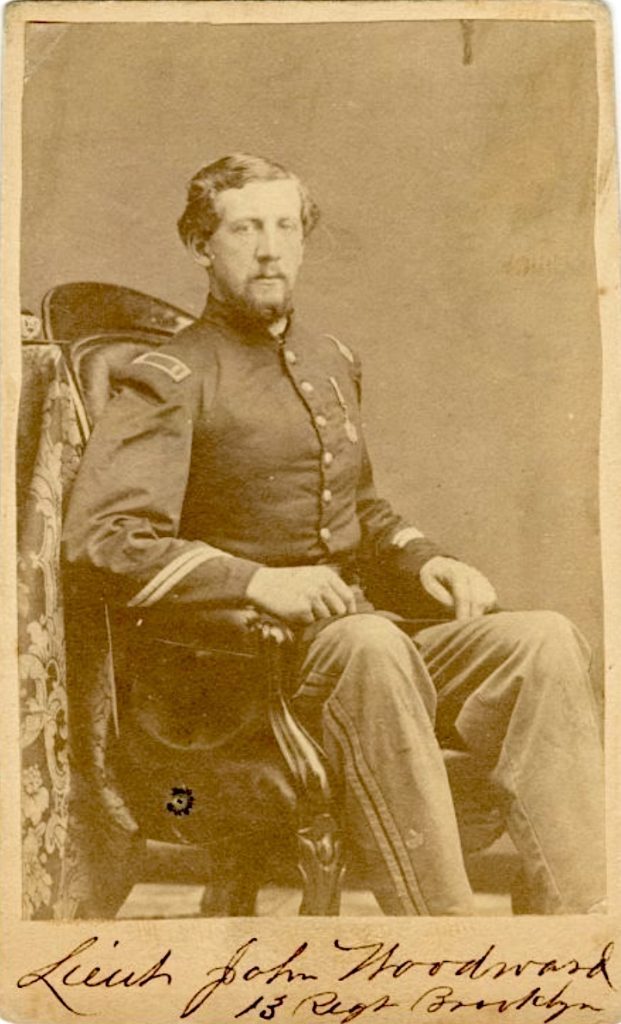
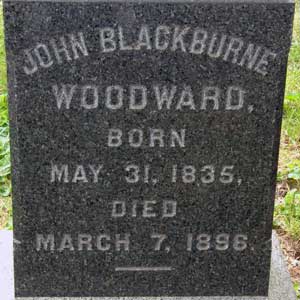
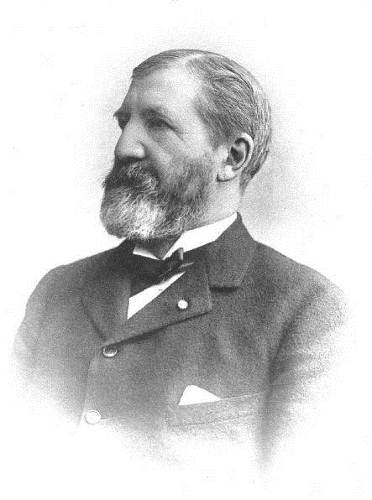
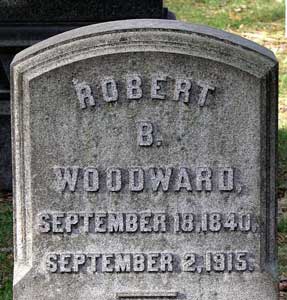
WOODWARD, ROBERT B. (1840-1915). Private, 13th Regiment, New York State Militia, Company G. A Brooklynite by birth, Woodward served with the 13th New York State Militia for three months in 1861. His brother, John B. Woodward (see), also served in the Civil War. He last lived at 118 Pierrepont Street in Brooklyn but died in Cooperstown, New York. Section 72, lot 10915.
WOODWARD, WILLIAM ROSWELL (1840-1890). Assistant paymaster, United States Navy. Born in Georgetown in the District of Columbia, he moved with his parents to Brooklyn when he was a youngster. During the Civil War, he was appointed captain’s clerk on the ironclad USS Galena. He was at the First Battle of Drewry’s Bluff in May 1862, where that ship, the Monitor, and three wooden warships were repulsed in their efforts to open the James River and the way to Richmond, Virginia. He also took part in Virginia at actions at Malvern Hill and on the retreat to Harrison’s Landing in July 1862. In May 1863, after returning from a leave issued so that he could recover from a serious illness, he was appointed acting assistant paymaster, and assigned to the Ethan Allen. He later spent most of the War with the South Atlantic Blockading Squadron. Upon his discharge, he worked in the dye-wood and drug business, then headed the wholesale firm of E. Fougera & Co. of New York City and Paris. He last lived at 72 Clinton Street in Brooklyn. Section 20, lot 17028.
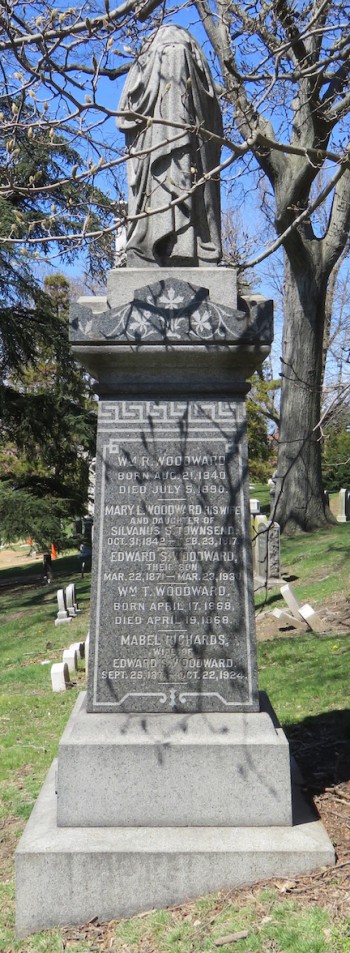
WOODWORTH, ROBERT (1816-1870). Surgeon, United States Navy. Originally from Albany, New York, Woodworth was commissioned as an assistant surgeon in the United States Navy on February 23, 1835. On December 1, 1846, he was promoted to surgeon and served in that position until he retired on May 13, 1867. His last residence was in Paris, France. Section 104, lot 10599.
WOOLEY (or WOOLLEY), HENRY CLAY (1839-1863). Private, 69th New York Infantry; 42nd New York Infantry, Company B. Born in New York and a resident of 3 Rector Street in Manhattan, he was a printer by trade. He enlisted on September 25, 1861, and mustered into the 42nd New York, known familiarly as the Tammany Regiment, having previously served in the 69th New York. While serving in the Color Guard, and carrying the flag, he was mortally wounded in the head at Gettysburg, Pennsylvania, on July 3, 1863, and died there three days later. Wooley was interred at Green-Wood on July 17, 1863, where a color bearer is carved on his tombstone. Section 115, lot 13536 (Soldiers’ Lot), grave 63.
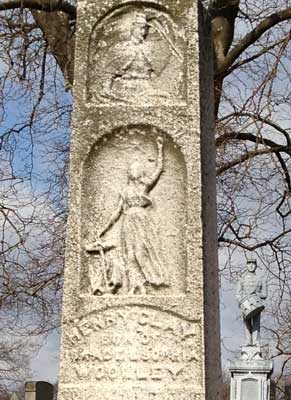
WOOLEY, WALKER T. (1837-1899). Major, 90th New York Infantry, Company H. Born in Carmel, New York, he enlisted at New York City as a private on October 2, 1861, and rose through the ranks. Upon his enlistment he mustered into Company H of the 90th New York. He was promoted to second lieutenant on December 14, 1861, and to first lieutenant on April 10, 1862. On January 1, 1863, he became a first lieutenant and adjutant. On October 6, 1863, he was transferred to the Field and Staff and was promoted to major on December 1, 1864, but did not muster in at that rank. He mustered out on February 9, 1866. He last lived at 69 Lafayette Avenue in Passaic, New Jersey. Section 99, lot 13939, grave 4.
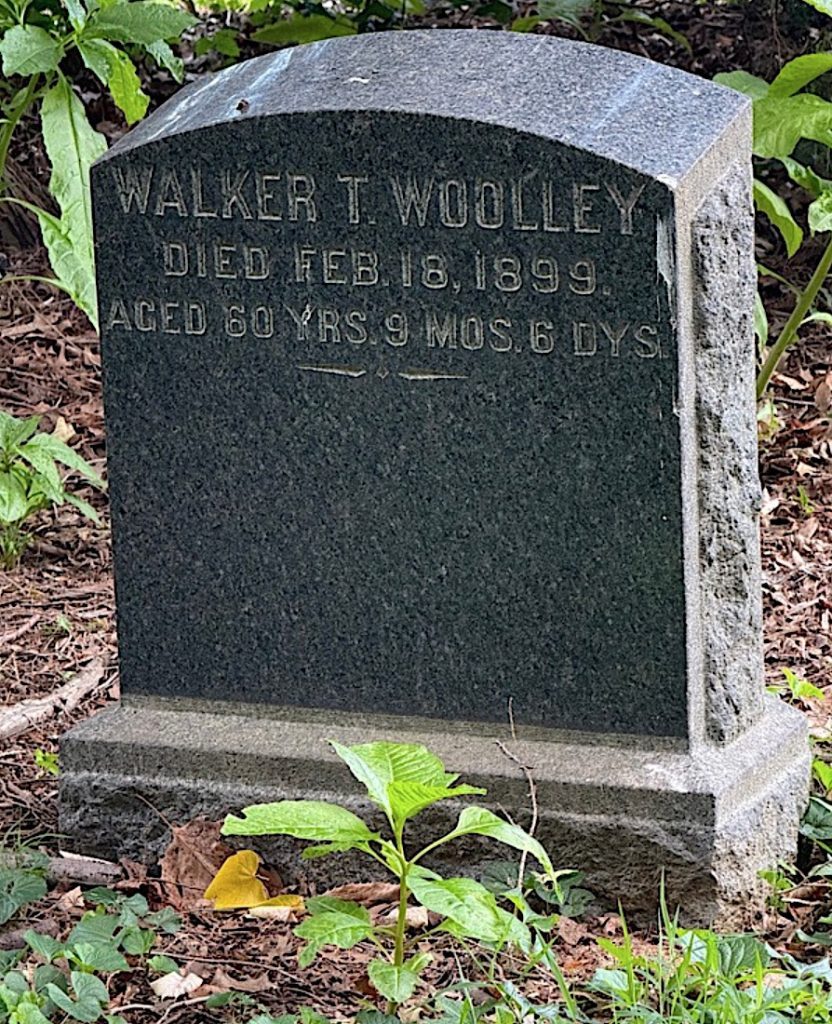
WOOLLEY, JR., THOMAS T. (1844-1931). Private, 30th New Jersey Infantry, Company C. Originally interred at Green-Wood, his remains were removed from the cemetery on April 18, 1966, and re-interred at Hazelwood Cemetery in Rahway, New Jersey. A native of Springfield, New Jersey, Woolley enlisted as a private on September 3, 1862, mustered into the 30th New Jersey on September 17, and mustered out on June 27, 1863, at Flemington, New Jersey. In 1880, his application for an invalid pension was approved, certificate 447,687. He last lived at 676 Prospect Place in Brooklyn.
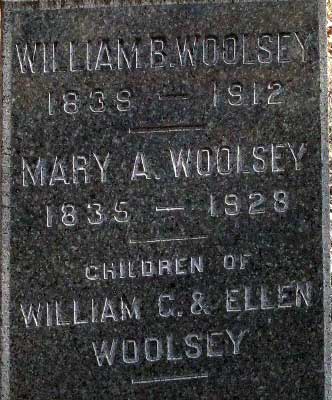
WOOLSEY, WILLIAM BERRY (1839-1912). Seaman, United States Navy. A Brooklyn native, 4’8″ in height and described as a hunchback, he enlisted May 31, 1861, at the Brooklyn Navy Yard. Despite his physical limitations he served on board the USS North Carolina, a receiving ship for new naval recruits stationed at the Brooklyn Navy Yard. He was discharged for physical disability on November 30, 1861, weighing only 90 pounds.
In 1907, Woolsey applied for and received a pension, certificate 40,742. In letters to the Pension Bureau, he was referred to as a “dwarf,” but it was noted that he “was born a badly deformed hunchback.” He last resided at 521 Washington Avenue, Brooklyn. Section 54, lot 11640, grave 2.
WOOLSTENCROFT (or WILSONCROFT), ALFRED (1835-1890). Private, 84th New York (14th Brooklyn) Infantry, Company C. A native of Manchester, England, he served in the British Army before coming to the United States in 1859. He enlisted as a private at Brooklyn on April 18, 1861, and mustered into Company C, 14th Brooklyn, on May 23. He was captured at the Battle of Bull Run, Virginia, on July 21, 1861. After spending ten months and ten days in Libby Prison, he was exchanged on June 2, 1862, at Washington, D.C. According to his obituary in the Brooklyn Daily Eagle, he then volunteered for the Navy in a response to a call for men. No details of his Navy service are known.
After the Civil War, Woolstencroft established a retail hat store in a basement on lower Fulton Street, Brooklyn, under the name James Turnbull, eventually expanding the business into 37, 39 and 41 Fulton Street. He used the name James Turnbull in civilian life, too. His obituary noted his unusual business practice of keeping no books, using only cash transactions and making purchases only when he had money to replenish his stock. He became a naturalized citizen in 1880. His last residence was 41 Fulton Street, Brooklyn. Section 198, lot 27203.
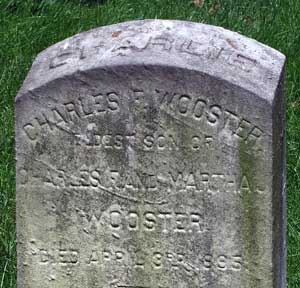
WOOSTER, CHARLES F. (1837-1883). Second lieutenant, 71st Regiment, New York State National Guard, Company E; private, 83rd New York Infantry, Company F. Born in Pennsylvania, Wooster enlisted into the 83rd at New York City on May 27, 1861, mustered in on that date, and was later discharged. On May 28, 1862, at New York City, he enlisted as a second lieutenant, was commissioned into the 71st Regiment’s National Guard, and mustered out after three months on September 2 at New York City. On June 30, 1863, he returned to service with the 71st Regiment, was commissioned into the same company, and mustered out the next month on July 22 at New York City. He last lived on 155th Street and 10th Avenue in Manhattan. Section 171, lot 14769.
WORCESTER, FRANKLIN E. (1837-1897). Sergeant, 71st Regiment, New York State Militia, Companies B, E, and H. A native of Albany, New York, Worcester served for three months as a corporal with the 71st Regiment’s Company B when it was activated in 1861. His obituaries in the Brooklyn Standard Union and in The New York Times provide further details on his service but not on his rank. The New York Times, which indicates his rank as first lieutenant, reports that he was captured at the Battle of First Bull Run, Virginia, and incarcerated at Libby Prison in Richmond, Virginia; that imprisonment is verified by the Regimental Honor Roll which also states that he was wounded there. The Brooklyn Standard Union, which notes that he rose to captain, reports that he was also wounded at the Battle of Antietam, Maryland, and imprisoned at both Libby and Salisbury, and released in June 1862. Another record shows that he re-enlisted as a captain on June 17, 1863, was commissioned into Company E of the 71st Regiment on June 30, and mustered out with his company on July 22, 1863, at New York City. His pension index card indicates that he last served in Company H of the 71st Regiment. There is apparent confusion about his rank; although some sources report that he was a captain, it appears that he first enlisted as a corporal and may have been promoted to sergeant.
Prominent in the railroad business, Worchester was at one point treasurer of the Manhattan Elevated Railway Company and then connected with the West Shore road. He was associated with groups in the Midwest connected to the Elgin, Joliet and Eastern Railroad and with capitalists who built the Chicago elevated system. At some point, he was a member of the New York Stock Exchange. He was a member of the Brooklyn Club. He last lived at 1015 Butler Street in Brooklyn. Elizabeth Worchester, who is interred with him, applied for and received a widow’s pension in 1897, certificate 660,018. Section 194, lot 29772.
WORDEN, ALFRED W. (1836-1891). Private, 106th New York Infantry, Company F. Originally from Albany, New York, he enlisted as a private on Mamakating, New York, on September 28, 1864, and mustered into the 106th New York two days later. An express agent by trade, his muster roll records that he was 5′ 8½” tall with blue eyes, dark hair and a florid complexion. He mustered out with his company on June 22, 1865, at Washington, D.C.
As per the New York City Directory for 1877, Worden was a policeman. In 1890, he applied for an invalid pension, application 941,788, but it was never certified. His military history is validated in the New York State Archives by Town Clerks’ Registers of Men Who Served in the Civil War, 1861-1865. He last lived in New York. After his death, his wife applied for and received a widow’s pension, certificate 338,628. Section 135, lot 27263, grave 2109.
WORRALL (or BARRALL), HENRY (1835-1898). Private, 5th New York Regiment, Company G. A New York City native, he was the eldest son and one of nine children born to Noah and Angelina McDermut Worrall. As per the 1850 census, which spells the family surname as “Barrall,” he was a 15-year-old living in New York City with his parents, six siblings, maternal grandfather and a servant. The 1855 New York State census reports that Henry was still living in New York City with his parents, six siblings and a servant.
On November 16, 1858, Worrall applied for a passport. He described himself as 5′ 3″ tall with gray eyes, large nose, high forehead, large mouth, sharp chin, brown hair, sallow complexion and oval face. At the time of his enlistment, as per a researcher of the 5th Regiment, he resided at 60 Beach Street in New York City and in Morristown, New Jersey, where he worked with his brother-in-law in the dry goods trade. That researcher reports that Worrall also worked for the United States State Department at some point prior to his service.
Worrall enlisted as a private on May 12, 1861, and mustered into Company G of the 5th Regiment. His muster roll indicates that he was 5′ 4½” tall with blue eyes, brown hair, light complexion and was employed as an accountant. At the time of his departure from New York City, when the colors were presented, he collapsed. He then took sick and fell out of the line of march to Big Bethel, Virginia, on June 10, 1861, and was discharged for general debility and sunstroke at Camp Hamilton, Virginia, later that month, on June 27. After Worrall returned to civilian life, he was an accountant in the family business, a tool and iron foundry. The 1870 census shows that Worrall and his 26-year-old brother were living with their parents in New York City; his brother and father were listed as iron founders but no occupation is listed for him. The 1876 Brooklyn Directory shows that Worrall was living at 90 1st Place in Brooklyn. Although he applied for an invalid pension in 1879, application 302,553, citing that he was “crippled and depended on others,” his application was denied. At the time of the 1880 census, he was single and living with his extended family at 90 1st Place in Brooklyn. The family was comprised of his brother, Lawrence (head of household) and his wife, his mother, and another brother, John, and his wife. The 1880 census notes that Henry Worrall was disabled and paralyzed. In 1887, he still was living at the same address. He last lived at 228 West 135th Street in New York City. His death was attributed to phthisis. Section 57, lot 1575.
WORSTELL, FRANK W. (1842-1913). Acting ensign, United States Navy. A native of Ohio, Worstell enlisted in the United States Navy on December 8, 1863. He was a mate on board the USS Tacony, was promoted to acting ensign on January 11, 1865, and resigned on April 11, 1866. His application for a Navy pension was granted, certificate 40,049. Worstell was a member of G.A.R. Noah L. Farnum Post #458; as per his obituary in the New York Herald, comrades were invited to attend his funeral. The census of 1910 confirms his residence and birthplace. His last residence was 116 West 70th Street in Manhattan. His wife applied for and received a widow’s pension under certificate 771,344. Section 184, lot 25568, grave 1.
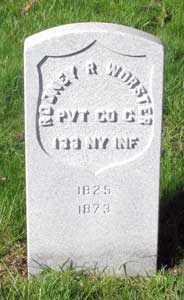
WORSTER, RODNEY R. (1825-1873). Private, 133rd New York Infantry, Company C. Born in Vermont, Worster enlisted at New York City as a private on August 19, 1862, mustered into the 133rd New York on September 24, and was discharged for disability on January 16, 1865, at New York City. His last residence was 411 West 44th Street in Manhattan. Section 17, lot 17245, grave 136.
WRAY (or RAY), WILLIAM (1841-1887). First sergeant, 66th New York Infantry, Company H; Veteran Reserve Corps. Born in Convoy, a town in Donegal County, Ireland, Wray was listed as a marble cutter in the 1860 census. During the Civil War when he was borne on the rolls as William Ray, he enlisted as a corporal at New York City on September 20, 1861, and mustered into the 66th New York on November 4. On or about July 30, 1862, he was promoted to sergeant, and then became a 1st sergeant on January 21, 1863. He was transferred into the Veteran Reserve Corps on February 24, 1864, from which he mustered out on an unknown date.
In his Petition for Naturalization, dated 1866, Wray identified himself as a marble cutter living at 263 Seventh Avenue in New York City. His petition was granted. In 1880, he reported his occupation as assistant engine on the City Fire Department. According to his descendant, he was a captain in the New York City Fire Department. He last lived at 350 West 17th Street in Manhattan. Wray died from abdominal problems at the 99th Street Hospital in New York City. One source on his family tree indicates that his death occurred after he fell off a fire truck. Section 2, lot 5499, grave 347.
WREDE, GUSTAVUS S. H. (1841-1887). Sergeant, 6th New York Heavy Artillery, Company B. A Prussian native, Wrede enlisted as a private at Scarsdale, New York, on August 20, 1862, and mustered into Company B of the 6th New York Heavy Artillery on September 2. He was promoted to corporal on April 30, 1863, and then to sergeant on August 31, 1864, before mustering out at Petersburg, Virginia, on June 28, 1865. He last lived at 341 East 14th Street in Manhattan. Wrede died of phthisis. In 1916, his wife applied for and received a widow’s pension, certificate 896,907. Section 186, lot 18584.
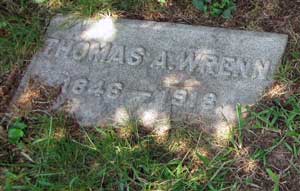
WRENN, THOMAS A. (1846-1918). Private, 167th Ohio Infantry, Company G. Born in Middletown, Ohio, he enlisted as a private on May 2, 1864, and mustered into Company G of the 167th Ohio National Guard on May 14. The company was composed of recruits from Butler County, Ohio. Four days later, the regiment left for Charleston, West Virginia, and from there was moved to guard supply trains and stores at Camp Piatt and Gauley Bridge. Wrenn mustered out with his regiment at Hamilton, Ohio, on September 8 of that year.
After the War, Wrenn was a commission merchant in Cincinnati, Ohio, where his family owned a flour and grain business. He was also well-respected in the Chamber of Commerce there. Moving East at the end of the century, he continued in his profession and was a member of the New York Produce Exchange. He settled in Cranford, New Jersey, in 1899, and last lived there at 22 Cranford Avenue. In 1908, his application for a pension was granted, certificate 1,149,441. Bonnie Wrenn applied for and received a widow’s pension after his death in 1918, certificate 873,234. Section 135, lot 35055, grave 2.
WRIGHT, ALFRED S. (1815-1880). Private, 48th New York Infantry, Companies C and K. After Wright enlisted at Brooklyn as a private on August 23, 1861, he mustered into Company C of the 48th New York three days later. He was transferred to Company K before he was discharged for disability on July 29, 1862. He died at County Hospital in Manhattan. His widow was granted a pension in 1883, certificate 287,928. Section 126, lot 5047, grave 270.

WRIGHT, CHARLES W. (1827-1870). First lieutenant, 5th New York Infantry, Company G. Wright was a veteran of the Mexican War before enlisting as a private on May 10, 1861, at New York City. He was promoted to sergeant on June 3 and to first sergeant four days later before mustering in on June 28. He rose through the ranks becoming a second lieutenant on August 20, and a first lieutenant on November 4. He resigned on February 6, 1862, citing poor health. He last lived on 83rd Street in New York City. Section 15, lot 17263, grave 149.


WRIGHT, DAVID F. (1840-1911). Captain, 51st New York Infantry, Company B; 7th Regiment, New York State Militia, Company C. Wright, who was born in Manhattan, was the brother of Brevet General John G. Wright who also served with the 51st. After serving in the 7th New York State Militia when it was activated from April 18-June 3, 1861, he re-enlisted as a first lieutenant on August 25, 1861, and was commissioned into the 51st New York three days later. He was promoted to captain on September 28, 1862, fought with the Army of the Potomac, and was discharged on October 12, 1864. As per his obituary in the New York Herald, which confirmed his Civil War service, he took part in thirty battles and engagements.
Prominent in the real estate business, Wright lived in Brooklyn for thirty years and was a member of the Lotos Club. Remaining active in military affairs, he was a member of the Lafayette Post #140 of the G.A.R. and the 7th Regiment Veterans’ Association. As per his obituary in the Brooklyn Daily Eagle, comrades from the 7th Veterans were invited to attend his funeral. He last lived at 461 Washington Avenue in Brooklyn. His widow, Lucy A. Wright, was granted a pension, certificate 724,140, and is buried in the same lot with him. Section 11, lot 3812.
WRIGHT, DAVID J. (1842-1862). Hospital steward, 12th Regiment, New York State National Guard, Company H. Wright, a native of New York, lived with his parents at 130 West 20th Street in Manhattan when he enlisted as a private in the 12th Regiment in 1862. The regiment mustered in for three months on May 31, and left for Harpers Ferry. He was promoted to hospital steward during his service and died of typhoid fever in Harpers Ferry, (now West Virginia), on August 26, 1862. His name appeared on the Bodies in Transit List (bodies being shipped through New York). As per his obituary in The New York Times, his comrades were invited to attend his funeral . Section 81, Lot 4934.
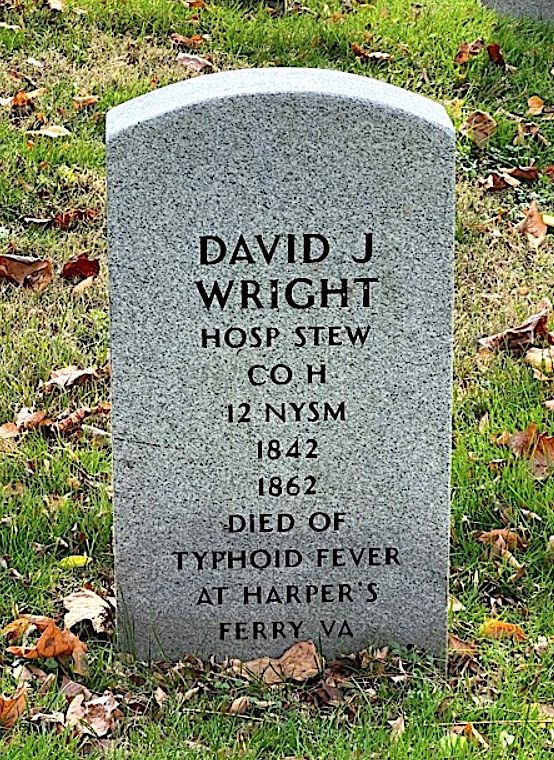
WRIGHT, EDWARD (1825-1895). Private, 65th New York Infantry, Company G. A native of New York State, Wright was also borne on the rolls as Edward Wight. After enlisting at New York City as a private on September 4, 1861, he mustered into the 65th New York that same day, and was discharged for disability at an Army Convalescent Camp in Virginia on February 6, 1863. According to the 1870 census, he was a blacksmith living in Manhattan. In 1884, he applied for an invalid pension that was granted under certificate 882,755. He last resided at the Taylor Hotel in New York City. Section 126, lot 5047, grave 1002.
WRIGHT, EDWARD MAXWELL (1845-1880). Cadet, United States Military Academy. Edward was born on September 20, 1845, in Indiana. His father, John W. Wright was a judge.
He entered West Point in 1862, appointed from Indiana. However, his family tree on Ancestry.com indicates active service in the military early in the Civil War, noting that an Edward M. Wright served as a first lieutenant in Company C of the Illinois Light Artillery in 1861. However, the age at enlistment for that lieutenant doesn’t match Edwards’s age at that time, so it is unlikely that that is him. Wright was an 1866 graduate of the United States Military Academy and was appointed second lieutenant in the United States Army as of June 18 of that year. His obituary in the Philadelphia Inquirer details that he was number 12 in his graduating class.
Wright’s career as an officer in the Ordnance Department in Chicago, Illinois, commenced on August 7, 1866. By October 1866, he was assigned to the Washington Arsenal in the nation’s capital. As of November 1867, Edward was reassigned to the Georgia Arsenal as a second lieutenant and was back in D.C. in 1869. He then was relocated to the Rock Island Arsenal in Illinois as of November 1871 and moved to the Frankford Arsenal in Philadelphia as of November 10, 1875. Wright received promotions to first lieutenant on June 23, 1874, and captain on March 25, 1876. The Philadelphia Inquirer details that he also served at the Watertown, Massachusetts Arsenal and was with General Hancock during the railroad disturbances in 1877. His obituaries describe his expertise and contributions to the Ordnance Corps, including inventions that improved guns and missiles as well as experimental study.
As per his online genealogy on the Ancestry website, Edward had three marriages. His first, on July 7, 1862, in Chicago, was to Lavinia B. Slaymaker (1826-1908); that marriage was reported in the Chicago Tribune. After that marriage ended, he married Mary Lane Ketchum in Stamford, Connecticut on June 29, 1867. Mary died in 1873; her name and his are on his gravestone. His third marriage on March 7, 1878, in Washington, D. C., was to Elizabeth “Bessie” Duval Paschal.
Edward’s died in Washington, D.C., on April 24, 1880, by suicide. The Evening Star, a Washington, D.C. newspaper, reported that he had come to his father’s residence at 4400 M Street, suffering from “ill spirits” and depression and was under the care of an Army physician. His brother checked on him the morning of his death but then heard a pistol shot and thereupon found Edward dead, with a Smith & Wesson pocket pistol in his hand, and a bullet through his head. The paper reported that he was separated from his wife Bessie and had a child from his first marriage (not mentioned on the family tree). He was survived by his parents and four brothers, two of whom lived in D.C.
Elizabeth Paschal O’Connor filed for a remarried widow’s pension, citing Edward’s service as a captain of ordnance, application 1,037,226. Section 161, lot 15065.
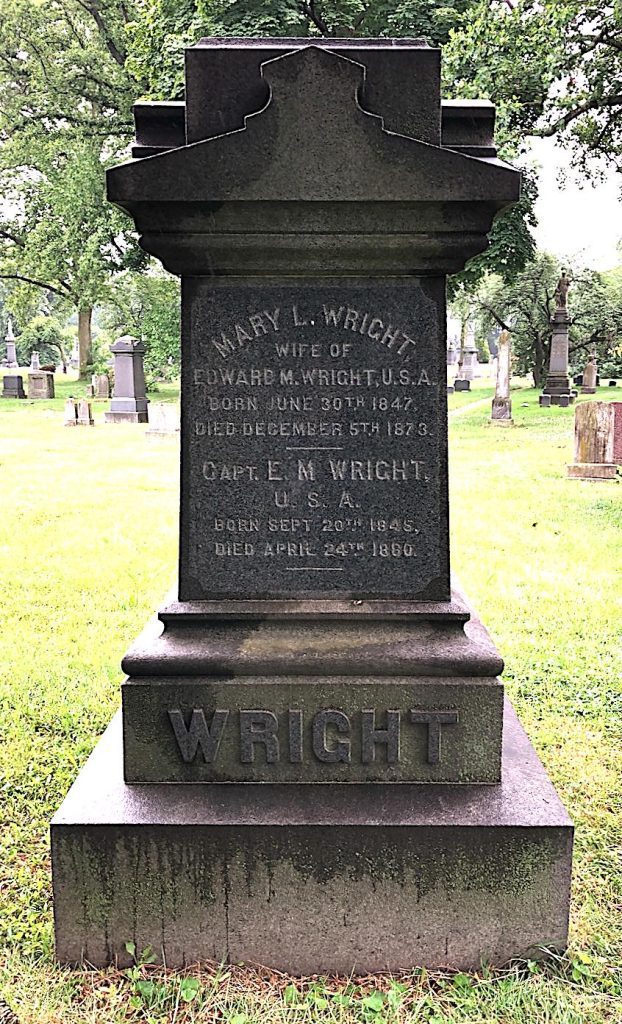
WRIGHT, HARRY (1840-1890). First lieutenant, 178th New York Infantry, Companies B, E, and D. After enlisting as a sergeant major at New York City on June 6, 1863, he mustered into the Field and Staff of the 178th New York. He was promoted to first lieutenant and transferred to Company B on April 10, 1864, subsequently transferred to Company E on February 21, 1865, and then to Company D on August 2. Wright mustered out on April 20, 1866, at Montgomery, Alabama. His last residence was 79 Adams Street in Brooklyn. Section 60, lot 1007.
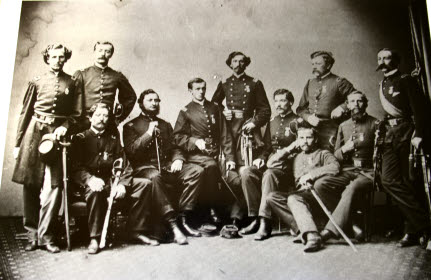
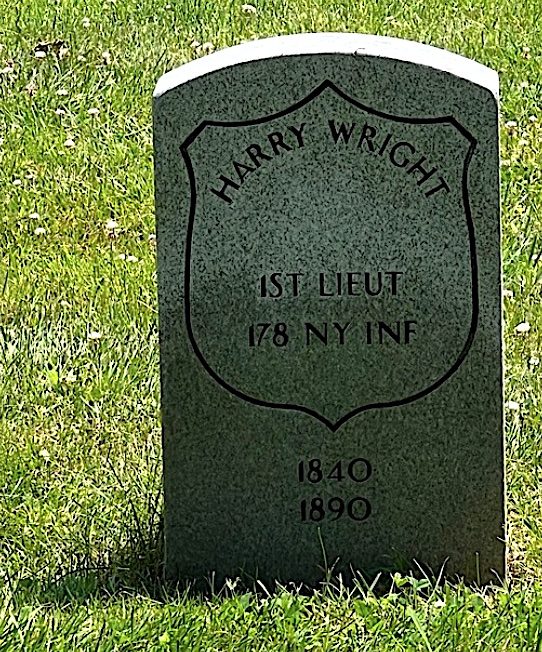
WRIGHT, JAMES A. (1837-1891). Unknown soldier history. Wright served in the Civil War and was a member of the G.A.R., an organization for veterans of that conflict. Details of his military career are not known. His last address was 63 Jefferson Avenue in Brooklyn. Section 134, lot 27263, grave 1183.
WRIGHT, JOHN (1843-1896). Private, 54th New York Infantry, Company H. A native of Ireland, Wright transferred into the 54th New York on June 22, 1865, and mustered out on April 12, 1866, at Charleston, South Carolina. Further details are unknown. On October 24, 1877, he joined the Grand Army of the Republic. He last lived at 208 East 22nd Street in Manhattan. Section 2, lot 5499, grave 100.
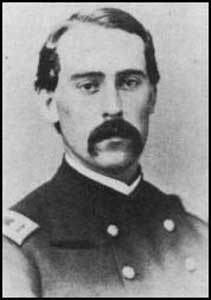
WRIGHT, JOHN GIBSON (1837-1890). Brigadier general by brevet; colonel, 51st New York Infantry, Company A; private, 7th Regiment, New York State Militia, Company C. Originally interred at Green-Wood, his remains were removed from the cemetery on an unspecified date. After enlisting at New York City as a private on April 26, 1861, Wright, a native of New York, mustered into Company C of the 7th New York State Militia and mustered out on June 3. He re-enlisted at New York City as a private on August 20, 1861, was promoted to captain that same day, and was commissioned into Company A of the 51st New York, known familiarly as the Shepard Rifles, on October 8 of that year. He took part in Burnside expedition to North Carolina where he fought in the Battles of Roanoke and New Berne. He rose to major on March 14, 1863, and engaged in many Virginia battles including: Wilderness, Spotsylvania, Cold Harbor, Jones’s Farm, Bethesda Church and Totopotomoy Creek.
Wright was taken as a prisoner of war on September 30, 1864, at Poplar Grove Church, Virginia. He was imprisoned at Libby Prison in Richmond, Virginia, and at Salisbury, North Carolina, and Danville, Virginia, before being exchanged and returned two days after Lee’s surrender. Wright became lieutenant colonel on December 31, 1864, brigadier general by brevet on March 13, 1865, and colonel on May 18, 1865. He mustered out on July 25, 1865, at Alexandria, Virginia. During his service, he suffered minor injuries at Antietam, Maryland, and at Fredericksburg and Petersburg, Virginia, and performed the duties of assistant adjutant general, assistant and inspector general, provost-marshal, and assistant engineer (supervising the earthworks at Petersburg) on General Burnside’s staff. After the war, he lived in Holyoke, Massachusetts, where he was a member of the Kilpatrick Post #71 of the G.A.R. His obituary in The New York Times lists him as a member of the Ransom Post of the G.A.R. and the Loyal Legion. Wright died in New York City.
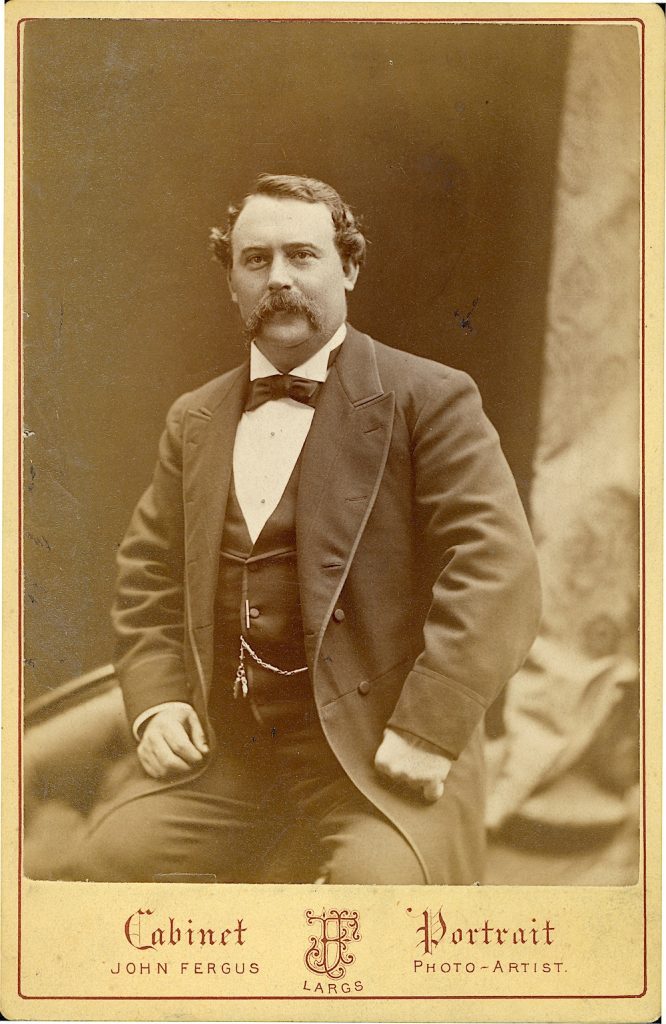
WRIGHT, RICHARD WEST (1837-1913). Corporal, United States Marine Corps. A native of Philadelphia, Pennsylvania, Wright enlisted there on August 12, 1864, and served in the United States Marine Corps aboard the USS Vanderbilt. He was at Fort Fisher, North Carolina, before his discharge at Philadelphia on September 16, 1865.
He resided in Brooklyn after the Civil War. In 1894, he filed for and received a pension from the Navy, certificate 26,181. Wright re-enlisted in the United States Navy on October 15, 1902, where he was on special assignment as a chief machinist on the USS Columbia, then served in the same capacity on the USS Hancock before his discharge on August 3, 1905. He moved into the Soldiers’ Home in Hampton, Virginia, in October 1907, and subsequently lived in Soldiers’ Homes in Ohio and Tennessee where he died on September 9, 1913. At the time of his death, his pension was $22.50 per month.
Originally buried in “The Circle” at the Tennessee home, his son, Benjamin Wright, wrote to the Commissioner of Pensions four days later requesting funds and stating his intention to move and reinter his remains at the family’s burial ground at Green-Wood. Benjamin Wright asked for the $67.50 due upon his death to carry out his burial plans. Section ?, lot ?.

WRIGHT, THERON O. (1837-1923). Rank unknown, 23rd Regiment, New York State Militia. Wright was born in Somers, New York. According to his obituary in The New York Times, Wright was a Civil War veteran who served in the 23rd New York State Militia, starting in 1857 and continuing throughout his lifetime. The Brooklyn Directories for 1862 and 1864 indicate that he was a clerk; the New York City Directory for 1877 lists him in the flower business. A Brooklyn resident for 74 years, he was connected with a millinery establishment in Manhattan. At the time of his death, he was with his son in Dover, Massachusetts. Section 193, lot 27486, grave 3.
WRIGHT, WILLIAM (1840-1861). Private, Fremont’s Body Guard Cavalry Missouri Volunteers, Company B. After enlisting and mustering on August 20, 1861, at St. Louis, Missouri, he was killed on October 25, 1861, at Springfield, Missouri, during “Zagonyi’s Charge” on the Confederate’s Missouri State Guard positions. Although he died in 1861, his remains were interred at Green-Wood on February 26, 1872. Section 11, lot 3812.
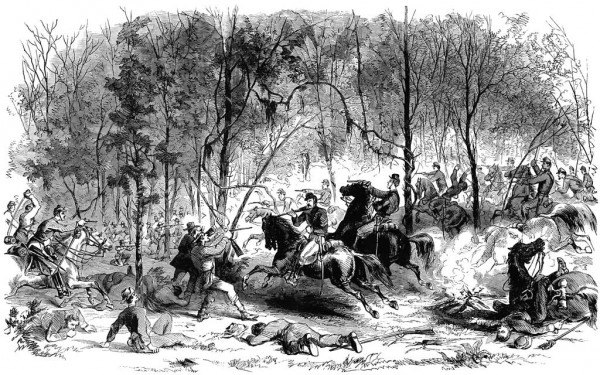
“Second charge upon the Confederates by General Fremont’s bodyguard, under Major Zagonyi, near Springfield, Mo., on October 25th, 1861. After the first charge of Major Zagonyi, described on another page, Captain McNaughton reached the scene with fifty men. The order to follow retreating Confederates was given, and all dashed ahead for a second charge through the woods. Many of the fugitives were overtaken there, as well as in the streets of Springfield and in the forest beyond the city. Only when further pursuit seemed useless did the Federals return. Zagonyi’s brave followers suffered a loss of eighty-four dead and wounded in this engagement, which, for the boldness of its undertaking and the rapidity of its execution under the great disparity of numbers, certainly has but few parallels in any history.”— Frank Leslie, 1896
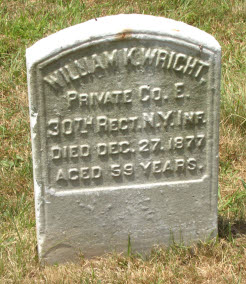
WRIGHT, WILLIAM K. (1818-1877). Private, 30th New York Infantry, Companies G and E; 16th New York Heavy Artillery, Company B. Wright enlisted as a private on April 26, 1861, at Poughkeepsie, New York, where he resided. He mustered into Company G of the 30th New York on June 1, was transferred to Company E on October 9 of that year, and mustered out June 18, 1863, at Albany, New York. After re-enlisting on September 26, 1863, he mustered into the 16th New York Heavy Artillery, and mustered out on August 21, 1865, at Washington, D.C. Wright last lived at 300 South 3rd Street in Brooklyn. His government-issued gravestone, circa 1900, confirms his service in the 30th New York. Section 122, lot 17806, grave 213.
WRIGHTINGTON, WILLIAM R. (1843-1924). Private, 45th Massachusetts Infantry, Company K. A clerk who resided in Boston, Massachusetts, Wrightington enlisted as a private on September 30, 1862, mustered into the 45th Massachusetts on October 7, and mustered out on July 7, 1863, at Readville, Massachusetts. The 1877 New York City Directory reports that he was in the sponge business. In 1906, he filed for an invalid pension that was granted, certificate 1,125,303. His last residence was 108 West 103rd Street in Manhattan. Section 163, lot 14752.
WRINNICK, CHARLES A. (1843-1882). First lieutenant, 84th Infantry, United States Colored Troops, Companies A and K; second lieutenant, 102nd New York Infantry, Company G; private, 90th New York Infantry, Company D. Charles was born in Prussia and immigrated to New York State.
At the age of 21, as per his muster roll, he enlisted in the 90th New York Infantry on September 2, 1861, at Kingston, New York; he is listed there as 21 years of age. He mustered that regiment’s Company D, as a private, on October 4. However, he was discharged from the 90th on November 1, and, on November 6, 1861, he enlisted at Rondout, New York, as a sergeant in the 102nd New York Infantry. Nine days later, he mustered into Company G of that regiment as a sergeant. Promoted to second lieutenant on January 1, 1863, at Aquia Creek, Virginia, he was commissioned at that rank later that month, with his rank backdated to October 28, 1862. He soon resigned and was discharged on May 14, 1863. But his Civil War service was not yet done: on October 1, 1863, he re-enlisted, this time in the 84th United Stated Colored Troops, as a first lieutenant, and mustered in that same date at Port Hudson, Louisiana. No discharge date appears on his records. The United States Colored Troops were regiments of men of color who, up until their enlistment might have been free or enslaved, but as of 1863, were allowed to serve in the Union armies. The officers of those U.S.C.T. regiments were almost all white, with just a few exceptions. About 180,000 men of color served in the U.S.C.T.
After his service, Charles came to Brooklyn and went into business as Stegman & Wrinnick. That firm was dissolved in 1866. In the 1870 Brooklyn Directory, he is listed as a clerk living at 2 Elm Place. According to the 1875 New York State census, Charles was living with his wife Evelyne and his children, Allan, George, and Charles, at 284 Flatbush Avenue, a brownstone. Charles was working as a clerk in a coal yard and may have been a naturalized citizen. In the 1881 Brooklyn Directory, he appears as a clerk living at 394 Wyckoff Street.
In 1878, Charles applied for an invalid pension, based on his Civil War service. That pension was approved, certified as 168,702. His pension index card confirms his service in the 102nd New York Infantry, Company G, and as a lieutenant in the 84th United States Colored Troops, Companies A and K. Soon after his death, a granddaughter, Harriet J. Moore, applied for a survivor pension; it was approved and certified as 201,612.
By 1878, Charles was working as an agent for the Society for the Prevention of Intemperance and Crime. The Brooklyn Daily Eagle of February 24 of that year reported that he and another agent “have recently been searching the premises of liquor dealers without any legal authority to do so.” The report added that they had now turned their attention to “druggists selling rock candy and whisky in violation of the Excise Law.”
On June 19, 1880, apparently neither feeling well nor prospering, he advertised in the Brooklyn Daily Eagle for a “half plot at Greenwood Cemetery.” He gave his return address as the coal office at 25 Atlantic Avenue.
On June 29, 1880, his name appeared as a reference for an enterprise advertised in the Brooklyn Daily Eagle:

Charles died on June 11, 1882. His death certificate recorded that he was born in Germany, was married, last lived at 125 South Elliott Place in Brooklyn, and that he worked as a clerk. Green-Wood’s burial records noted that he died from phthisis (now termed pulmonary tuberculosis). His wife, Evelyne, just 30 years old, died just four months later of the same very communicable disease, and was interred next to him in the full lot that they owned at Green-Wood. Section 71, lot 1856.
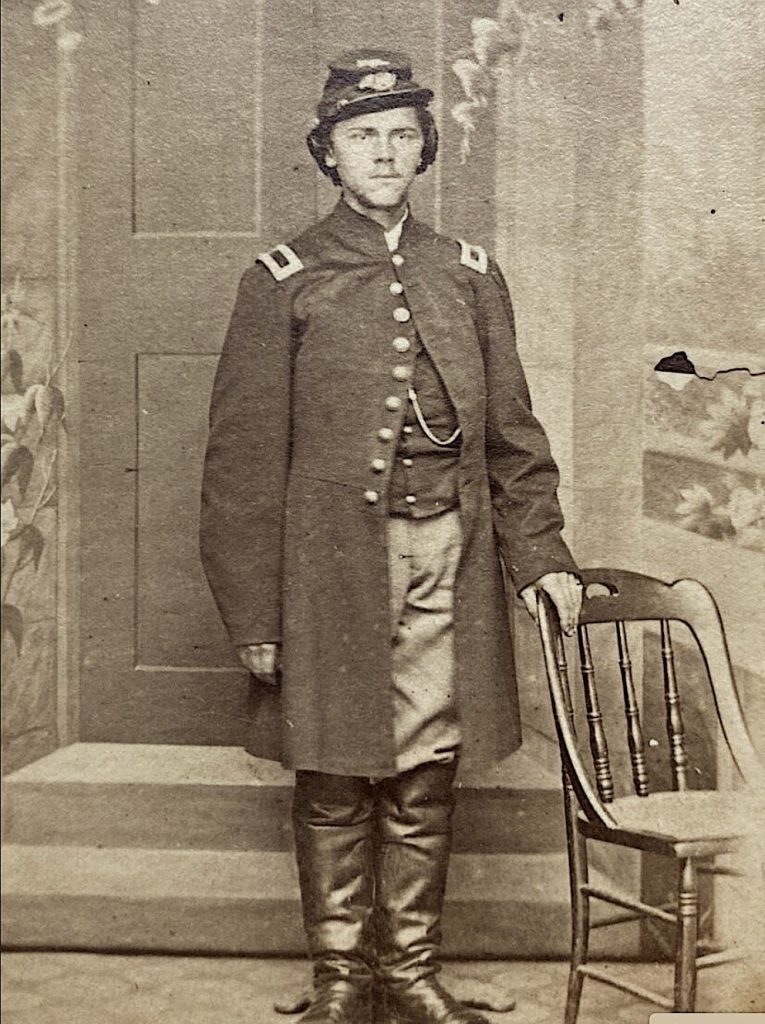
WUNDERLICH, JOHN (1827-1876). Private, 6th Regiment, New York State Militia, Company F. Of German origin, Wunderlich served for three months in the 6th Regiment when it was activated in 1861. At the time of his death, he was listed in the New York City Directory as a candymaker. He last lived at 234 East 41st Street in Manhattan. Section 204, lot 27886, grave 1.
WURM (or WUNN), JULIUS (1821-1899). Musician, 45th New York Infantry, Band. Born in Brunswick, Germany, he enlisted at age 38 as a musician on September 9, 1861, at New York City, mustered into the band of the 45th New York on September 28, and mustered out on June 16, 1862.
In civilian life, Wurm became a well-known hotel keeper whose establishment was located near Green-Wood Cemetery; his son took over the business after he retired in 1889. He joined the Thatford Post #3 of the G.A.R. on June 22, 1892; as per his obituary in the New York Herald, comrades were invited to attend his funeral. His last residence was 759 Fifth Avenue (corner of 20th Street) in Brooklyn. After his death in 1899, Matilda Wurm, who is interred with him, applied for and received a widow’s pension, certificate 509,511. Section 144, lot 26683, grave 2.
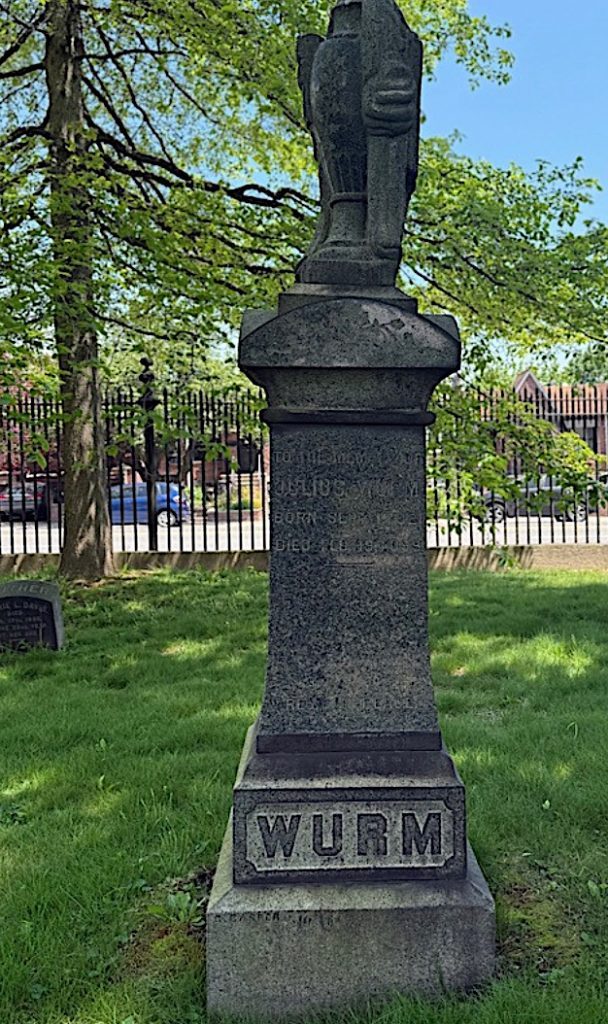
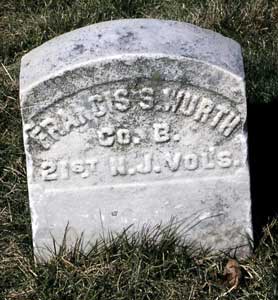
WURTH (or WIRTH, WORTH), FRANCIS S. (1828-1905). Private, 21st New Jersey Infantry, Company B. Originally from Holland, Wurth enlisted as a private on August 26, 1863, mustered into the 21st New Jersey on September 15, and mustered out of service on May 19, 1863, at Trenton, New Jersey. A government-issued gravestone, circa 1900, confirms his service in the 21st. His last residence was 337 Clinton Avenue in West Hoboken. Section 190, lot 22795, grave 2.
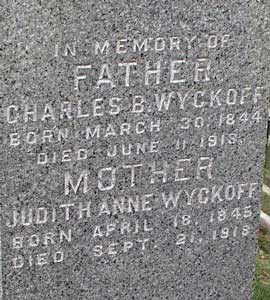
WYCKOFF, CHARLES B. (1844-1918). Second lieutenant, 48th New York Infantry, Companies C, F, A, and H. After enlisting as a private at New York City on August 25, 1861, he mustered into Company C of the 48th New York on September 10. During his military service, he was promoted to sergeant and transferred to Company F, then promoted to sergeant major on February 28, 1863, and transferred to Field and Staff on that date. His promotion to second lieutenant on July 10, 1863, became effective upon his transfer to Company A on September 21, 1863. Wyckoff was discharged on March 7, 1864.
In civilian life, he was a real estate broker and a member of the G.A.R. He applied for and was granted an invalid pension in 1879, certificate 165,689. He died at his summer home at 38 West End Avenue, Somerville, New Jersey. Judith Wyckoff, his widow, applied for and received a pension in 1918, certificate 862,973. Section 71, lot 2400.

WYCOFF, RICHARD MORRIS (1839-1911). Acting assistant surgeon, United States Volunteers. A Brooklynite by birth, Wycoff was a graduate of Amherst College (1859) and Bellevue Medical College, class of 1864. During the Civil War, he was commissioned as an acting assistant surgeon with the rank of captain on August 3, 1864. Wycoff served at Macdougal General Hospital near Fort Schuyler and on the hospital transport S. R. Spalding in New York Harbor. He mustered out on July 20, 1865.
Wycoff was a physician at the Department of Health in Brooklyn and in 1894, became the sanitary superintendent of Brooklyn and the deputy health commissioner until the consolidation of the City in 1898. At one time, he was registrar of vital statistics. As per his obituary in The New York Times, he was secretary of the Kings County Medical Society for many years and one of the founders of the New York State Medical Society and the New York Medico-Historic Society. Wycoff was also the author of many medical articles. He last lived at 532 Clinton Avenue in Brooklyn. Section 71, lot 276.
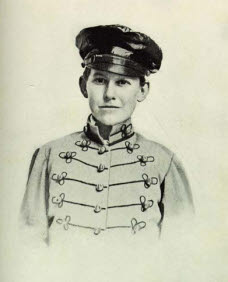
WYETH, JOHN ALLAN (1845-1922) Private, 4th Alabama Cavalry, Company I, Confederate States of America. Born into a distinguished family in Guntersville, Alabama, he enlisted there on December 15, 1862, and immediately mustered into the 4th Alabama Cavalry, known familiarly as John Hunt Morgan’s Confederate Raiders. In 1863, he was taken prisoner of war after the Battle of Chickamauga (Tennessee-Georgia border) and sent to Camp Morton, Indiana, where he was incarcerated for 16 months. In February 1865, he was part of a prisoner exchange and returned to Confederate agents in Virginia. As a result of his extended confinement, Wyeth suffered his whole life from the effects of dysentery, typhoid and malaria.
A graduate of the department of medicine at the University of Louisville in 1869, Wyeth returned to Guntersville but relocated to New York in 1872 and earned a medical degree from Bellevue the next year. A renowned surgeon and teacher, he opened the New York Polyclinic Hospital and Medical School in 1882, a post-graduate facility, wrote four surgical textbooks, was the president of the New York Pathological Society, and first vice-president of the American Medical Association in 1893. His article about conditions and treatment of prisoners during his confinement was published in Century magazine (1890) and numerous medical essays that he authored were awarded prizes. He also wrote a biography of Confederate General Nathan Bedford Forrest and With Sabre and Scalpel: The Autobiography of a Soldier and Surgeon (1914). His son, also a physician who was his namesake, was at the front in World War I and wrote poetry attesting to his horrors of war and other works. His last residence was 242 Lexington Avenue in Manhattan. Section 182, lot 24546.
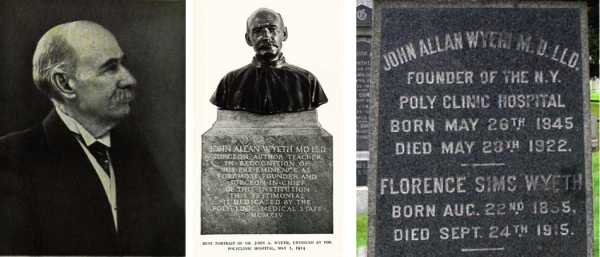

WYMAN (or WYMANN), LUTHER BOYNTON (1805-1879). Patron of the 48th New York Infantry. Born in Woburn, Massachusetts, some official documents list his birth year as 1804, others as 1805. Leaving his family farm, he became a clerk in a shoe factory in Boston, Massachusetts, at age 20. While in Boston, he began a lifelong interest in music, joining the Handel and Haydn Society and becoming one of its principal singers. He was a portly man who stood over six feet tall. After spending three years in Troy, New York, he came to New York City in 1833, joined the New-York Sacred Music Society and was its president for five years. After moving to Brooklyn in 1840, he joined the Brooklyn Sacred Music Society, then was a founder of the Brooklyn Philharmonic Society which in 1857 elected him its president; he occupied this position for the rest of his life. The continued success of the Brooklyn Philharmonic led to the construction of the Brooklyn Academy of Music. While superintending the construction of that facility in 1860, Wyman was buried under debris when a gale of wind blew down heavy beams. Badly injured, he was restored to health three months later.
During the Civil War, Wyman, a lawyer, used his wealth to support the Union cause. An article in The New York Times on May 3, 1861, notes that he was elected president (civilian) of the Relief Guard Association, an organization formed to provide aid for families of soldiers in Brooklyn regiments. He was a patron of the 48th New York Infantry after President Abraham Lincoln issued a call for volunteers in 1861. When recruits were sent to Fort Hamilton on July 24, 1861, their camp was called “Camp Wyman” in his honor. His initial monetary contributions secured blankets and other necessities for the recruits and he continued to support the 48th’s creature comforts. According to his obituary in The New York Times, he sponsored concerts at the Brooklyn Academy of Music to raise money for the soldiers and other patriotic causes. He helped organize the Mercantile Library and was treasurer of the New England Society in New York City from 1854-1875. He last lived at 815 Yates Avenue. Section 71, lot 834.
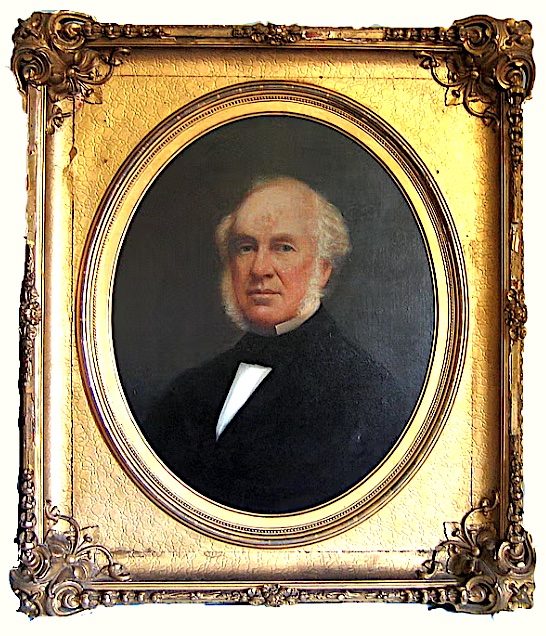
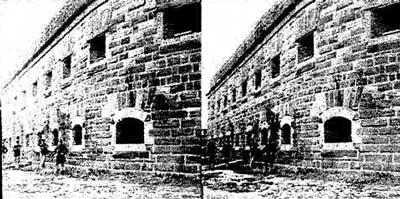
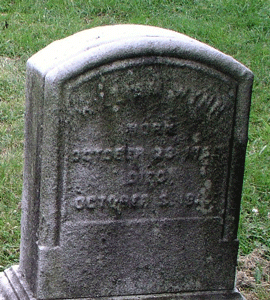
WYNN, WILLIAM (1835-1914). Private, 83rd New York Infantry, Company I; 97th New York Infantry, Company F. Of Canadian birth, he enlisted at Brooklyn as a private on September 2, 1863, mustered that day into the 83rd New York, and transferred into the 97th New York on June 7, 1864. Later that month, on June 24, Wynn was wounded at Petersburg Virginia, and was discharged for disability at Alexandria, Virginia, on an unspecified date. A Freemason, he died at the home of his daughter at 926 St. Marks Avenue in Brooklyn. Section 22, lot 8943.
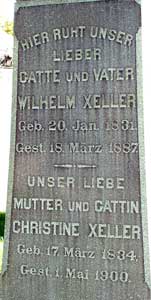
XELLER, WILLIAM (or WILHELM) (1831-1887). Private, 45th New York Infantry, Company H; 58th New York Infantry, Company B. Born in Germany, Xeller enlisted as a private on February 20, 1865, at New York City, and mustered into the 45th New York the same day. On June 30, 1865, he transferred into the 58th New York, and mustered out of service on October 1, 1865, at Nashville, Tennessee. The Brooklyn Directory for 1868 lists him as a dyer. His last residence was 187 Atlantic Avenue in Brooklyn. Section 138, lot 25137.
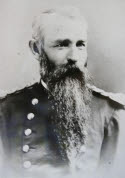
YARD, JOHN EDMOND (1838-1889). First lieutenant, 9th Infantry, United States Army. A career military man, Yard, who was born in Pennsylvania, enlisted as a second lieutenant on November 12, 1861, was commissioned into the 9th Infantry of the United States Army, and assigned to California. He was promoted to first lieutenant on May 30, 1863, and to captain on July 28, 1866. On March 7, 1867, he rose to major in the 10th U.S. Cavalry and was assigned to the 20th Infantry on December 31, 1870. Yard continued to rise through the ranks, becoming lieutenant colonel of the 24th Infantry on March 4, 1879, and was promoted to colonel and assigned to the 18th Infantry, U.S. Army, on April 19, 1886.
Documents pertaining to his military service, pension records, and military court proceedings are among the documents that are held by a descendant. Yard had completed over 27 years of active service on January 24, 1889, when the Army Retiring Board found him incapacitated for duty by reason of anemia, chronic inflammation of the mucous membranes (catarrh), pharyngitis, irritable heart and inability for sustained physical effort…” In a statement in support of his request for retirement, Yard recounts his military service and the illnesses contracted in service as follows:
I first entered the military service November 12, 1861, thus having completed on the 12th instant [of January] 27 years and 2 months of active service. The earlier part of said service was in California, Arizona, and the Indian Territory.
I was transferred to the Department of Dakota in 1871, and during my second winter in that Department (an unusually severe winter, as I remember) I began to experience trouble with my throat and lungs, the result of a severe cold contracted while on duty in the Department just mentioned. The cough has continued ever since and gradually increased in severity occasionally have had pains in left side of my chest. From Dakota I went to Columbus Barracks, Ohio, and thence to Texas. While in Texas coughed very little and enjoyed fairly good health. From Texas I went to Indian Territory. While there chills and fever with muscular rheumatism which I had contracted there as far back as 1869 reappeared and continued during the six years (from 1880 to 1886) of my service in that section of the country. In September 1886 I assumed command of the 18th Infantry at Fort Hays, Kansas, where I have since continued on duty.
The origin of my present physical condition I attribute to a severe cold, contracted while on out in Dakota, and to malarial poisoning in the Indian Territory.
Yard appeared before a general court-martial at Fort Dodge, Kansas, on December 12, 1881, on two charges: drunkenness on duty, in violation of the 38th Article of War (with nine specifications of drunkenness while on duty in command of his regiment); and conduct unbecoming an officer and a gentleman, in violation of the 61st Article of War (with one specification of using inappropriate language in a drunken and maudlin manner, in the hearing of a group of officers). The court found Yard not guilty of the first charge and guilty of the second charge, except for the words “in a drunken and maudlin manner” and deemed that after the expiration of his leave of absence he was to report for duty at the regiment’s headquarters. Colonel Yard died on February 17, 1889, at Fort Hays, Kansas, of pneumonia contracted while on duty. His widow, Josephine B. Yard, applied for and received a pension shortly after his death, certificate WC-260,364. Section 200, lot 27326.
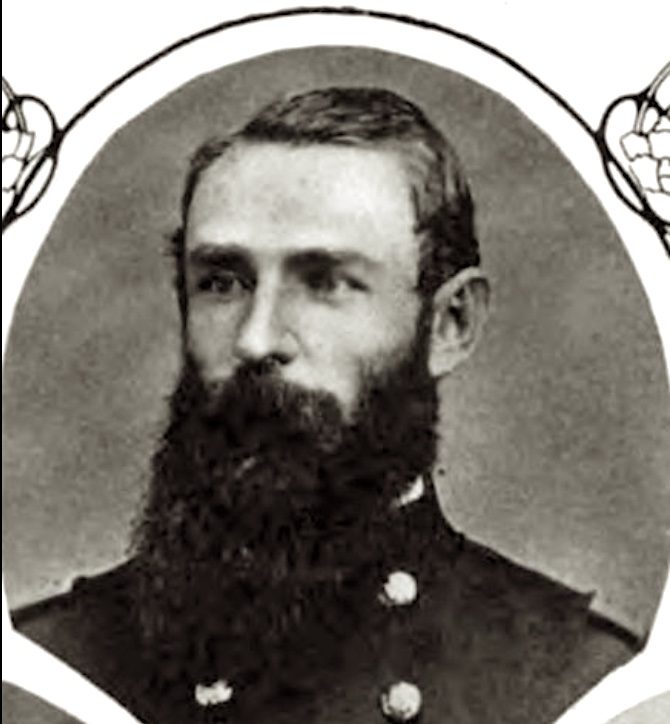

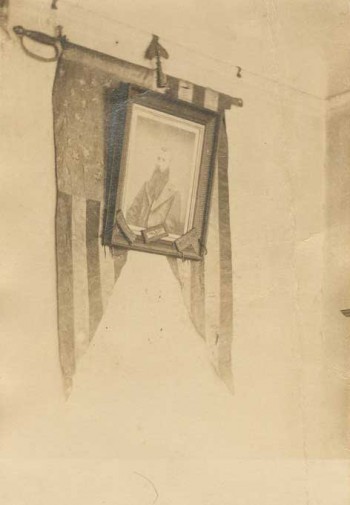
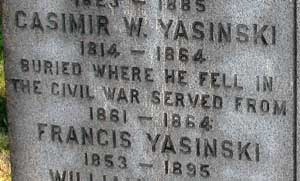
YASINSKI (or JASINSKI, JAESENSKI), CASIMIR (or CASMORE, KASIMIR, KASIMER) W. (1814-1864). Sergeant, 31st New York Infantry, Company C; corporal, 178th New York Infantry, Company K. After enlisting as a private at New York City on May 5, 1861, he mustered into the 31st New York on May 27. He rose to corporal on or about June 15, 1861, to sergeant on March 5, 1862, was reduced to the rank of private on April 1, 1862, and mustered out on June 4, 1863, at New York City. He re-enlisted at New York City as a private the next month on July 10, mustered into the 178th New York on October 17, and was promoted to corporal of his company on October 31. On April 4, 1864, he died of disease at Grand Ecore, Louisiana, on the Emerald on the Red River. Alisha Yasinski applied for and was awarded a widow’s pension in July 1864, certificate 39,120. According to the tombstone, he was “Buried where he fell in the Civil War-served from 1861-1864.” Section 85, lot 5476.
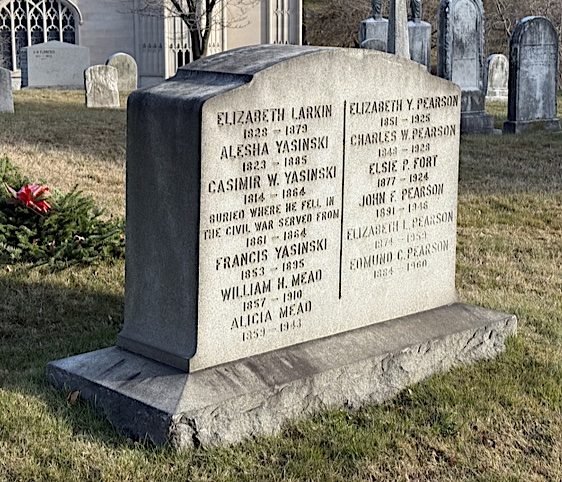
YEAMAN, JR., ROBERT (1843-1890). Private, 84th New York (14th Brooklyn) Infantry, Company H; 5th New York Veteran Infantry, Company I. Yeaman enlisted as a private at Brooklyn on August 20, 1862, and mustered into the 14th Brooklyn the next day. According to a casualty sheet in his military file, he was wounded at the Battle of Antietam, Maryland, on September 17, 1862. On June 2, 1864, he transferred into Company I of the 5th New York Veterans. He was taken prisoner at Weldon Railroad, Virginia, on August 19, 1864, and was held at a prison camp at Salisbury, North Carolina, beginning August 21. He was released from captivity on March 2, 1865, at Northeast Bridge, South Carolina, and mustered out on June 13, 1865, at Annapolis, Maryland. His last residence was 135 Madison Street in Manhattan. According to his obituary in the Brooklyn Daily Eagle, comrades from the 14th were invited to attend his funeral; his death was also announced when the 14th Veterans held their regularly scheduled meeting. Section 126, lot 5047, grave 694.
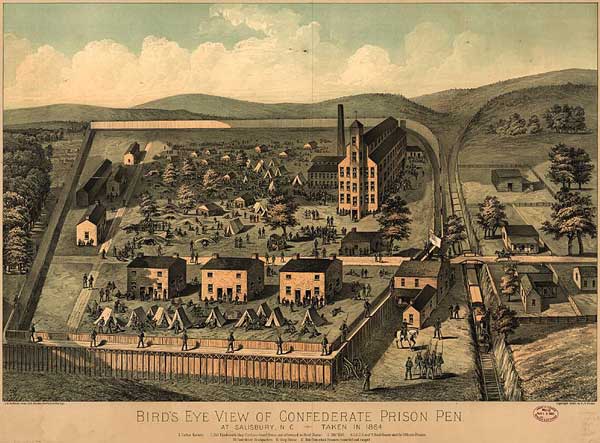
YEATON, JOHN H. (1836-1903). Acting ensign, United States Navy. Born in New Hampshire, he was a seaman as per the 1860 census. During the Civil War, Yeaton served in the United States Navy as of March 14, 1864. He was dismissed on December 29, 1864.
The 1869 Brooklyn Directory notes that Yeaton was a carpenter; the 1870 census indicates that he was a builder living in Brooklyn. At the time of the 1880 census, he was a house carpenter living in Portsmouth, New Hampshire. An article in the Brooklyn Standard Union on April 1, 1895, notes that he was appointed a building inspector from the Civil Service List. The 1890 Brooklyn Directory and the 1900 census indicate that he was a carpenter.
As per his obituary in the Brooklyn Standard Union on March 15, 1903, he died almost a year after he was run down by a Bath Beach train at 39th Street and New Utrecht Avenue on February 28, 1902. On the night of the accident, he reached an intersection where there was no flagman, was hit by a train and suffered a broken leg, dislocated right hip, and torn ligaments. Internal injuries followed and he succumbed to the complications. He had lived in the Borough Park section of Brooklyn for fourteen years at 41st Street and Fort Hamilton Avenue. Section 135, lot 27263, grave 1180.
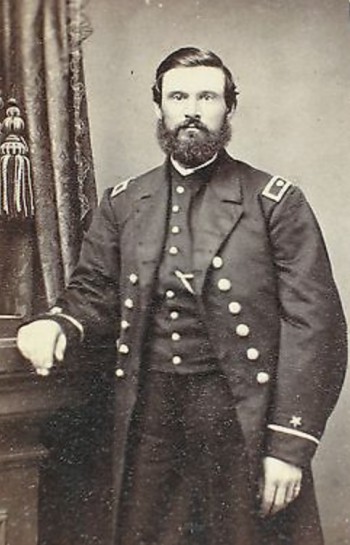
YENNI (or YENNIE), HENRY R. (1822-1874). Private, 26th New Jersey Infantry, Company E. A native of New York, he enlisted as a private on September 1, 1862, mustered into the 26th New Jersey on September 18, and mustered out on June 27, 1863, at Newark, New Jersey. His last address was on West 104th Street in Manhattan. Section 107, lot 10446.
YERKS, ABRAHAM HADLEY (1842-1880). Drum major, 67th New York Infantry; 5th New York Heavy Artillery, Company A. After enlisting as a drum major on August 1, 1861, Yerks mustered immediately into the 67th New York’s Field and Staff at Fort Schuyler, New York, and was discharged on an unknown date. On March 24, 1862, he re-enlisted at Brooklyn as a bugler and mustered into Company A of the 5th New York Heavy Artillery that same day. Within that day, he was promoted to drum major and transferred to the Field and Staff. He deserted at Fort Marshall in Baltimore, Maryland, on October 25, 1863. His last residence was at 51 First Avenue in Manhattan. Section 16, lot 17263, grave 146.
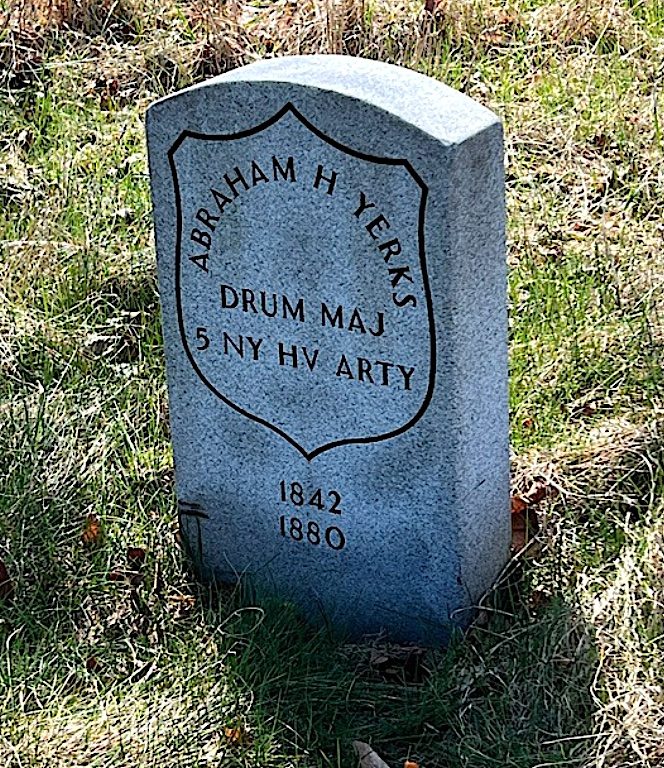
YERKS, JR., JAMES (1824-1897). Private, 56th Regiment, New York State National Guard, Company H. Yerks served with the 56th Regiment when it was activated for 30 days in 1863. His tombstone is inscribed with the details of his military service. His last residence was 169 Reid Avenue in Brooklyn. Section 206, lot 21347, grave 386.
YERKS (or YERKES), JOSEPH W. (1837-1880). Sergeant, 48th New York Infantry, Company H. After Yerks enlisted at Brooklyn as a private on August 7, 1861, he mustered into Company H of the 48th New York nine days later. On December 22, 1863, he re-enlisted as a private, and returned to the 48th where he was promoted to corporal of his company at some point. On April 20, 1865, he was promoted to sergeant of his company serving in that rank until he mustered out on September 1, 1865, at Raleigh, North Carolina. In 1872, he applied for and was granted an invalid pension, certificate 122,782. He last lived in New York City. Section 14, lot 19438, grave 260.

YOST, MICHAEL (1820-1870). First sergeant, 2nd New York Light Artillery; private, 29th New York Infantry, Company H; 5th New York Heavy Artillery, Company A. Of German origin, Yost enlisted at New York City as a private on May 17, 1861, and mustered into the 29th New York on June 4. On July 21, 1861, he transferred into the 2nd New York Light Artillery, as a private, and later received a promotion to corporal in that regiment on December 5. Subsequently, he rose to sergeant on May 1, 1862, became a first sergeant on April 22, 1863, and mustered out on June 13 at New York City. He mustered into the 5th New York Heavy Artillery, Company A, on December 31, 1863, and deserted on January 24, 1864, at Baltimore, Maryland. His last residence was 117 Wooster Place, Manhattan. Section 117, lot 10975, grave 1083.

YOUNG, AARON P. (1838-1867). Corporal, 73rd New York Infantry, Companies B and D. A native of New York State, Young enlisted at New York City as a private on May 4, 1861, and mustered into Company B of the 73rd New York on August 20, 1861. On September 1, 1861, he was promoted to corporal and simultaneously transferred to Company D. He was wounded in action at the Battle of the Wilderness, Virginia, on May 5, 1864, and discharged for disability on July 29, 1864, at Fort Schuyler, New York Harbor. His last residence was 72 Eldridge Street in Manhattan. Section 115, lot 4196, grave 207.
YOUNG, ALEXANDER C. (1836-1899). Corporal, 62nd New York Infantry, Company C. Born in Scotland, Young enlisted as a private on April 29, 1861, at New York City, and mustered into the 62nd on July 3. On about August 15, 1861, he was promoted to corporal but was reduced in rank to private on September 15. On June 1, 1862, he was wounded in action at Fair Oaks, Virginia, and deserted on September 20, 1862, at David’s Island, New York Harbor. His last residence was 199 President Street in Brooklyn. Section 196, lot 28213, grave 2.
YOUNG, CHARLES B. (1837-1909). First lieutenant, 56th New York Infantry, Company F. Young was born in Würtemberg, Germany and immigrated to the United States in 1852. During the Civil War, Young enlisted as a second lieutenant at Liberty, New York, on August 16, 1861, was commissioned into Company F of the 56th New York on August 29, and was promoted to first lieutenant on November 14, 1862. His muster roll indicates that he was absent with leave for 35 days in charge of veterans and also detached as an aide-de-camp to General Hatch in 1864. He mustered out with his company at Charleston, South Carolina, on October 17, 1865.
Although the 1900 census notes that Young married in 1864, marriage records from Texas show that he married Elizabeth Michel in Cornal, Texas, on August 12, 1865. As per the 1870 census, he lived in New York City and worked as a laborer. The 1880 census notes that he lived at 14 Forsyth Street in New York City with his wife and children and worked in the sheriff’s department. His application for an invalid pension was approved in 1882, certificate 295,956; his pension index card notes that he also served with the 80th New York. At the time of the 1900 census, he was a widower who lived on Kensington Walk in Brooklyn and worked as a hotel proprietor; his wife died in 1899. The 1905 New York State census reports that Young was a boarder in Brooklyn; no occupation is listed. Section 136, lot 30010, grave 327.

YOUNG, CHARLES L. (1844-1928). Sergeant, 131st New York Infantry, Company C. Born in Brooklyn, Young enlisted there as a private on August 16, 1862, and on September 6 mustered into the 131st New York. He was promoted to corporal on August 14, 1863, and to sergeant on June 24, 1864. On September 19, 1864, he was wounded at Opequan, Virginia. Young was reduced in rank to private on July 1, 1865, and was absent at his mustering out on July 26, 1865, at Savannah, Georgia.
As per his obituary in the Brooklyn Daily Eagle, he was a member of the Society of Old Brooklynites and the Ulysses S. Grant Post #327 of the G.A.R. in which he held the position of senior vice commander; members of the Grant Post were requested to attend his funeral in full uniform to observe Grand Army rites. He last lived at 311 11th Street in Brooklyn. He died of prostate disease. Section 186, lot 18656.
YOUNG, EDWARD F. (1841-1863). Major, 4th New York Heavy Artillery, Battery G. Originally interred at Green-Wood, his remains were removed on May 29, 1901. A native New Yorker, Young enlisted there as a captain on June 9, 1862, and was commissioned into the 4th New York Heavy Artillery on July 25. He was promoted to major on October 11, 1863, and died of disease on December 22, 1863, at Fort Ethan Allen, Virginia.
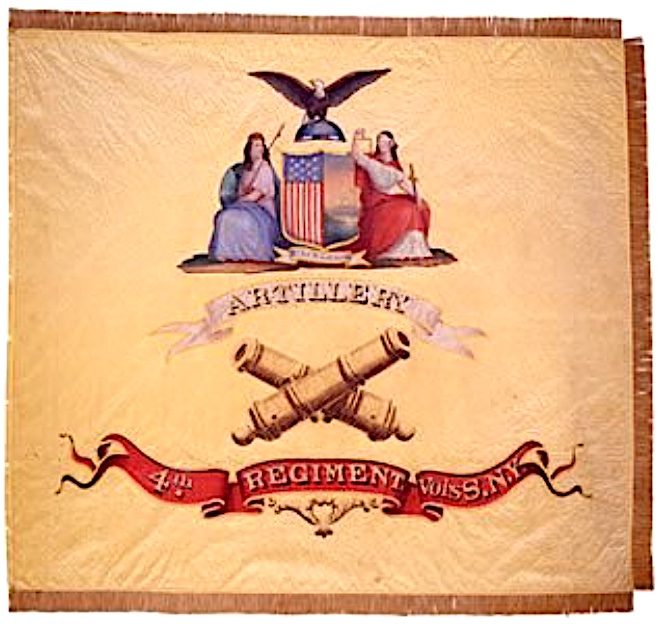
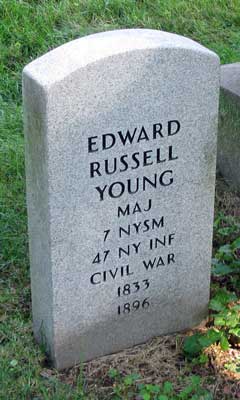
YOUNG, EDWARD RUSSELL (1833-1896). Major, 47th Regiment, New York State National Guard; corporal, 7th Regiment, New York State Militia, Company D. A native New Yorker, Young first served in 1861 for 30 days as a corporal in the 7th Regiment, New York State Militia, Company D. Returning to Brooklyn, he helped form the 47th Regiment with General J. V. Meserole (see). He re-enlisted there on May 27, 1862, was immediately commissioned into the 47th as its major, and mustered out on September 1 of that year.
Retaining his interest in military affairs, Young continued to serve in the 47th as a major after the Civil War. A stockbroker with the firm of Martin & Runyon, located at 100 Broadway, New York City, he lived for many years in Newark, New Jersey. As per his obituary in the New York Herald, members of the Veteran Associations of the 7th and 47th National Guard were invited to attend his funeral. He last lived at 19 Waverly Place in Manhattan but died at the Young family homestead in Smithtown, Long Island. Young’s widow, Mary, received a pension, certificate 597,206. Section 99, lot 5945, grave 11.
YOUNG, HARRISON (1840-1889). Sergeant, 139th New York Infantry, Company I. Young, who was born in New York State, enlisted at Islip, Long Island, as a private, on August 25, 1862. On September 9, 1862, he mustered into Company I of the 139th New York. He was promoted to corporal of his company on July 20, 1864, and became sergeant on February 6, 1865. He was discharged on June 19, 1865, at Richmond, Virginia. In 1887, he applied for an invalid pension, application 633,453, but no certificate number is listed. His last residence was on Orchard Street in Manhattan. Section 85, lot 3330, grave 158.
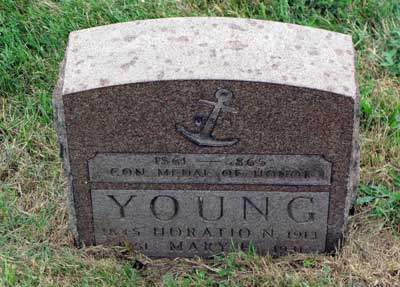
YOUNG, HORATIO NELSON (1845-1913). Medal of Honor recipient; seaman, United States Navy. Young is not buried at Green-Wood; the stone there is a cenotaph in his family’s lot that honors his memory, his Civil War service, and his Medal of Honor. Young was born in Calais, Maine, a small town on the Canadian border across the St. Croix River from St. Stephen, New Brunswick. He served as a seaman in the United States Navy during the Civil War, enlisting at Boston, Massachusetts, as a coxswain in 1862. On November 16, 1863, he was aboard the USS Lehigh when it ran aground in Charleston, South Carolina, in rough seas. The vessel was under heavy fire and he, along with two other seamen, passed a small boat with a line wrapped on a hawser, a cable that would enable the ship to be towed, to the USS Nahant. For this courageous action that freed the Lehigh from her precarious position, Young and his two comrades were awarded the Medal of Honor, the military’s highest honor.
According to Young’s pension record, he served on numerous ships from 1862 through 1867, including the USS Ohio, North Carolina, Marblehead, Guard, Pocahontas, Nahant, Lehigh, Miantonomoh, and Vermont. His application for an invalid pension was granted, certificate 39,541. His obituary in the New York Press reports that he died in Red Beach, Maine, formerly lived on Quincy Street in Brooklyn, and was a member of the Legion of Honor, U.S.A. Young is interred at the St. Stephen Rural Cemetery in New Brunswick, Canada, in a section of other American and Canadian war dead. Maria Young applied for and received a widow’s pension in 1915, certificate 769,623. Section 127, lot 16311.
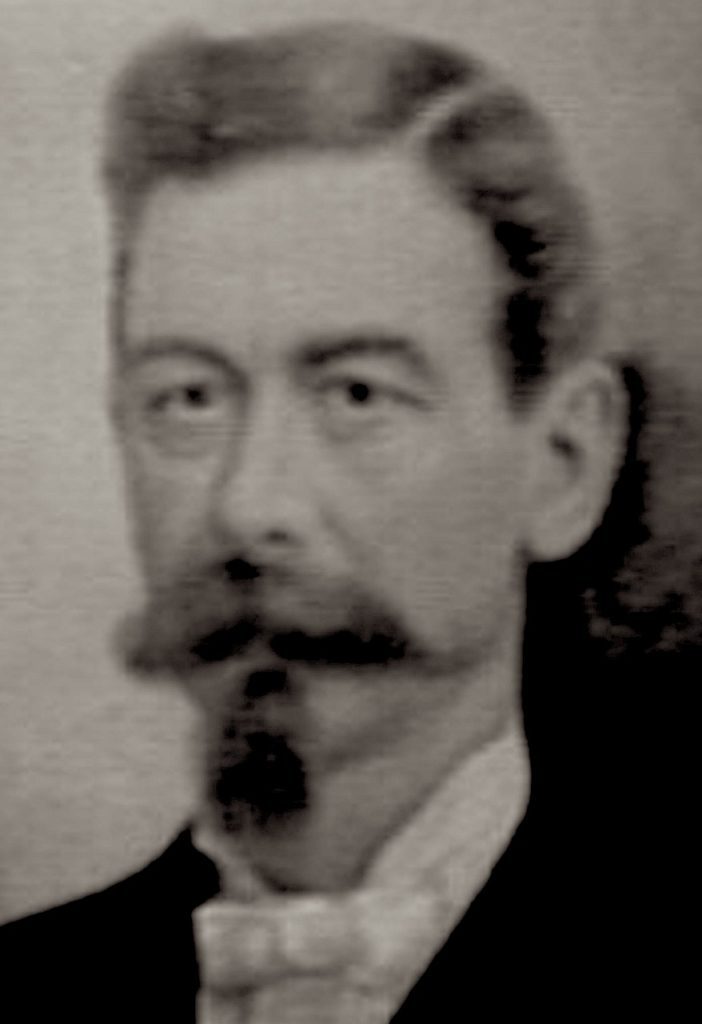
YOUNG, JOHN E. (1845?-1916). Private, 37th Regiment, New York State National Guard, Company D. Young was born in New York. After enlisting as a private at New York City on May 29, 1862, Young mustered into Company D of the 37th Regiment. He mustered out with his company on September 2, 1862, at New York City. The 1870 census reports that he lived in Jersey City, New Jersey, and worked as a machinist. In 1902, he applied for and received an invalid pension, certificate 1,051,533. The 1910 census indicates that he was single, a retired veteran, worked as a merchant, and lived with his sister and brother-in-law in Waldwick, New Jersey. He last lived in Hohokus, New Jersey. He died from catarrhal pneumonia. Section 152, lot 19218, grave 1.
YOUNG, JONATHAN (1826-1885). Lieutenant commander, United States Navy. A native of Ohio, Young was a midshipman in the Navy, beginning with his appointment on October 19, 1841. Attached to the sloop Vincennes, he was in the Home Squadron from 1841-43, then served in the East India Squadron on the frigate Columbus in 1843. On August 10, 1847, he was promoted to passed midshipman and subsequently engaged in pirate expeditions, the Mexican War, and the opening of the Tokyo Harbor. Young was commissioned lieutenant on September 15, 1855. After an assignment at the Naval Observatory in Washington, D.C., in 1854, he was on the steamer Massachusetts in the Pacific Squadron from 1855-57, returned to the Naval Observatory in 1858, and was in the Brazil Squadron and Paraguay Expedition from 1858-59.
When the Civil War began, Young was assigned to the Susquehanna, participating in engagements at Cape Hatteras, North Carolina, and Port Royal, South Carolina. In November 1861, he commanded the Jamestown which blockaded Wilmington, North Carolina. After his appointment to lieutenant commander on July 18, 1862, he took command of the Powhatan in the South Atlantic Blockading Squadron and then in 1863, was at the helm of the Pembina off Mobile, Alabama. In 1864, Young was assigned to ordnance duty at the New York Navy Yard and then commanded the Cimarron off Charleston, South Carolina, being present at all the engagements related to securing that harbor as part of his duties in the South Atlantic Blockading Squadron from 1864-65. After his promotion to commander on November 21, 1866, he was assigned to the steamer Mahaska in the North Atlantic and returned to the Naval Observatory in 1869. Young became a captain in 1873 and rose to commodore on June 19, 1882. He served in New London, Connecticut, where he lived until his death. Section 171, lot 9218.
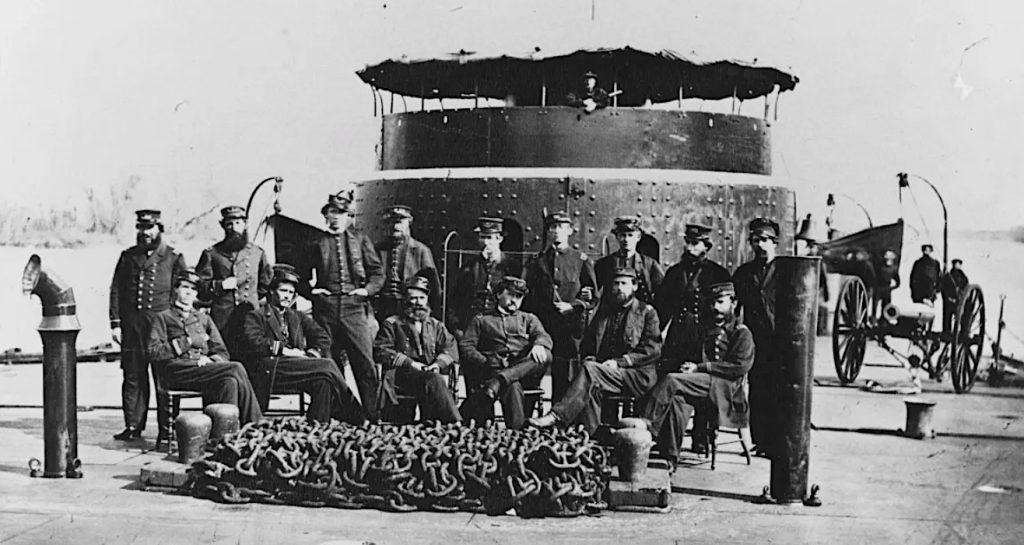
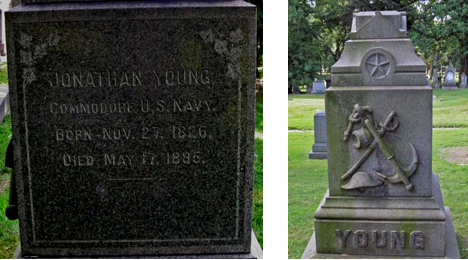
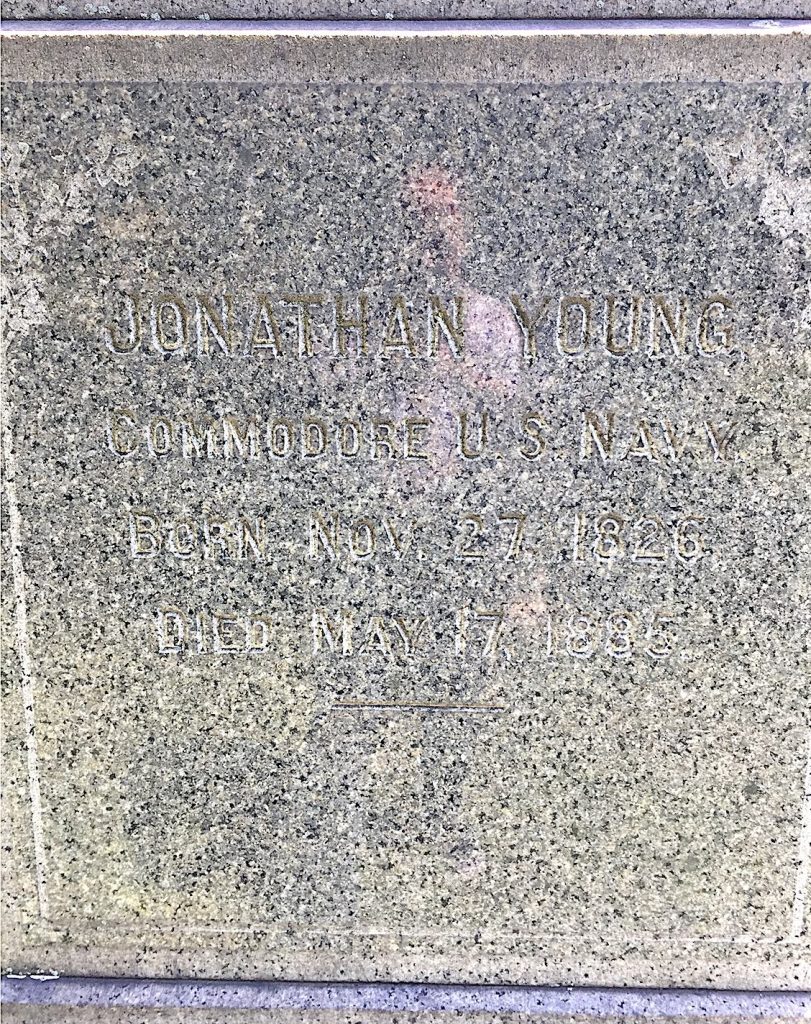
YOUNG, RICHARD V. (1846-1879). Private, 158th New York Infantry, Company G; 100th New York Infantry, Company F. Born in New York City, Young enlisted as a private at Brooklyn on November 17, 1864, and mustered into the 158th New York Infantry that same day. He served under General Sherman in Dalton, Georgia, and entered Richmond, Virginia, at the close of the Civil War. On June 30, 1865, he transferred into the 100th New York Infantry. He mustered out on August 8, 1865, at Richmond, Virginia.
After the War, Young joined the 9th Regiment, New York State National Guard, and served for eight years. In 1873, he was elected first lieutenant of the 8th Regiment, became a captain on March 9, 1874, and was chosen major on October 8, 1877. In addition, he was a delegate to the State Military Association in Albany, New York, and became recording secretary of that group. He joined the Grand Army of the Republic Barbara Frietchie Post #11 and held the position of commander. In addition, he belonged to the Freemasons. According to his obituary in The New York Times, he suffered from malaria after participating in regimental duties during a storm in 1879. An escort from the 9th Regiment accompanied his funeral procession. An article in the Brooklyn Daily Eagle in 1880 noted that his grave was decorated on Decoration Day of that year. His last residence was 559 Lorimer Street in Greenpoint, Brooklyn. Section 115, lot 21016.

YOUNG, ROBERT ALEXANDER (1835-1893). Officer, Confederate States of America. Born in Camden, South Carolina, he graduated from the South Carolina Military Academy. The only matching Confederate officer was a Captain Robert A. Young in the Choctaw and Chickasaw Mounted Rifles, Company K. After the War, he moved to Brooklyn and worked as a civil engineer. He laid out Jerome Park Racetrack. His obituary lists him as “Colonel Young.” He last lived at 194 Clinton Street in Brooklyn. Section 2, lot 6671.
YOUNG, ROBERT B. (1836-1898). Second lieutenant, 8th Regiment, New York State Militia, Company A. Young enlisted as a private on April 23, 1861, at New York City, mustered into the 8th Regiment’s State Militia two days later, and mustered out on August 2 at New York City. He rejoined his regiment and company, then part of the National Guard, on May 29, 1862, was commissioned in that day as a second lieutenant, and mustered out after three months on September 10 at New York City. He served again for 30 days a year later from June 17 through July 23, 1863, mustering out at New York City. He last resided in Asbury Park, New Jersey. Section 97, lot 2795.
YOUNG, THOMAS W. (1843-1922). Unknown soldier history. A Brooklynite by birth, he fought under Generals Grant and McClellan and was part of General Sherman’s March to the Sea. These details were noted in his obituary in The New York Times. There is no further information about his service. A fish merchant in Brooklyn, he was a member of the George C. Strong Post #534 of the Grand Army of the Republic. His last residence was 704 Union Street in Brooklyn. Section 78, lot 5523.
YOUNG, WILLIAM A. (1830-1878). Private, 162nd New York Infantry, Company H. Young enlisted as a private on August 11, 1863, at Schenectady, New York, mustered into the 162nd New York that day, and mustered out on October 12, 1865, at Savannah, Georgia. The father of eight children, his last known address was 125 Oxford Street, Brooklyn. Section 15, lot 17263, grave 2364.
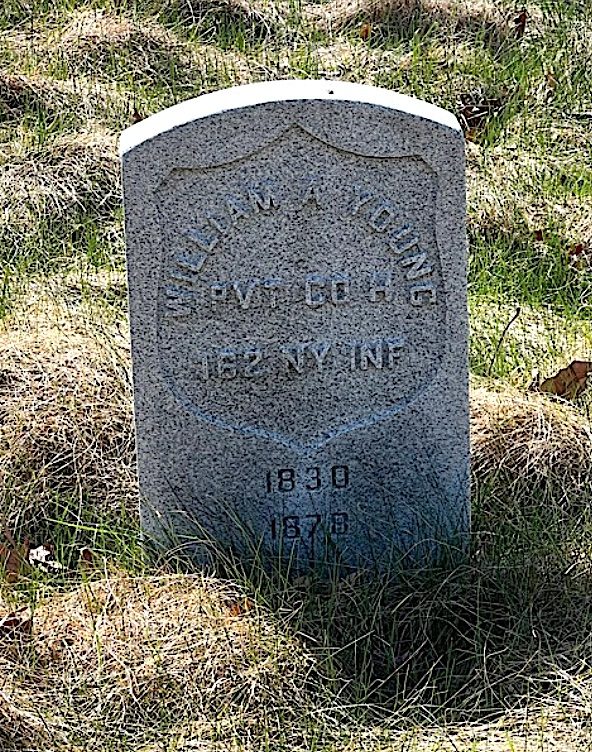

YOUNG, WILLIAM T. (1847-1912). Private, 28th Regiment, New York State National Guard, Company F. Young, a native of New York City, enlisted in 1864 and mustered into Company F of the 28th New York National Guard when it was activated for 100 days. He mustered out at New York City with his company.
In 1909, Young applied for and received an invalid pension, certificate 1,157,974. As per his obituary in the Brooklyn Daily Eagle, he was superintendent, post office Station T, and a member of the Royal Arcanum; members of his R.A. Council were invited to attend his funeral. He last lived at 315 Greene Avenue in Brooklyn. Anna Young, who is interred with him, applied for and received a widow’s pension after his death in 1912, certificate 753,432. Section 193, lot 33721, grave 2.
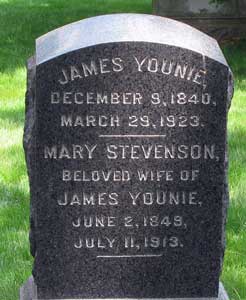
YOUNIE, JAMES (1840-1923). Sergeant, 13th Regiment, New York State National Guard, Company G. A Brooklynite by birth, Younie served for 30 days in 1863 (from June 20 to July 21) when the 13th Regiment was activated. His pension record indicates that he also served in Company H of the 13th Regiment’s Heavy Artillery but no dates are available. In 1906, he applied for and received an invalid pension, certificate 1,124,819. As per his obituary in the Brooklyn Daily Eagle, which confirms his Civil War service, he was a member of the 13th Regiment Veteran Association; members were invited to attend his funeral at his daughter’s home at 1650 East 8th Street in Brooklyn. He died at Middletown, New York. Section 151, lot 17503, grave 5.
ZABRISKIE, ABRAHAM (or ABRAM) (1841-1864). Colonel, 9th New Jersey Infantry. Born in Hackensack, New Jersey, and a graduate of Princeton University (class of 1859), he enlisted on October 18, 1861, as an adjutant, and was immediately commissioned into the Field and Staff of the 9th New Jersey. He rose to major on February 10, 1862, to lieutenant colonel on December 22, 1862, and to colonel on January 8, 1863. During May 1863, he commanded the District of Beaufort, 18th Army Corps, Department of North Carolina. Wounded on or about May 12, 1864, at Drury’s Bluff, Virginia, he died on May 24 at Chesapeake Hospital at Fort Monroe in Hampton, Virginia. Section 32, lot 14954.

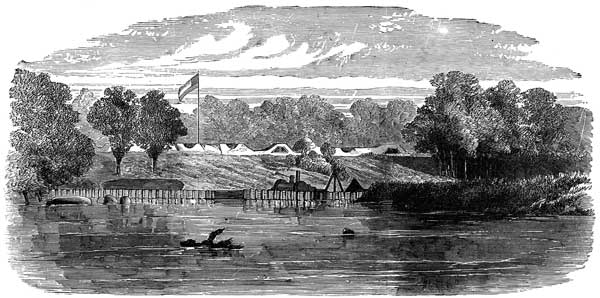
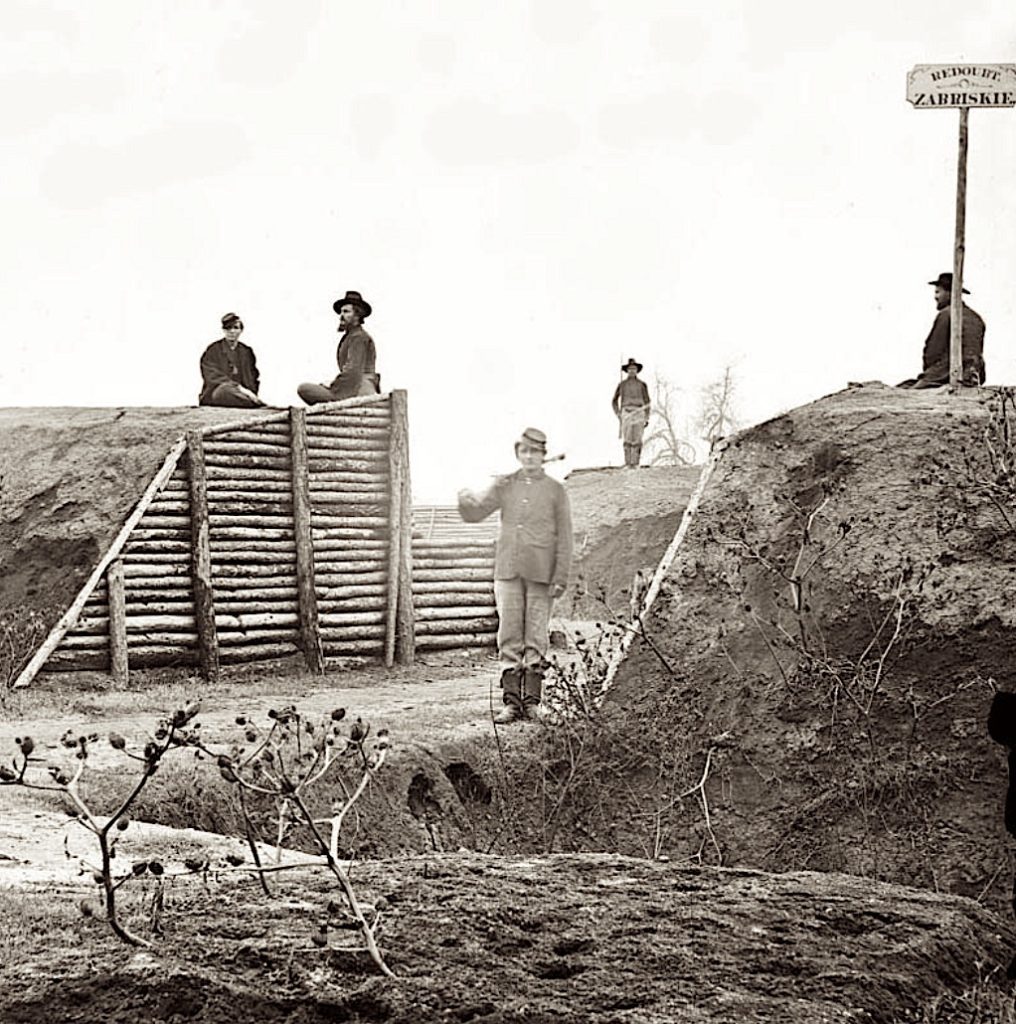
ZAUNFLETH (or ZUNFLATH), JOHN HENRY (1841-1890). Private, 5th Light Artillery, Battery D, United States Army. Zaunfleth was born in Hanover, Germany. According to the 1860 census, he was single, lived in Manhattan and was in the buttermilk industry. During the Civil War, he enlisted as a private for five years on May 10, 1861. He served in Company D of the 5th Light Artillery, United States Army. He was a bartender who was 5′ 9″ tall with gray eyes, dark hair and a florid complexion.
The 1865 New York State census reports that he was a boarder living in Brooklyn who was employed as a milkman. Zaunfleth became a naturalized citizen on January 3, 1871. He last lived in Brooklyn. His death was attributed to a brain concussion. Shortly after his death, his wife applied for and received a widow’s pension, certificate 369,214. Section 17, lot 17245, grave 257.
ZEILER (or ZEITER), JOHN (1836-1886). Private, 4th New York Infantry, Company D. Zeiler, a German native, enlisted as a private at New York City on May 7, 1861, and mustered into the 4th New York that day. He was borne on the rolls as John Zeiter. On September 17, 1862, he was wounded in action at Antietam, Maryland, and was discharged for disability at Mt. Pleasant Hospital in Washington, D.C., on April 2, 1863. He last lived at 137 First Avenue in Manhattan. Section 3, lot 21025, grave 489.
ZELLER (OR ZELLA, SOLLER. ZUCK, ZOELLER, SELLER), LOUIS (or LEWIS) (1825-1893). Private, 173rd New York Infantry, Company C. Zeller was born in Baden, Germany. Documents related to him bear many alternate spellings of his name, most notably as Soller in his pension file, but he is listed on the Ancestry website as Zoeller and on the record of the adjutant general for the 173rd as August Zuck.
As per the Ancestry website, he already was married to Ellen Magdalene Speck when they immigrated to the United States in 1848, at which time they had a one-year-old son named Francis. They arrived in New York City on April 3, 1848, after departing from Le Havre, France. The couple soon had other children: Mary, born in 1852; Henry, born in 1854, Louisa, born in 1856, and Barbara, born in 1859. At the time of the 1855 New York State census, Louis was living in Brooklyn with his wife, who is listed as Catherine Seller, and their three young children.
During the Civil War, Zeller enlisted on September 4, 1862, and mustered into Company C of the 173rd Infantry, also known as the Metropolitan Guard. His soldier records carry multiple alternate spellings including Louis (or Lewis) Seller/Soller. As per the adjutant general’s report, his name appeared on the roster of the 173rd as August Zuck with the notation that he was also borne on the regimental rolls as Louis Soller. As per “A Brief Sketch of the 173rd Regiment, New York Volunteers,” the regiment was organized at Brooklyn on November 10, 1862, and served in the Department of the Gulf. The men were engaged at Port Hudson, Louisiana, in July 1863, a bloody but successful engagement in the Union campaign to secure the Mississippi River. After Port Hudson surrendered on July 8, 1863, the regiment took part in the second Teche campaign in Louisiana. Two extremely bloody battles occurred in April 1864, the Battle of Sabine Roads on April 8, and the Battle of Pleasant Hill on April 9; in the latter, the 173rd was the “advance-guard of the army.” The sketch notes that the regiment was completely surrounded but managed to cut its way through and escape, losing two hundred out of four hundred men, including its lieutenant colonel. Though the enemy was repulsed, it was at this battle that Louis Zeller was captured and taken as a prisoner of war.
In Louis’s pension files for his original claim in 1887, it was handwritten that his debilities were contracted while he was a prisoner of war in 1864 near Tyler, Texas. Zeller’s deposition, submitted on October 13, 1887, states that he was taken prisoner on April 9, 1864, and that he was confined there in the stockades suffering from chills, fever, malaria, chronic diarrhea, and rheumatism that troubled him throughout his incarceration which lasted over 13 months; during that time, he received no medical treatment. He further noted that he was paroled about May 17, 1865, sent North, and was never in any hospital prior to his discharge at New York City.
A document from the Pension Bureau, submitted by the Adjutant General’s Office and dated November 19, 1887, reports that he was listed absent “missed in action” at Pleasant Hill, Louisiana, from April 9, 1864 through April 30, 1865, was at Camp Parole in Annapolis, Maryland, exchanged on May 27, 1865, and was honorably discharged at New York City on July 10, 1865. Additional notes indicate that he was initially paroled at Red River Landing, Louisiana, on May 27, 1865, sent to Benton Barracks, Missouri to a Union encampment, and not sent to Annapolis until June 18; these notes indicate that there is no mention of debility related to his capture or imprisonment.
As per the 1865 New York State census, which also lists his surname as Seller, he and his wife Ellen were living in Brooklyn; only two children, Mary and Louisa, are listed on that census. Louis returned home disabled, affecting his ability to support his family. As per a letter in his pension file written in 1887, Zeller did light work at Green-Wood Cemetery beginning in 1867, such as raking leaves and other chores; he was unable to work before then. That hand-written note reporting of his work at Green-Wood reports that he was first under the care of a physician, Dr. Bullshiser, who died in 1872, and is later under another’s physician’s care. The 1875 New York State census lists the Sellers and their youngest daughter Barbara living in Brooklyn.
Ellen Zeller died from tuberculosis in Brooklyn on November 12, 1882. Five months later, on March 17, 1883, Zeller (or Zoeller as it appears on the marriage records) wed Minna (née Wilhemine or Whilhemina Schwab Heene) in Brooklyn. It was a second marriage for both. The 1888-1889 Brooklyn Directory lists him as a laborer living at 709 Third Avenue in Brooklyn.
Zeller applied for and was granted an invalid pension in 1887, certificate 396,408; his pension bore the name Soller and the alias of Zeller. His pension file shows that he received $6 per month as of June 30, 1887; chronic diarrhea and resulting piles were noted. In his pension files for the original claim, it was handwritten that his debilities were contracted while he was a prisoner of war in 1864 near Tyler, Texas. Because he was never treated in prison or by any regiment doctor and the two physicians who treated him after his release had died, only his current physician could provide any information about his medical condition. That affidavit, signed on October 19, 1887, reports that this doctor had treated Louis Seller for the past four years and that Louis suffered from malarial fever, rheumatism and pneumonia. Zeller attested that he had no treatment in service because he never rejoined his regiment. In 1887, Zeller was 62 years old, 5′ 4″ tall with a ruddy complexion, sandy hair and brown eyes. Medical examination detailed sallow skin, rectal ulcers, tapeworm and other maladies.
Additional documentation of Zeller’s debility and imprisonment were submitted by fellow soldiers and prisoners of war Balsam Miller and Frederick Schick who were confined with him in Tyler, Texas. They attested in an affidavit dated October 13, 1887, to his disabilities and Louis’s being able to do chores at Green-Wood only a quarter of the time. The information submitted by Zeller’s comrades about the three men being incarcerated together was confirmed by the Pension Bureau. In 1888, friends and neighbors of Louis, one of whom was a comrade during the war, declared that Zeller came home sick and continued to be afflicted with rheumatism and diarrhea. The neighbors wrote in response to a letter from the commissioner of pensions and were asked to specify the diseases suffered by Louis and the impact on his ability to work.
As of August 5, 1890, Zeller was receiving a pension of $12 per month; it was reported that he suffered from nearly total deafness in his left ear, rheumatism and general debility. A medical exam on January 13, 1892, reported that Zeller was 5′ 3½” tall, 114 pounds with total deafness in his left ear, stiffness, pain, swelling and other maladies including senility. Additional documents in his pension file note that he was paid $12 a month as of November 4, 1893. He last lived at 709 Third Avenue in Brooklyn. His death certificate lists pneumonia and asthenia (weakness) as the cause of his death and notes his occupation as a laborer; the certificate also states that he was married and was a resident of Brooklyn for 25 years.
Minna Zeller applied for a widow’s pension on December 14, 1893, nine days after her husband’s death; that document was signed “Minna Soller,” On December 15, 1893, Howard Courady, the captain of Zeller’s company in the 173rd, attested in an affidavit in support of Minna’s application, that he knew Louis well and that the name Soller(s) was used because the orderly sergeant did not know German names and entered the name “Soller” which was then used to “avoid mistakes in pay and muster roll.” A friend attested that Minna owned no property or income, had furniture worth about $50 and did washing for some support. In 1894, Minna was awarded a widow’s pension, back-dated to December 19, 1893, certificate 390,898.
On October 1, 1913, a letter was sent to Minna’s daughter, Anna Ruppel (Kuppel)) that pension payment to Minna Zeller could only continue if she had a court-appointed guardian because she was insane; Mrs. Kuppel had written that her mother was in an asylum and that she needed the pension money to attend to her mother’s needs because she herself had a family and husband who didn’t earn much. Mrs. Ruppel was appointed guardian on March 25, 1914. Minna Zeller died at Long Island State Hospital on March 28, 1916. On April 26, Annie Ruppel’s attorney wrote to the Pension Bureau asking for accrued payments to cover the funeral costs of Minna; Mrs. Ruppel was issued a check in the amount of $36.
A descendant, Kathleen Petersen, notes that Louis and Ellen Magdalene Zeller, were her great-great grandparents. Ms. Petersen has many of the handwritten affidavits and pension papers in her possession; they form the basis and/or validate of much of the information in this biography. Both wives are interred with him; Ellen is listed as Zellers in the Green-Wood database. Section 59, lot 1669, grave 54.
ZELLER, THEODORE (1824-1901). Chief engineer, United States Navy. A New Yorker by birth, he joined the Navy as a third assistant engineer on June 15, 1843, and was assigned to the steamer Colonel Harney in the Home Squadron from 1843-47. He rose to second assistant engineer on July 10, 1847, and continued in the Home Squadron through 1848 aboard the Iris. He then joined the Massachusetts in the Pacific Squadron until 1853 during which time he became a first assistant engineer on February 26, 1851. Assigned to the Saranac in the Mediterranean Squadron, Zeller served there from 1853-56. He was promoted to chief engineer on June 27, 1857, was with the Saranac in the Pacific Squadron from 1858-59, and was on the Michigan, a steamer, in the lakes in 1860-61.
During the Civil War, Zeller was on special duty from 1861-63, spending two years in New York. He was fleet engineer of the North Atlantic Blockading Squadron from 1864-65, then was assigned to the Philadelphia Navy Yard from 1866-69. He retired from service on December 1, 1885. He last lived at 15 West 12th Street in Manhattan. Section 51, lot 13433, grave 4.
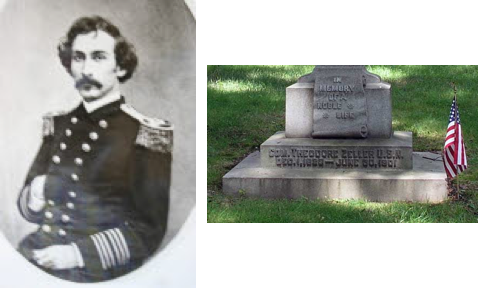
ZELLINSKY, CHARLES L.H. (1842-1905). Private, 20th New York Infantry, Company A; Artillery, 2nd Division, 6th Corps (Veterans Reserve Corps, 2nd Battalion, 4th Company). Born in Prussia, Germany, to Johann Ludewig Heinrich Zellinsky and his wife Henrietta, Charles came to the United States at the age of 10 with his family; they settled in Flatbush, Brooklyn. As per the 1855 New York State census, he was 13 years old and living in Brooklyn with his parents and two siblings, Ferdinand (see) and Sophia.
At the age of 20, Charles enlisted at New York City in the 20th New York Infantry and mustered in as a private in Company A three days later. As per his muster roll, he was a painter with gray eyes, brown hair, a fair complexion, and was 5′ 4″ tall. On May 3, 1863, he was wounded in Battle of Salem Heights (also referred to as the Battle of Salem Church) in Spotsylvania County, Virginia, as a part of the Chancellorsville Campaign. He transferred out of the 20th Regiment four days later, and a month after that, apparently debilitated but still able to serve in a reduced capacity, he transferred into the Veterans Reserve Corps, 2nd Battalion, 4th Company. The Veterans Reserve Corps, known early in the Civil War at the Invalid Corps, was composed of soldiers who were no longer fit for field service because of wounds or disease, but were able to perform garrison or light duty to free up able-bodied soldiers for the battlefield.
According to his obituary in the January 7, 1905 edition of the Flatbush Weekly News and Kings County Record,
. . . he had quite a record as a soldier and went to the Civil War with a German regiment. He was noted for his bravery and was shot in the left arm as a result of his daring. His arm was badly shattered. After he returned from the front he joined the 14th Regiment and for several years he was captain of Company F.
Charles married Hellen Virginia Wagler in 1866 in Washington, D.C., at Concordia Lutheran Evangelical Church. The 1866 Washington, D.C. Directory finds him working as a clerk to the provost marshal general of the United States Army. Charles became a United States citizen in 1868. In 1873, he applied for an invalid pension, based on his service. That application was approved, certificate 135,463. By the 1875 census, he was living in Brooklyn with his wife, Hellen. In 1889, he was appointed postmaster of Flatbush. As per the above obituary, he was active in Republican politics and was the last postmaster of the Town of Flatbush. A member of William Rankin Post #10 of the Grand Army of the Republic, he was also well known as an artist who specialized in painting racehorses. According to the 1890 Veterans Schedule, he rose to the rank of sergeant in the 20th Infantry. However, no other records confirm this. At the time of his death, he was working as a sewer inspector.
Charles died on the stoop of his home, 128 Fenimore Street, of heart disease. His funeral was held at the Masonic Hall at 824 Flatbush Avenue. Though his wife Hellen applied for a widow’s pension, based on his military service, it was not certified. Section 187, lot 20022.

ZELLINSKY, FERDINAND (1837-1922). Corporal, 84th New York (14th Brooklyn) Infantry, Company A. Born in Germany, he enlisted at Brooklyn as a private on April 18, 1861, and mustered into the 14th the next month on May 23. He was discharged for disability on February 13, 1863, at Harewood Hospital, Washington, D.C.
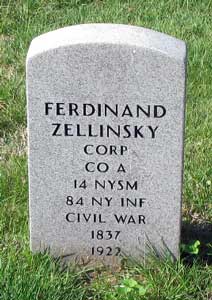
In 1904, Zellinsky applied for an invalid pension, certificate 1,085,594. According to his obituary in the Brooklyn Standard Union, which confirms his Civil War service, he lived in Brooklyn for 70 years, and was in the banking business. A past master of his Masonic lodge, he was also a member of the Knickerbocker Mutual Association. His funeral was at his stepdaughter’s home on Cary Street in Queens, New York. Section 187, lot 20022, grave 1.
ZIEGLER, LOUIS (1831-1896). Private, United States Rifles, Company C; 58th New York Infantry, Company I. A native of Germany, Ziegler enlisted as a private on September 30, 1861, at New York City, mustered into the United States Rifles, United States Army, and transferred into the 58th New York two months later on November 23. He re-enlisted on January 1, 1864, and mustered out of service on October 1, 1865, at Nashville, Tennessee. His last residence was on 1st Place in Brooklyn. Section 147, lot 25223, grave 78
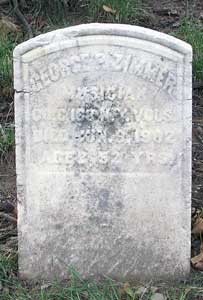
ZIMMER, GEORGE PHILIP (1849-1902). Drummer, 163rd New York, Company C. According to a descendant, Zimmer apparently lied about his age and at 13, enlisted on August 7, 1862, and mustered into the 163rd at Washington, D.C., on October 10. He was paid a bounty of $25 and a $2 premium. He was discharged on March 6, 1863, when his unit was consolidated with the 73rd New York. The descendant, who has researched the pension records, notes that he was discharged because he was underage and that the government confused him with his father. His father, John George Zimmer, was a musician with the 163rd.
In civilian life, Zimmer was a butcher by trade. He mustered into Abel Smith-First Long Island Post #435 of the G.A.R. on July 26, 1886. Its records confirm his service, profession, date of death, and his interment at Green-Wood. At the time of his death, he lived at 139 Glen Street in Brooklyn. Section 14, lot 4969, grave 25.
ZIMMERMANN, JACOB (1840-1900). Private 32nd New York Infantry, Company B; 178th New York Infantry, Company H. Born in Germany, Zimmermann enlisted on September 1, 1861, at Amsterdam, New York, mustered into the 32nd New York that day, and mustered out on June 9, 1863, at New York City. He re-enlisted at New York City on August 8, 1863, and mustered into the 178th New York Infantry on August 29. After being listed on the rolls as of October 31, 1863, no further record of his service is known. His last residence was 681 Willoughby Avenue in Brooklyn. Section 194, lot 30721, graves 7 and 8.
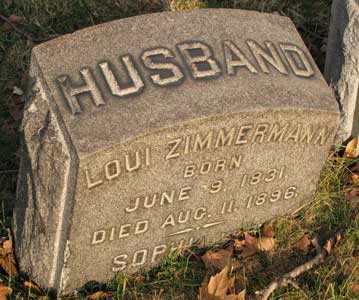
ZIMMERMANN (or ZIMMERMAN), LOUIS (or LOUI) (1831-1896). Private, 54th New York Infantry, Company G. Of German origin, Zimmermann enlisted on September 17, 1861, at Hudson City, New Jersey, as a private. He mustered into the 54th New York the same day and was discharged for disability on September 10, 1862, at Washington, D.C. His last residence was at 216 Spring Street in Manhattan. Section 135, lot 14964, grave 389.
ZINDLE, GEORGE (1841-1896). Corporal, 11th New Jersey Infantry, Company E. Zindle, who was born in New York, enlisted as a private on August 18, 1862, and mustered into the 11th New Jersey the same day. On July 1, 1864, he was promoted to corporal and was discharged at Emory Hospital in Washington, D.C., on June 10, 1865. He applied for and was granted an invalid pension in 1879, certificate 376,382. He last lived at 167 15th Street in Brooklyn. His wife, Mimi Zindle, applied for and received a widow’s pension in 1896, certificate 445,456. Section 135, lot 14964, grave 607.
ZIPFEL (or ZIPFELL, SIPFELL, ZIPPEL), JACOB WILLIAM (or H.) (1836-1887). First sergeant, 20th New York Infantry, Company H. Of German birth, Zipfel enlisted at New York City on May 3, 1861, and mustered into Company H of the 20th New York, also known as Turner’s Rifles, three days later. His muster roll notes that he was also borne on the rolls as Jacob Zipfell or Jacob Sipfell. He was promoted to first sergeant on October 4, 1862, was wounded at Salem Heights, Virginia, on May 4, 1863, and mustered out with his company on June 1, 1863, at New York City.
As per Trow’s New York City Directory for 1867, Zipfel lived in New York City and was employed as a tailor. The 1870 census notes that he was living in New York City with his wife Sophia and their two children. In 1876, his application for an invalid pension was approved, certificate 167,027. The 1879 Brooklyn Directory reports that he lived at 25 Seigel Street in Brooklyn and worked as a basketmaker; the 1890 Brooklyn Directory indicates that he was a driver and lived at 562 Baltic Street in Brooklyn. Sophia Zipfel applied for and received a widow’s pension, certificate 242,315. His remains were moved to the present location in 1932. Section 69, lot 1590.
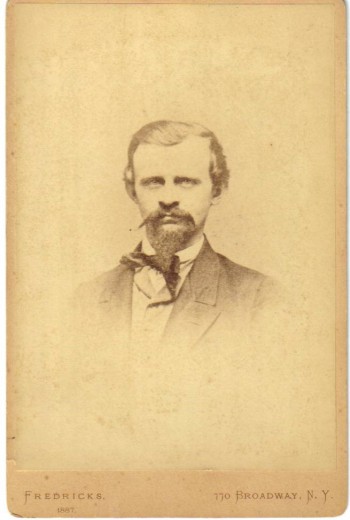
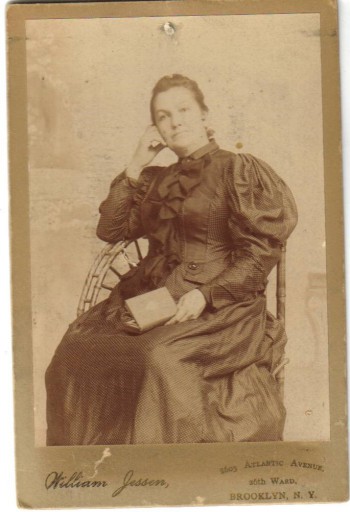
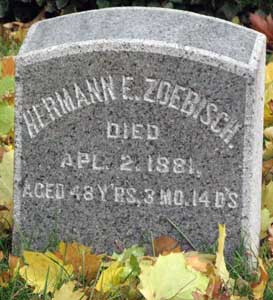
ZOEBISCH, HERMANN (or HERMAN) E. (1833-1881). Quartermaster sergeant, 5th Regiment, New York State Militia. A native of Germany, he enlisted on May 16, 1861, as a quartermaster sergeant and mustered into the Field and Staff of the 5th Regiment the same day. He mustered out on August 7, 1861, at New York City. His last residence was 65 East 4th Street, Manhattan. Section 115, lot 19622.
ZOLLINGER, HENRY J. (1839-1886). Private, 11th New York Cavalry, Company U. Originally from France, he enlisted at New York City as a private on July 30, 1862, the same date that he mustered into the 11th New York Cavalry. According to his muster roll, he was a baker by trade who was 5′ 9″ tall with grey eyes, light hair and a fair complexion. Further details are unknown. He last lived at 533 8th Street in Brooklyn. Section 3, lot 18372, grave 187.
ZOOK, SAMUEL KOSCUIZKO (1823-1863). Major general by brevet; brigadier general, United States Volunteers General Staff; 57th New York Infantry; lieutenant colonel, 6th Regiment, New York State Militia. Originally interred at Green-Wood, his remains were removed to Montgomery Cemetery in Norristown, Pennsylvania, in 1864. A native of Chester County, Pennsylvania, he worked in the telegraph business where his discoveries in electrical science earned him a renowned reputation, then settled in New York in 1848. By 1857 he was lieutenant colonel of the 6th New York Militia.
After enlisting on April 19, 1861, at New York City, Zook was commissioned into the Field and Staff of the 6th Militia as its lieutenant colonel on May 14, was appointed military governor of Annapolis, Maryland, and mustered out at New York City on July 31. He later recruited the 57th New York, and as its colonel as of October 19, 1861, led it to the Virginia peninsula. On June 2, 1862, Brigadier General William French, United States Army, in his field report from Fair Oaks, Virginia, praised Zook for his leadership of the 57th Regiment whose men fought through swamps and thicket under heavy fire. French wrote, “The conduct of the officers and men must be judged by the results of a hard-fought field.” He was appointed brigadier general of volunteers on November 29, 1862, the appointment being confirmed on April 23, 1863. Zook led the 57th at Fredericksburg and Chancellorsville, Virginia, and commanded the II Corps, 3rd Brigade at Gettysburg, Pennsylvania. He died on July 3, 1863, after being mortally wounded in the abdomen the previous day, the same day he was promoted by brevet to major general.
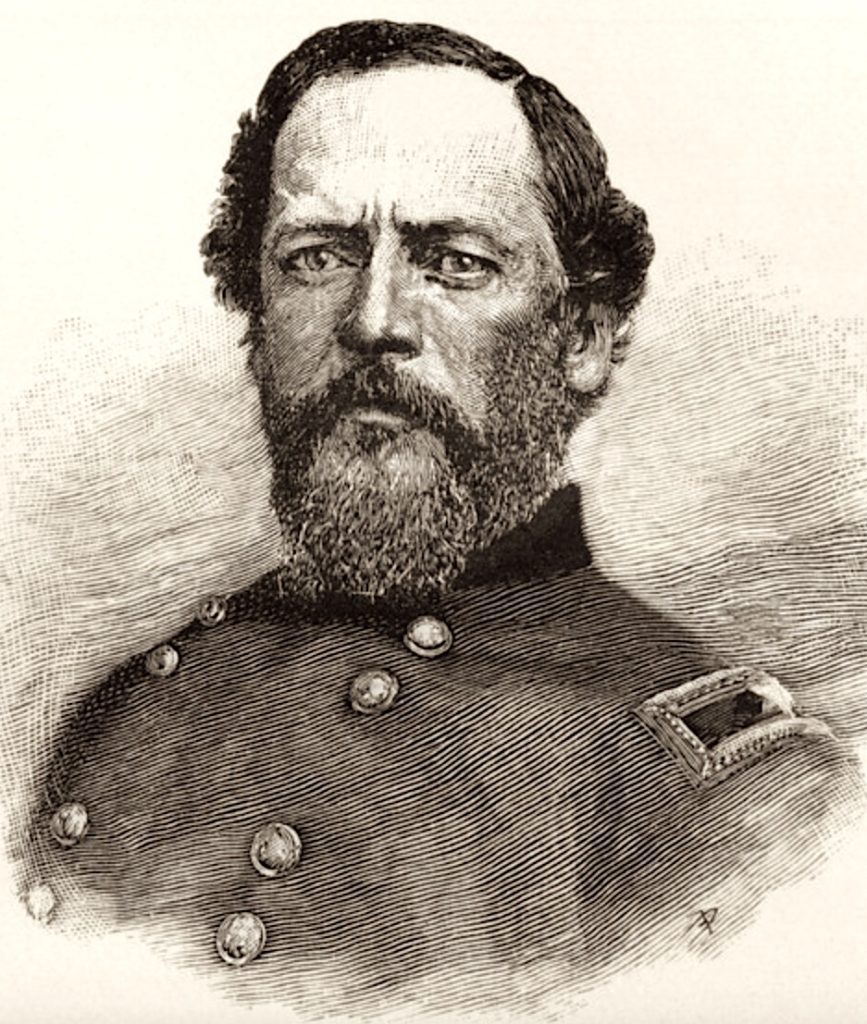



ZULAVSKY, LADISLAS (or LADISHAS, LASZLO) LOUIS (1837-1884). Colonel, 82nd United States Colored Troops (USCT), Company I. Zulavsky, a native of Poland, was the son of Sigismund and Emilia Zulavsky (originally Zsulavsky), the brother-in-law of Louis Kossuth, the Hungarian leader who led an unsuccessful uprising against Austria in 1848-49. The Zulavskys immigrated to the United States from Hungary in 1852, with Ladislas arriving later while continuing his studies abroad. His mother ran a boardinghouse and divorced his father sometime before 1860. After his mother’s death in 1860, he and his brother, Emil, went to Italy to join the Hungarian Legion in Italy, during Giuseppe’s Garibaldi’s campaign for the unification of that country. He was retained as an officer in the newly formed Kingdom of Italy, serving with other expatriates until December 1862.
Roger Hunt included Zulavsky and details of his service in his latest book in his “Colonels in Blue” series, subtitled, U.S. Colored Troops, U.S. Armed forces, Staff Officers and Special Units (McFarland Press). As per Hunt, Zulavsky was a civil engineer before his Civil War service. In January 1863, Zulavsky offered his services to the Union Army. He joined the staff of General Alexander Asboth, a fellow Hungarian and friend of Kossuth, at Columbus, Kentucky. At the time, recruitment was underway for the United States Colored troops (USCT). Ladislas Zulavsky served as a private before serving as lieutenant colonel of the 82nd USCT. He was later promoted to colonel of that regiment. Stephen Beszedits, who presented a paper on The Kossuth Sisters and Their Families in America at the 2012 Conference of American Hungarian Educators at Long Island University, reported that Zulavsky treated all races under his command with equality and fairness. Zulavsky told his men, “The eyes of the world are upon you – to you the friends of your long-oppressed race look for the proof of that manliness which they hold to be just as much your gift from Almighty God as that of any white man.”
The 82nd spent time in Florida, defeating locals in Marianna, the seat of Jackson County, in 1864. The unit was dispatched to Mobile Bay, as part of the “Column from Pensacola,” with the 82nd entrusted to take Fort Blakely. As per Roger Hunt, Zulavsky commanded the 1st Brigade, District of West Florida, Department of the Gulf, from August through November 1864. He then led the 3rd Brigade, 1st Division, U. S. Colored Troops, Military Division of West Mississippi, in March 1865. In April and May of 1865, he led the 1st Brigade, 1st Division, USCT, Military Division of West Mississippi. Subsequently, he commanded the Post of Apalachicola, District of West Florida from May until August 1865. He then commanded the Sub-District of Key West in October 1865. Last, Zulavsky commanded the Post of Pensacola Harbor, Department of Florida, from November 1865 through June 1866. He mustered out with high honors on September 10, 1866.
According to Beszedits, Ladislas’s long-lost father, Sigismund, had traveled South after divorcing his wife, fought for the Confederacy as an officer on the staff of General Jeb Stuart, and was killed after being struck by a locomotive in a rail yard where he was working in March 1882.
After the War, Ladislas engaged in the cotton trade, first in Augusta, Georgia, but he suffered mental problems when the business floundered, returned to New York, and was institutionalized in 1883. He was a member of the Loyal Legion, New York Commandery. His brother, Sigismund Zulavsky (see), also served in the 82nd USCT. Ladislas’s name is displayed on the African American Civil War Memorial in Washington, D.C., plaque C-89. He died in Middletown, New York, at the State Asylum for the Insane. Section 71, lot 825, grave 38.
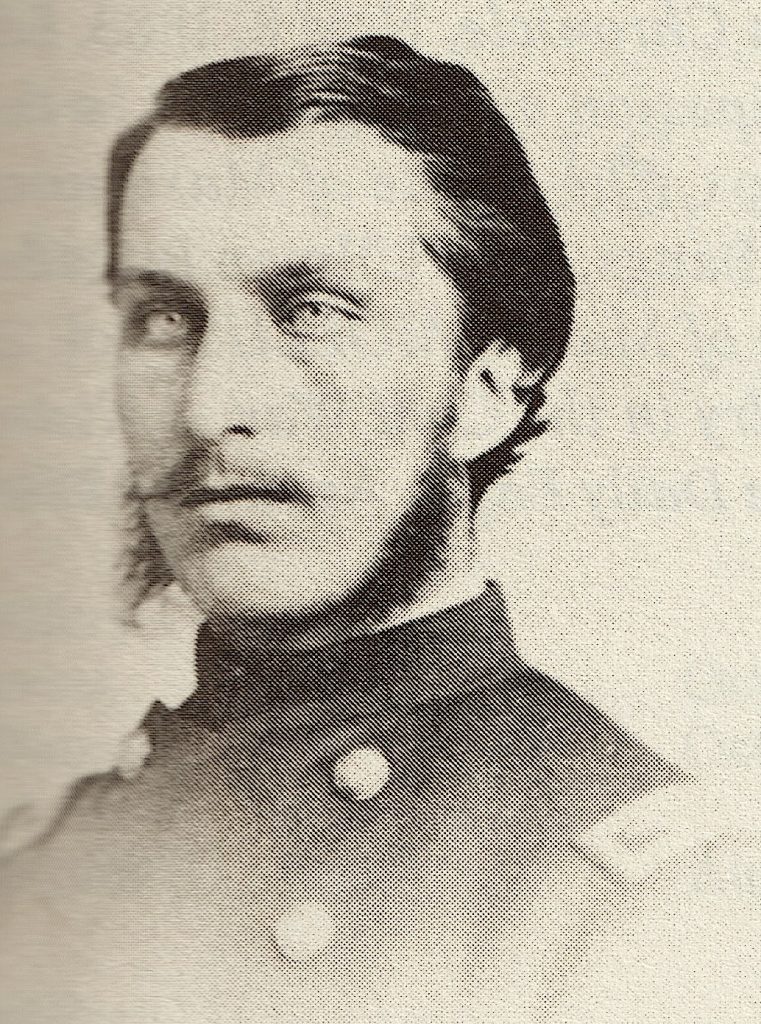
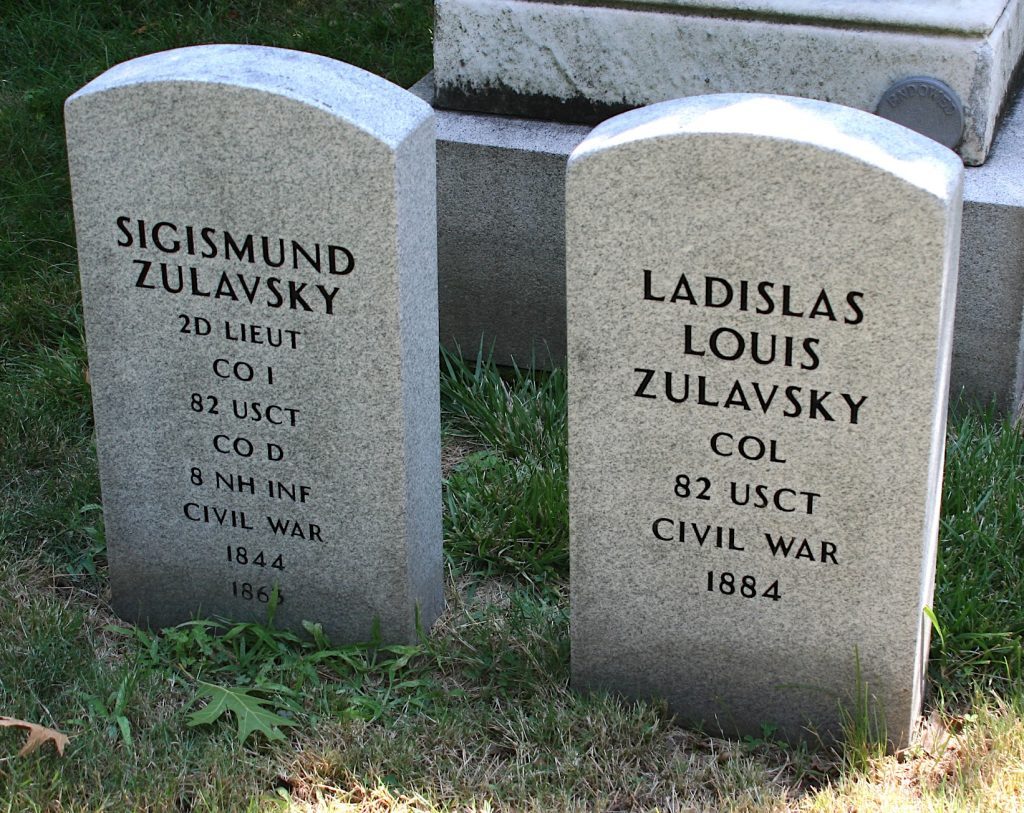
ZULAVSKY, JR., SIGISMUND (or ZYGMUNT) (1844-1863). Second lieutenant, 82nd United States Colored Troops (USCT), Company I; private, 8th New Hampshire Infantry, Company D. Born in Godova, Poland, his mother was the sister of Louis Kossuth, who led the ill-fated Hungarian uprising against Austria in 1848-49. The family came to the United States from Hungary in July 1852 aboard the steamer Humboldt departing at Southampton, England, for New York City, while Ladislas remained behind in Europe for a while to complete his studies. After his parents divorced, his mother, Emilia, established a boarding house in Brooklyn, and welcomed Hungarian exiles and admirers of Kossuth. She died in 1860 and was buried with a bracelet fashioned from an iron chain that had bound Kossuth in an Austrian prison.
During the Civil War, Zulavsky enlisted as a private at Sanbornton, New Hampshire, on December 3, 1861, and mustered into the 8th New Hampshire on December 20 of that year. After he was discharged for promotion on April 4, 1863, he was commissioned into the 82nd USCT as a second lieutenant on or about September 1, 1863, and died from typhoid fever on September 16, 1863, at Fort Hudson, Louisiana. He was the brother of Ladislas Zulavsky (see). His name is displayed on the African American Civil War Memorial in Washington, D.C., plaque C-89. He was interred at Green-Wood, next to his mother, on February, 1864. Section 71, lot 825, grave 36.
